Stormwater Management in Darwin Harbour
VerifiedAdded on 2020/11/23
|35
|11010
|121
Report
AI Summary
This assignment delves into the challenges of stormwater runoff and its effects on Darwin Harbour's water quality. It examines various management strategies, including bioretention systems, grass swales, and constructed wetlands, as outlined in reports such as the 'Darwin Harbour Water Quality Protection Plan'. The assignment also highlights illustrations showcasing stormwater impacts and management techniques.
Contribute Materials
Your contribution can guide someone’s learning journey. Share your
documents today.
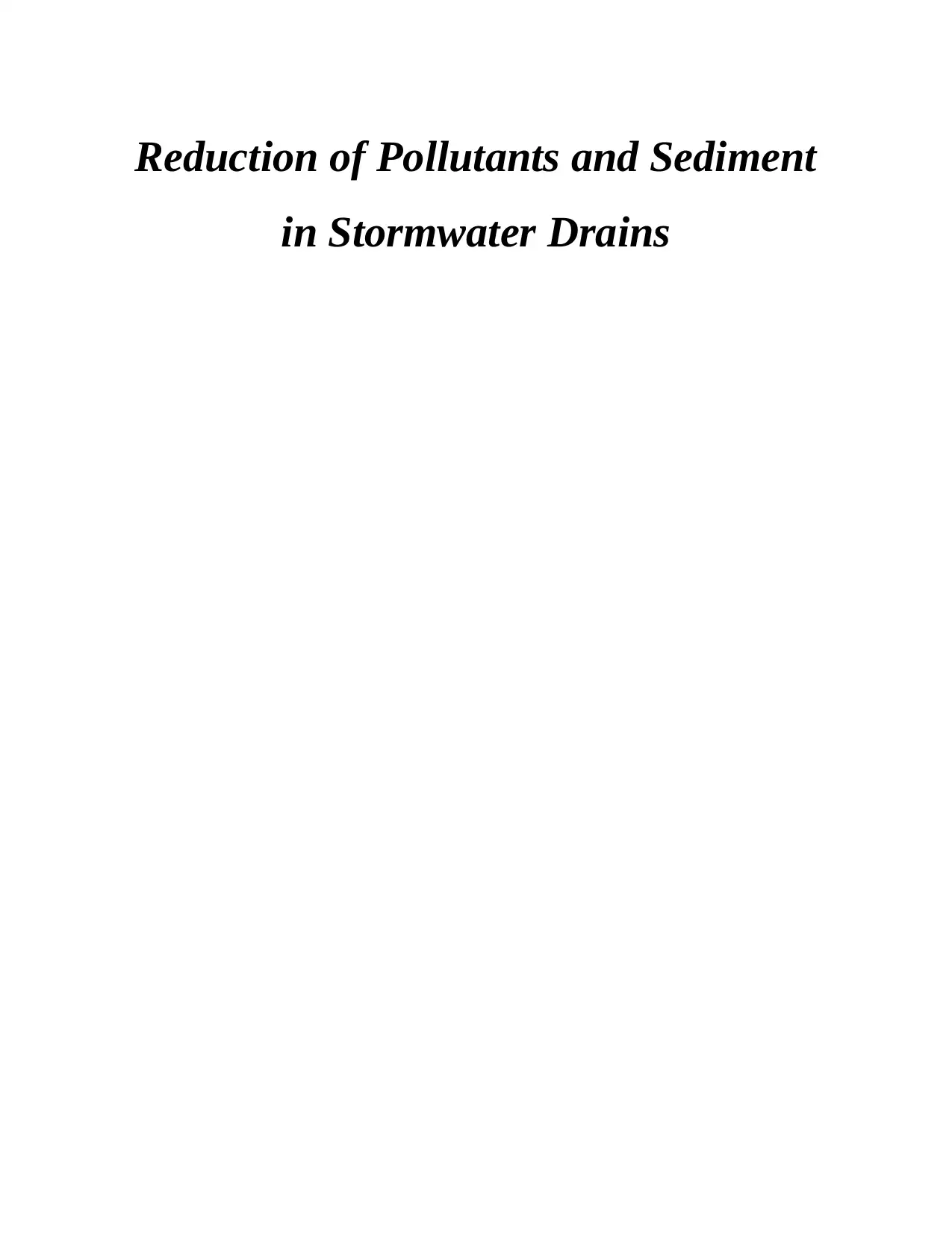
Reduction of Pollutants and Sediment
in Stormwater Drains
in Stormwater Drains
Secure Best Marks with AI Grader
Need help grading? Try our AI Grader for instant feedback on your assignments.
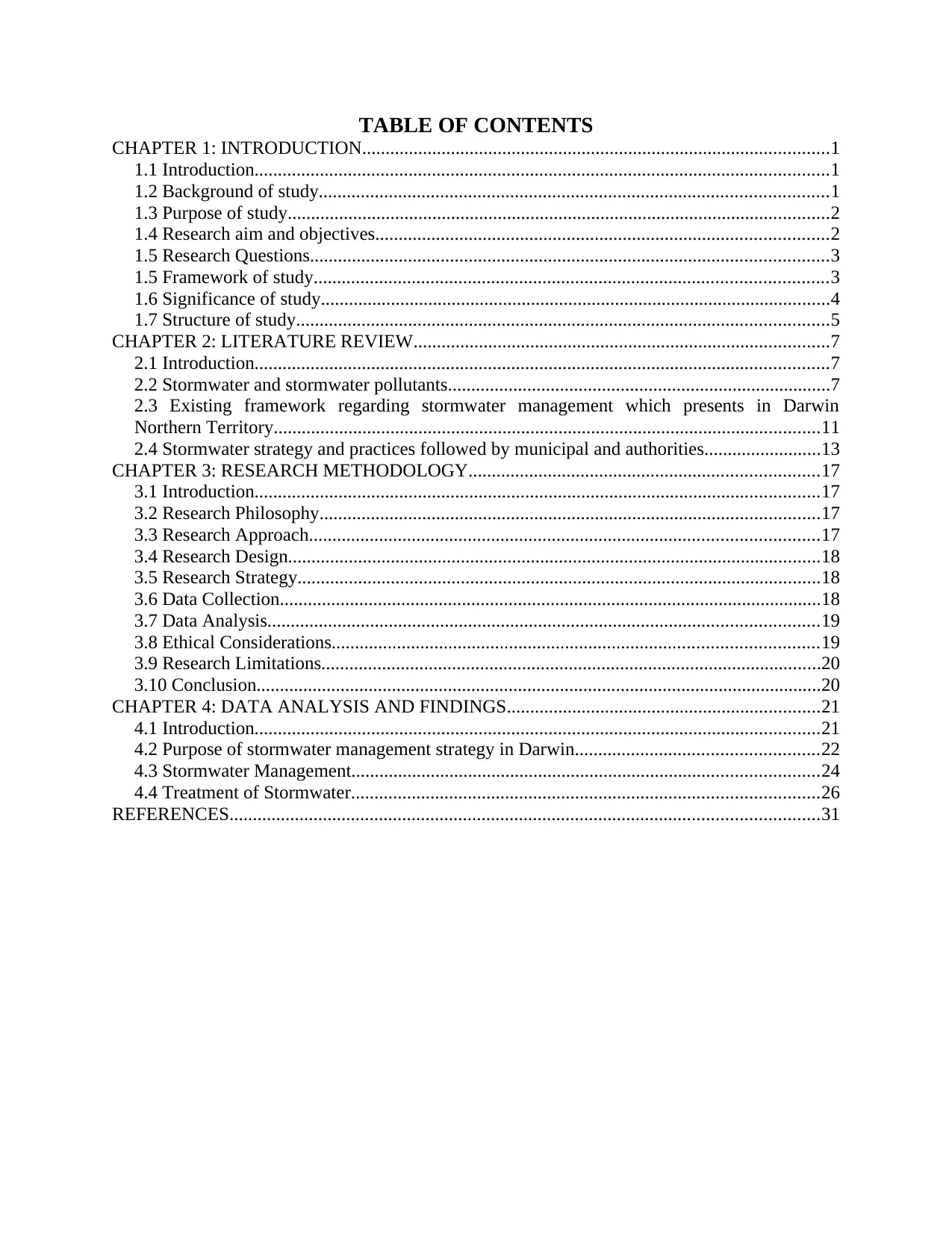
TABLE OF CONTENTS
CHAPTER 1: INTRODUCTION....................................................................................................1
1.1 Introduction...........................................................................................................................1
1.2 Background of study.............................................................................................................1
1.3 Purpose of study....................................................................................................................2
1.4 Research aim and objectives.................................................................................................2
1.5 Research Questions...............................................................................................................3
1.5 Framework of study..............................................................................................................3
1.6 Significance of study.............................................................................................................4
1.7 Structure of study..................................................................................................................5
CHAPTER 2: LITERATURE REVIEW.........................................................................................7
2.1 Introduction...........................................................................................................................7
2.2 Stormwater and stormwater pollutants..................................................................................7
2.3 Existing framework regarding stormwater management which presents in Darwin
Northern Territory.....................................................................................................................11
2.4 Stormwater strategy and practices followed by municipal and authorities.........................13
CHAPTER 3: RESEARCH METHODOLOGY...........................................................................17
3.1 Introduction.........................................................................................................................17
3.2 Research Philosophy...........................................................................................................17
3.3 Research Approach.............................................................................................................17
3.4 Research Design..................................................................................................................18
3.5 Research Strategy................................................................................................................18
3.6 Data Collection....................................................................................................................18
3.7 Data Analysis......................................................................................................................19
3.8 Ethical Considerations........................................................................................................19
3.9 Research Limitations...........................................................................................................20
3.10 Conclusion.........................................................................................................................20
CHAPTER 4: DATA ANALYSIS AND FINDINGS...................................................................21
4.1 Introduction.........................................................................................................................21
4.2 Purpose of stormwater management strategy in Darwin....................................................22
4.3 Stormwater Management....................................................................................................24
4.4 Treatment of Stormwater....................................................................................................26
REFERENCES..............................................................................................................................31
CHAPTER 1: INTRODUCTION....................................................................................................1
1.1 Introduction...........................................................................................................................1
1.2 Background of study.............................................................................................................1
1.3 Purpose of study....................................................................................................................2
1.4 Research aim and objectives.................................................................................................2
1.5 Research Questions...............................................................................................................3
1.5 Framework of study..............................................................................................................3
1.6 Significance of study.............................................................................................................4
1.7 Structure of study..................................................................................................................5
CHAPTER 2: LITERATURE REVIEW.........................................................................................7
2.1 Introduction...........................................................................................................................7
2.2 Stormwater and stormwater pollutants..................................................................................7
2.3 Existing framework regarding stormwater management which presents in Darwin
Northern Territory.....................................................................................................................11
2.4 Stormwater strategy and practices followed by municipal and authorities.........................13
CHAPTER 3: RESEARCH METHODOLOGY...........................................................................17
3.1 Introduction.........................................................................................................................17
3.2 Research Philosophy...........................................................................................................17
3.3 Research Approach.............................................................................................................17
3.4 Research Design..................................................................................................................18
3.5 Research Strategy................................................................................................................18
3.6 Data Collection....................................................................................................................18
3.7 Data Analysis......................................................................................................................19
3.8 Ethical Considerations........................................................................................................19
3.9 Research Limitations...........................................................................................................20
3.10 Conclusion.........................................................................................................................20
CHAPTER 4: DATA ANALYSIS AND FINDINGS...................................................................21
4.1 Introduction.........................................................................................................................21
4.2 Purpose of stormwater management strategy in Darwin....................................................22
4.3 Stormwater Management....................................................................................................24
4.4 Treatment of Stormwater....................................................................................................26
REFERENCES..............................................................................................................................31

CHAPTER 1: INTRODUCTION
1.1 Introduction
Clean storm water assists in keeping creeks, rivers, lakes, beaches and oceans healthy. In
order to keep the stormwater clean, it is important to reduce the level of emission of dust and
other pollutants in the environment. Keeping storm water clean also gives new opportunities for
harvesting and reuse of stormwater. This further assists in protecting the precious water and
reserves. By reducing the litter and pollution to wash off site, construction and building industry
can contribute greatly in preserving the quality of stormwater. As an unprotected building site
runs a high risk of sediment and other pollution including soil, sand, gravel, concrete washings,
litter, spilled fuel and paint entering the storm water system, there is high risk of degradation of
stormwater. In the present era, stormwater becomes one of the major reasons of pollution as it
channels through gutters, street drains and pipes which collect and transport rainwater to nearest
creeks or rivers. This water is not treated to remove litter, debris and other pollution before it
reaches the waterways. Thus, this raises the pollution level in sea water and results in depleting
the natural resources and coral reefs. Without precise management, urban development in
Darwin region negatively impact on urban water cycle and health of the region.
In order to improve quality of stormwater which enters in the Darwin Harbour,
government formulated precise and various strategies to reduce pollutants and sediment in
stormwater. In this context, the present study will focus on identifying and analysing ways and
strategies devised by authorities and government in order to reduce pollutants, dirt and sediments
entering in stormwater which circulates in the river and channels. Investigator will carry out
secondary research analysis in order to attain the aim and objectives of study. Research methods
will be described in thesis so that readers could know about the way researcher carries out entire
study. From extensive research, investigator investigates deeply the reason for increasing
pollutants entering in stormwater, the ways in which stormwater carry forward litter and
sediments and strategies formulated by authorities to eradicate the issue and clean stormwater.
1.2 Background of study
Researchers in previous studies identified broad approach to the development of
stormwater management scheme which is outlined in Urban Stormwater: Best Practice
Environmental Management Guidelines. Researchers further study various aspects because of
1
1.1 Introduction
Clean storm water assists in keeping creeks, rivers, lakes, beaches and oceans healthy. In
order to keep the stormwater clean, it is important to reduce the level of emission of dust and
other pollutants in the environment. Keeping storm water clean also gives new opportunities for
harvesting and reuse of stormwater. This further assists in protecting the precious water and
reserves. By reducing the litter and pollution to wash off site, construction and building industry
can contribute greatly in preserving the quality of stormwater. As an unprotected building site
runs a high risk of sediment and other pollution including soil, sand, gravel, concrete washings,
litter, spilled fuel and paint entering the storm water system, there is high risk of degradation of
stormwater. In the present era, stormwater becomes one of the major reasons of pollution as it
channels through gutters, street drains and pipes which collect and transport rainwater to nearest
creeks or rivers. This water is not treated to remove litter, debris and other pollution before it
reaches the waterways. Thus, this raises the pollution level in sea water and results in depleting
the natural resources and coral reefs. Without precise management, urban development in
Darwin region negatively impact on urban water cycle and health of the region.
In order to improve quality of stormwater which enters in the Darwin Harbour,
government formulated precise and various strategies to reduce pollutants and sediment in
stormwater. In this context, the present study will focus on identifying and analysing ways and
strategies devised by authorities and government in order to reduce pollutants, dirt and sediments
entering in stormwater which circulates in the river and channels. Investigator will carry out
secondary research analysis in order to attain the aim and objectives of study. Research methods
will be described in thesis so that readers could know about the way researcher carries out entire
study. From extensive research, investigator investigates deeply the reason for increasing
pollutants entering in stormwater, the ways in which stormwater carry forward litter and
sediments and strategies formulated by authorities to eradicate the issue and clean stormwater.
1.2 Background of study
Researchers in previous studies identified broad approach to the development of
stormwater management scheme which is outlined in Urban Stormwater: Best Practice
Environmental Management Guidelines. Researchers further study various aspects because of
1

which the stormwater got contaminated due to wrong practices followed by people and
individuals. In present study, researcher will identify and describe the ways in which
contamination of stormwater can be reduced by reducing the pollutants and sedimentation. It is
essential to keep the stormwater clean as it reaches to creeks and rivers. Contaminated rainwater
could further contaminate creeks, lakes, rivers and even oceans. This can harm the aquatic
animals and habitat which are living in it. Reduction of pollutants in stormwater is equally
important for authorities in order to preserve the natural habitat. In this context, researcher will
carry out extensive research study in order to identify the strategies used by authorities in order
to reduce contamination of stormwater which reaches to Darwin Harbour.
1.3 Purpose of study
The purpose of study is to identify ways through which reduction of pollutants and
sedimentation can be done in stormwater. From this research, researcher will be able to acquire
more precise information regarding the significance of clean stormwater. It allows researcher to
gather data about how it got polluted and what strategies have been formulated in order to stop
the pollution in stormwater. Author will examine every article and journal which are relevant and
shows deeper information about the issues. After that precise strategy will be formulated by the
author in order to synthesis and analyse the articles so that aims and objectives of the study can
be accomplished. The major purpose of conducting research is to obtain information regarding
the ways through which authorities can reduce pollutants and sediments in stormwater drains in
Darwin Northern Territory. From this study author will be able to expand his or her knowledge
level regarding the subject matter. In the end of dissertation, recommendations will be provided
which will further helps the authority in enhancing their current strategies so that the pollutants
and sediments can be reduced in entering in stormwater.
1.4 Research aim and objectives
Aim
The aim of present study is “To analyse the ways to reduce entering of pollutants and
sediments in stormwater drains - A study on Darwin Harbour, Northern Territory”.
Objectives
2
individuals. In present study, researcher will identify and describe the ways in which
contamination of stormwater can be reduced by reducing the pollutants and sedimentation. It is
essential to keep the stormwater clean as it reaches to creeks and rivers. Contaminated rainwater
could further contaminate creeks, lakes, rivers and even oceans. This can harm the aquatic
animals and habitat which are living in it. Reduction of pollutants in stormwater is equally
important for authorities in order to preserve the natural habitat. In this context, researcher will
carry out extensive research study in order to identify the strategies used by authorities in order
to reduce contamination of stormwater which reaches to Darwin Harbour.
1.3 Purpose of study
The purpose of study is to identify ways through which reduction of pollutants and
sedimentation can be done in stormwater. From this research, researcher will be able to acquire
more precise information regarding the significance of clean stormwater. It allows researcher to
gather data about how it got polluted and what strategies have been formulated in order to stop
the pollution in stormwater. Author will examine every article and journal which are relevant and
shows deeper information about the issues. After that precise strategy will be formulated by the
author in order to synthesis and analyse the articles so that aims and objectives of the study can
be accomplished. The major purpose of conducting research is to obtain information regarding
the ways through which authorities can reduce pollutants and sediments in stormwater drains in
Darwin Northern Territory. From this study author will be able to expand his or her knowledge
level regarding the subject matter. In the end of dissertation, recommendations will be provided
which will further helps the authority in enhancing their current strategies so that the pollutants
and sediments can be reduced in entering in stormwater.
1.4 Research aim and objectives
Aim
The aim of present study is “To analyse the ways to reduce entering of pollutants and
sediments in stormwater drains - A study on Darwin Harbour, Northern Territory”.
Objectives
2
Secure Best Marks with AI Grader
Need help grading? Try our AI Grader for instant feedback on your assignments.
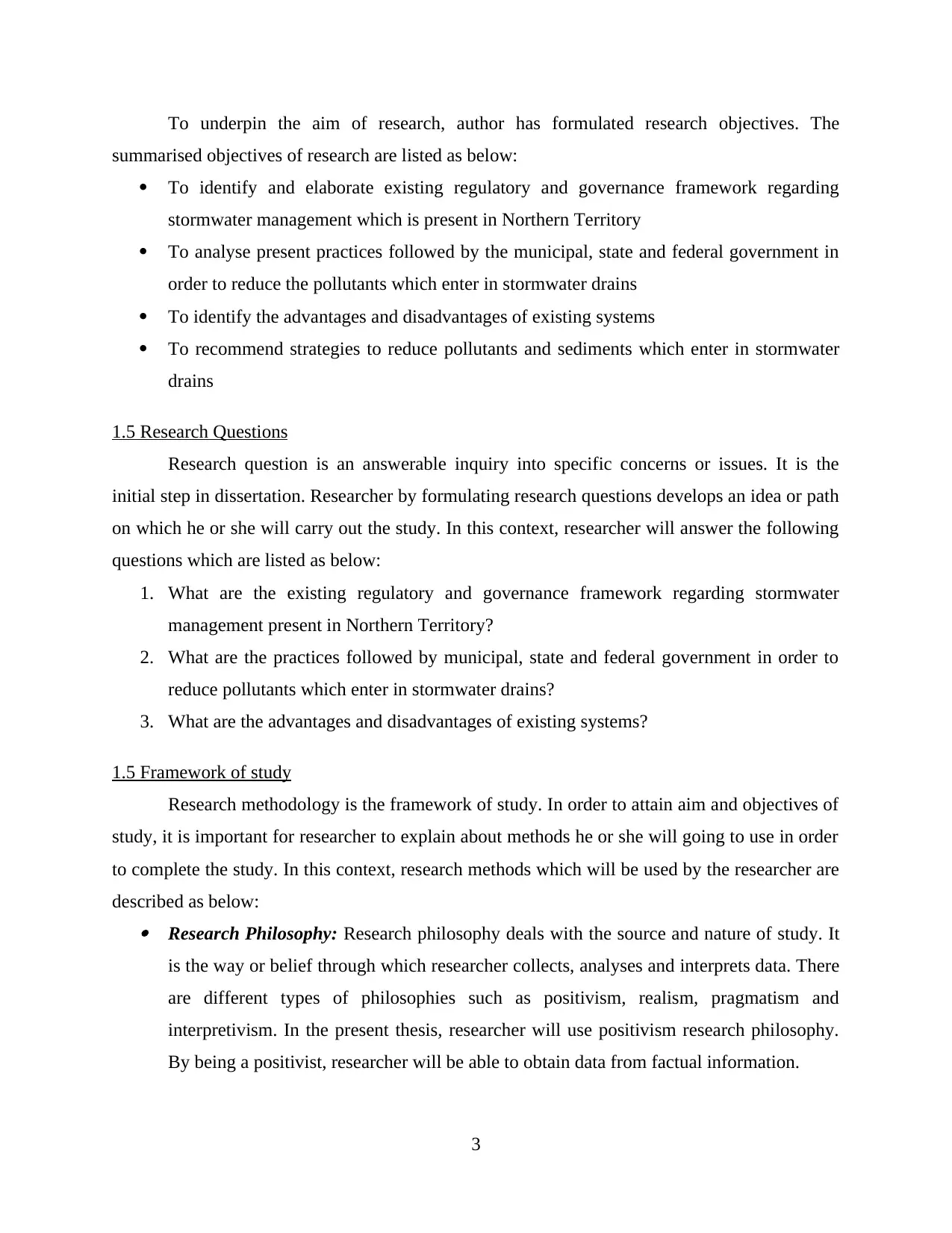
To underpin the aim of research, author has formulated research objectives. The
summarised objectives of research are listed as below:
To identify and elaborate existing regulatory and governance framework regarding
stormwater management which is present in Northern Territory
To analyse present practices followed by the municipal, state and federal government in
order to reduce the pollutants which enter in stormwater drains
To identify the advantages and disadvantages of existing systems
To recommend strategies to reduce pollutants and sediments which enter in stormwater
drains
1.5 Research Questions
Research question is an answerable inquiry into specific concerns or issues. It is the
initial step in dissertation. Researcher by formulating research questions develops an idea or path
on which he or she will carry out the study. In this context, researcher will answer the following
questions which are listed as below:
1. What are the existing regulatory and governance framework regarding stormwater
management present in Northern Territory?
2. What are the practices followed by municipal, state and federal government in order to
reduce pollutants which enter in stormwater drains?
3. What are the advantages and disadvantages of existing systems?
1.5 Framework of study
Research methodology is the framework of study. In order to attain aim and objectives of
study, it is important for researcher to explain about methods he or she will going to use in order
to complete the study. In this context, research methods which will be used by the researcher are
described as below: Research Philosophy: Research philosophy deals with the source and nature of study. It
is the way or belief through which researcher collects, analyses and interprets data. There
are different types of philosophies such as positivism, realism, pragmatism and
interpretivism. In the present thesis, researcher will use positivism research philosophy.
By being a positivist, researcher will be able to obtain data from factual information.
3
summarised objectives of research are listed as below:
To identify and elaborate existing regulatory and governance framework regarding
stormwater management which is present in Northern Territory
To analyse present practices followed by the municipal, state and federal government in
order to reduce the pollutants which enter in stormwater drains
To identify the advantages and disadvantages of existing systems
To recommend strategies to reduce pollutants and sediments which enter in stormwater
drains
1.5 Research Questions
Research question is an answerable inquiry into specific concerns or issues. It is the
initial step in dissertation. Researcher by formulating research questions develops an idea or path
on which he or she will carry out the study. In this context, researcher will answer the following
questions which are listed as below:
1. What are the existing regulatory and governance framework regarding stormwater
management present in Northern Territory?
2. What are the practices followed by municipal, state and federal government in order to
reduce pollutants which enter in stormwater drains?
3. What are the advantages and disadvantages of existing systems?
1.5 Framework of study
Research methodology is the framework of study. In order to attain aim and objectives of
study, it is important for researcher to explain about methods he or she will going to use in order
to complete the study. In this context, research methods which will be used by the researcher are
described as below: Research Philosophy: Research philosophy deals with the source and nature of study. It
is the way or belief through which researcher collects, analyses and interprets data. There
are different types of philosophies such as positivism, realism, pragmatism and
interpretivism. In the present thesis, researcher will use positivism research philosophy.
By being a positivist, researcher will be able to obtain data from factual information.
3
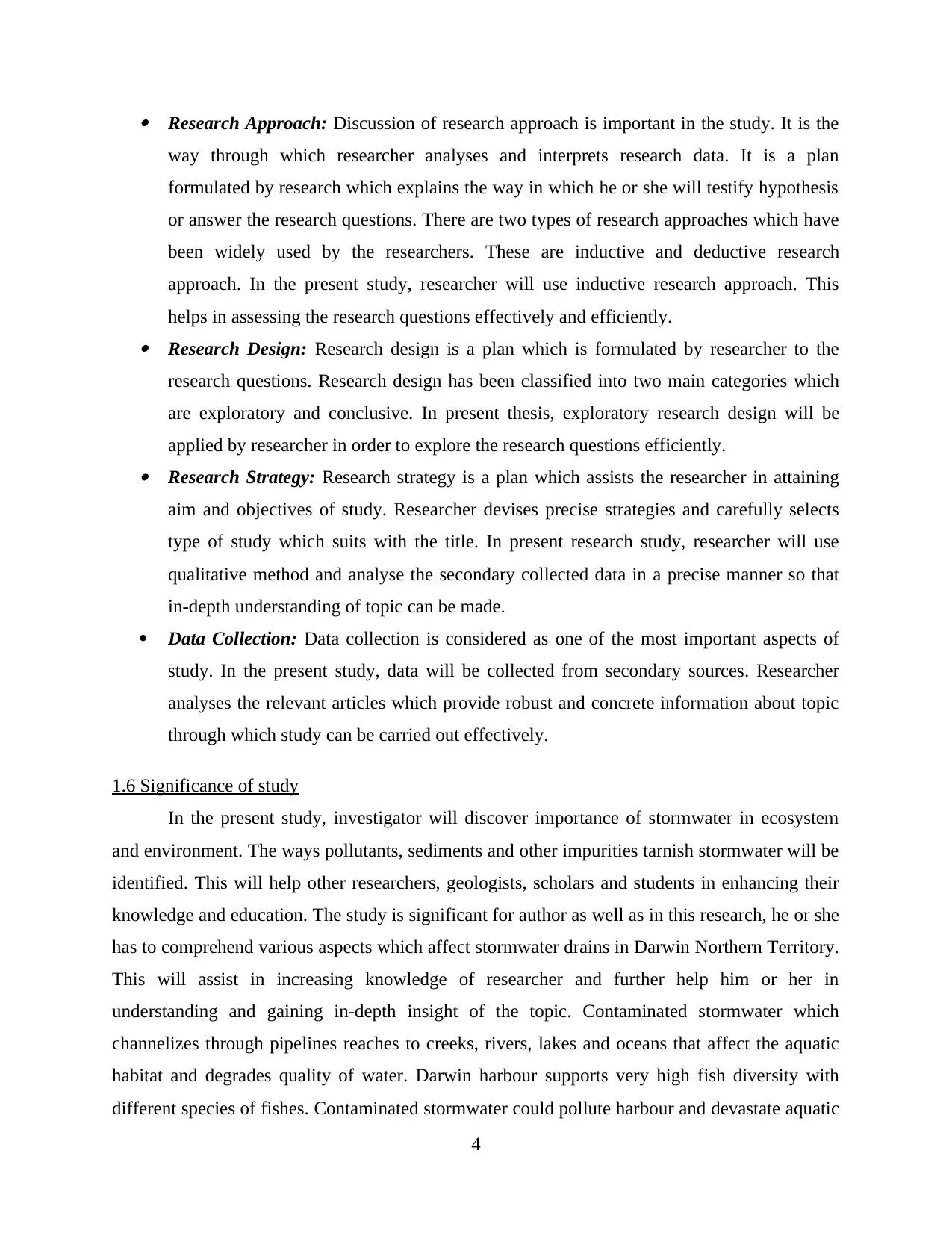
Research Approach: Discussion of research approach is important in the study. It is the
way through which researcher analyses and interprets research data. It is a plan
formulated by research which explains the way in which he or she will testify hypothesis
or answer the research questions. There are two types of research approaches which have
been widely used by the researchers. These are inductive and deductive research
approach. In the present study, researcher will use inductive research approach. This
helps in assessing the research questions effectively and efficiently. Research Design: Research design is a plan which is formulated by researcher to the
research questions. Research design has been classified into two main categories which
are exploratory and conclusive. In present thesis, exploratory research design will be
applied by researcher in order to explore the research questions efficiently. Research Strategy: Research strategy is a plan which assists the researcher in attaining
aim and objectives of study. Researcher devises precise strategies and carefully selects
type of study which suits with the title. In present research study, researcher will use
qualitative method and analyse the secondary collected data in a precise manner so that
in-depth understanding of topic can be made.
Data Collection: Data collection is considered as one of the most important aspects of
study. In the present study, data will be collected from secondary sources. Researcher
analyses the relevant articles which provide robust and concrete information about topic
through which study can be carried out effectively.
1.6 Significance of study
In the present study, investigator will discover importance of stormwater in ecosystem
and environment. The ways pollutants, sediments and other impurities tarnish stormwater will be
identified. This will help other researchers, geologists, scholars and students in enhancing their
knowledge and education. The study is significant for author as well as in this research, he or she
has to comprehend various aspects which affect stormwater drains in Darwin Northern Territory.
This will assist in increasing knowledge of researcher and further help him or her in
understanding and gaining in-depth insight of the topic. Contaminated stormwater which
channelizes through pipelines reaches to creeks, rivers, lakes and oceans that affect the aquatic
habitat and degrades quality of water. Darwin harbour supports very high fish diversity with
different species of fishes. Contaminated stormwater could pollute harbour and devastate aquatic
4
way through which researcher analyses and interprets research data. It is a plan
formulated by research which explains the way in which he or she will testify hypothesis
or answer the research questions. There are two types of research approaches which have
been widely used by the researchers. These are inductive and deductive research
approach. In the present study, researcher will use inductive research approach. This
helps in assessing the research questions effectively and efficiently. Research Design: Research design is a plan which is formulated by researcher to the
research questions. Research design has been classified into two main categories which
are exploratory and conclusive. In present thesis, exploratory research design will be
applied by researcher in order to explore the research questions efficiently. Research Strategy: Research strategy is a plan which assists the researcher in attaining
aim and objectives of study. Researcher devises precise strategies and carefully selects
type of study which suits with the title. In present research study, researcher will use
qualitative method and analyse the secondary collected data in a precise manner so that
in-depth understanding of topic can be made.
Data Collection: Data collection is considered as one of the most important aspects of
study. In the present study, data will be collected from secondary sources. Researcher
analyses the relevant articles which provide robust and concrete information about topic
through which study can be carried out effectively.
1.6 Significance of study
In the present study, investigator will discover importance of stormwater in ecosystem
and environment. The ways pollutants, sediments and other impurities tarnish stormwater will be
identified. This will help other researchers, geologists, scholars and students in enhancing their
knowledge and education. The study is significant for author as well as in this research, he or she
has to comprehend various aspects which affect stormwater drains in Darwin Northern Territory.
This will assist in increasing knowledge of researcher and further help him or her in
understanding and gaining in-depth insight of the topic. Contaminated stormwater which
channelizes through pipelines reaches to creeks, rivers, lakes and oceans that affect the aquatic
habitat and degrades quality of water. Darwin harbour supports very high fish diversity with
different species of fishes. Contaminated stormwater could pollute harbour and devastate aquatic
4
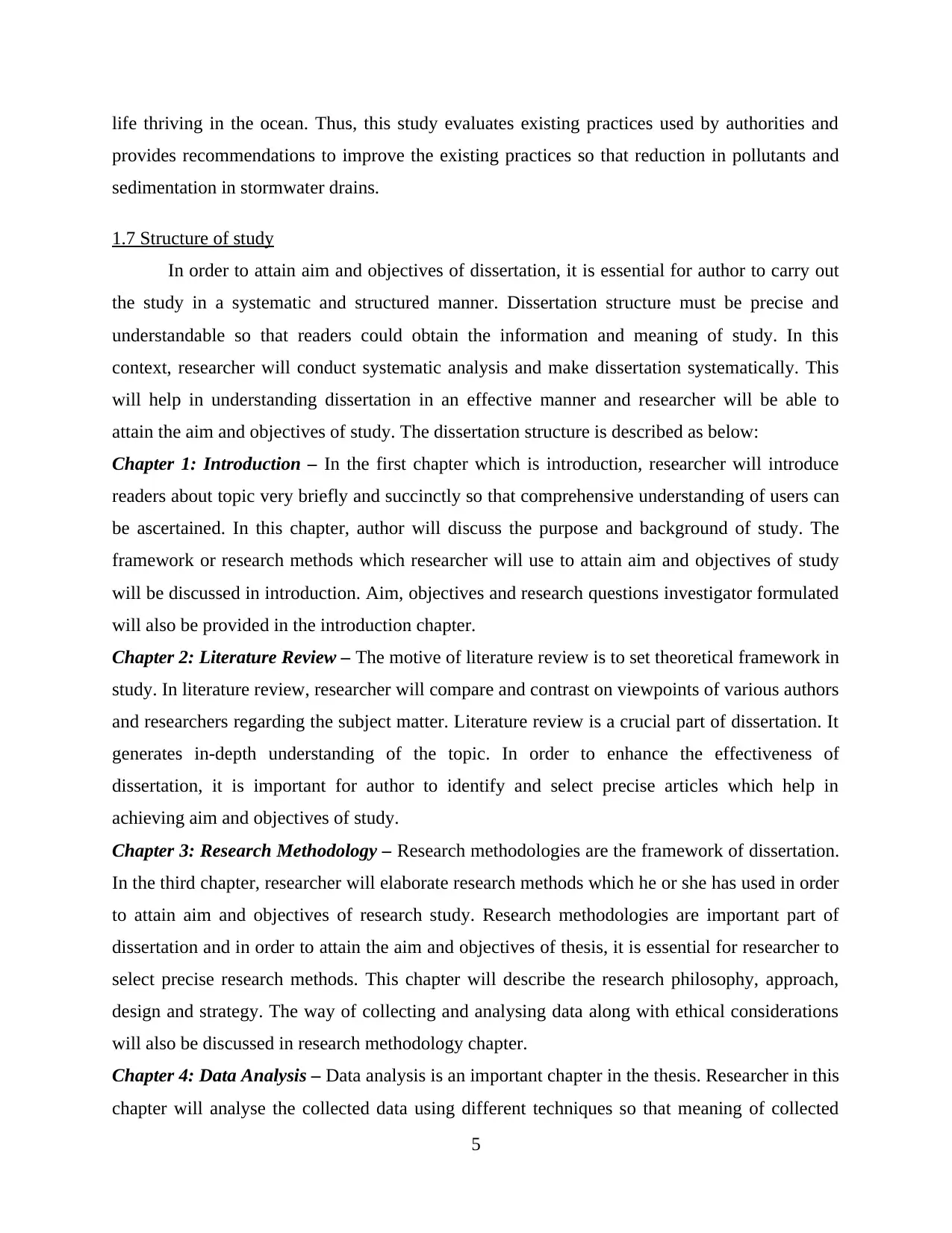
life thriving in the ocean. Thus, this study evaluates existing practices used by authorities and
provides recommendations to improve the existing practices so that reduction in pollutants and
sedimentation in stormwater drains.
1.7 Structure of study
In order to attain aim and objectives of dissertation, it is essential for author to carry out
the study in a systematic and structured manner. Dissertation structure must be precise and
understandable so that readers could obtain the information and meaning of study. In this
context, researcher will conduct systematic analysis and make dissertation systematically. This
will help in understanding dissertation in an effective manner and researcher will be able to
attain the aim and objectives of study. The dissertation structure is described as below:
Chapter 1: Introduction – In the first chapter which is introduction, researcher will introduce
readers about topic very briefly and succinctly so that comprehensive understanding of users can
be ascertained. In this chapter, author will discuss the purpose and background of study. The
framework or research methods which researcher will use to attain aim and objectives of study
will be discussed in introduction. Aim, objectives and research questions investigator formulated
will also be provided in the introduction chapter.
Chapter 2: Literature Review – The motive of literature review is to set theoretical framework in
study. In literature review, researcher will compare and contrast on viewpoints of various authors
and researchers regarding the subject matter. Literature review is a crucial part of dissertation. It
generates in-depth understanding of the topic. In order to enhance the effectiveness of
dissertation, it is important for author to identify and select precise articles which help in
achieving aim and objectives of study.
Chapter 3: Research Methodology – Research methodologies are the framework of dissertation.
In the third chapter, researcher will elaborate research methods which he or she has used in order
to attain aim and objectives of research study. Research methodologies are important part of
dissertation and in order to attain the aim and objectives of thesis, it is essential for researcher to
select precise research methods. This chapter will describe the research philosophy, approach,
design and strategy. The way of collecting and analysing data along with ethical considerations
will also be discussed in research methodology chapter.
Chapter 4: Data Analysis – Data analysis is an important chapter in the thesis. Researcher in this
chapter will analyse the collected data using different techniques so that meaning of collected
5
provides recommendations to improve the existing practices so that reduction in pollutants and
sedimentation in stormwater drains.
1.7 Structure of study
In order to attain aim and objectives of dissertation, it is essential for author to carry out
the study in a systematic and structured manner. Dissertation structure must be precise and
understandable so that readers could obtain the information and meaning of study. In this
context, researcher will conduct systematic analysis and make dissertation systematically. This
will help in understanding dissertation in an effective manner and researcher will be able to
attain the aim and objectives of study. The dissertation structure is described as below:
Chapter 1: Introduction – In the first chapter which is introduction, researcher will introduce
readers about topic very briefly and succinctly so that comprehensive understanding of users can
be ascertained. In this chapter, author will discuss the purpose and background of study. The
framework or research methods which researcher will use to attain aim and objectives of study
will be discussed in introduction. Aim, objectives and research questions investigator formulated
will also be provided in the introduction chapter.
Chapter 2: Literature Review – The motive of literature review is to set theoretical framework in
study. In literature review, researcher will compare and contrast on viewpoints of various authors
and researchers regarding the subject matter. Literature review is a crucial part of dissertation. It
generates in-depth understanding of the topic. In order to enhance the effectiveness of
dissertation, it is important for author to identify and select precise articles which help in
achieving aim and objectives of study.
Chapter 3: Research Methodology – Research methodologies are the framework of dissertation.
In the third chapter, researcher will elaborate research methods which he or she has used in order
to attain aim and objectives of research study. Research methodologies are important part of
dissertation and in order to attain the aim and objectives of thesis, it is essential for researcher to
select precise research methods. This chapter will describe the research philosophy, approach,
design and strategy. The way of collecting and analysing data along with ethical considerations
will also be discussed in research methodology chapter.
Chapter 4: Data Analysis – Data analysis is an important chapter in the thesis. Researcher in this
chapter will analyse the collected data using different techniques so that meaning of collected
5
Paraphrase This Document
Need a fresh take? Get an instant paraphrase of this document with our AI Paraphraser
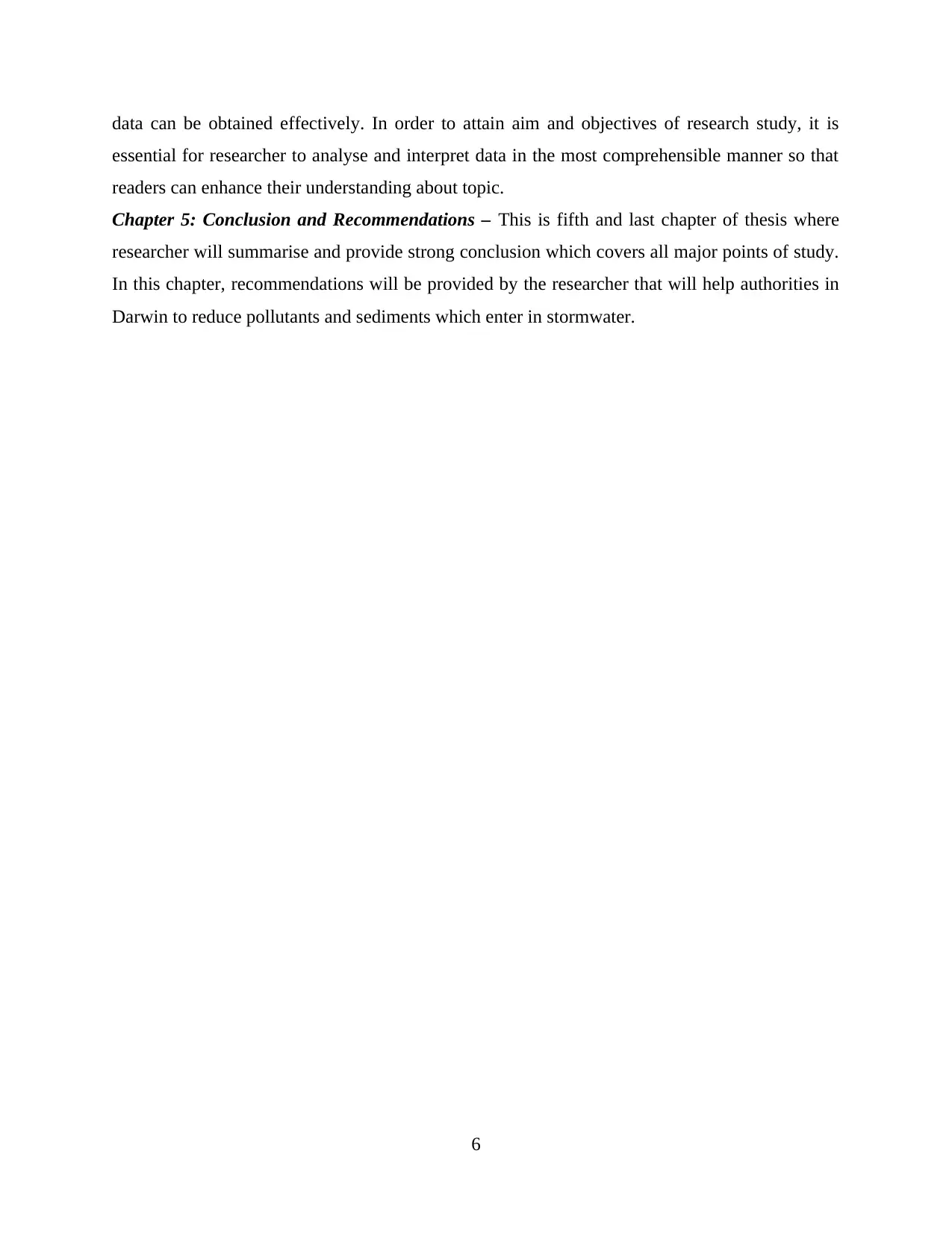
data can be obtained effectively. In order to attain aim and objectives of research study, it is
essential for researcher to analyse and interpret data in the most comprehensible manner so that
readers can enhance their understanding about topic.
Chapter 5: Conclusion and Recommendations – This is fifth and last chapter of thesis where
researcher will summarise and provide strong conclusion which covers all major points of study.
In this chapter, recommendations will be provided by the researcher that will help authorities in
Darwin to reduce pollutants and sediments which enter in stormwater.
6
essential for researcher to analyse and interpret data in the most comprehensible manner so that
readers can enhance their understanding about topic.
Chapter 5: Conclusion and Recommendations – This is fifth and last chapter of thesis where
researcher will summarise and provide strong conclusion which covers all major points of study.
In this chapter, recommendations will be provided by the researcher that will help authorities in
Darwin to reduce pollutants and sediments which enter in stormwater.
6
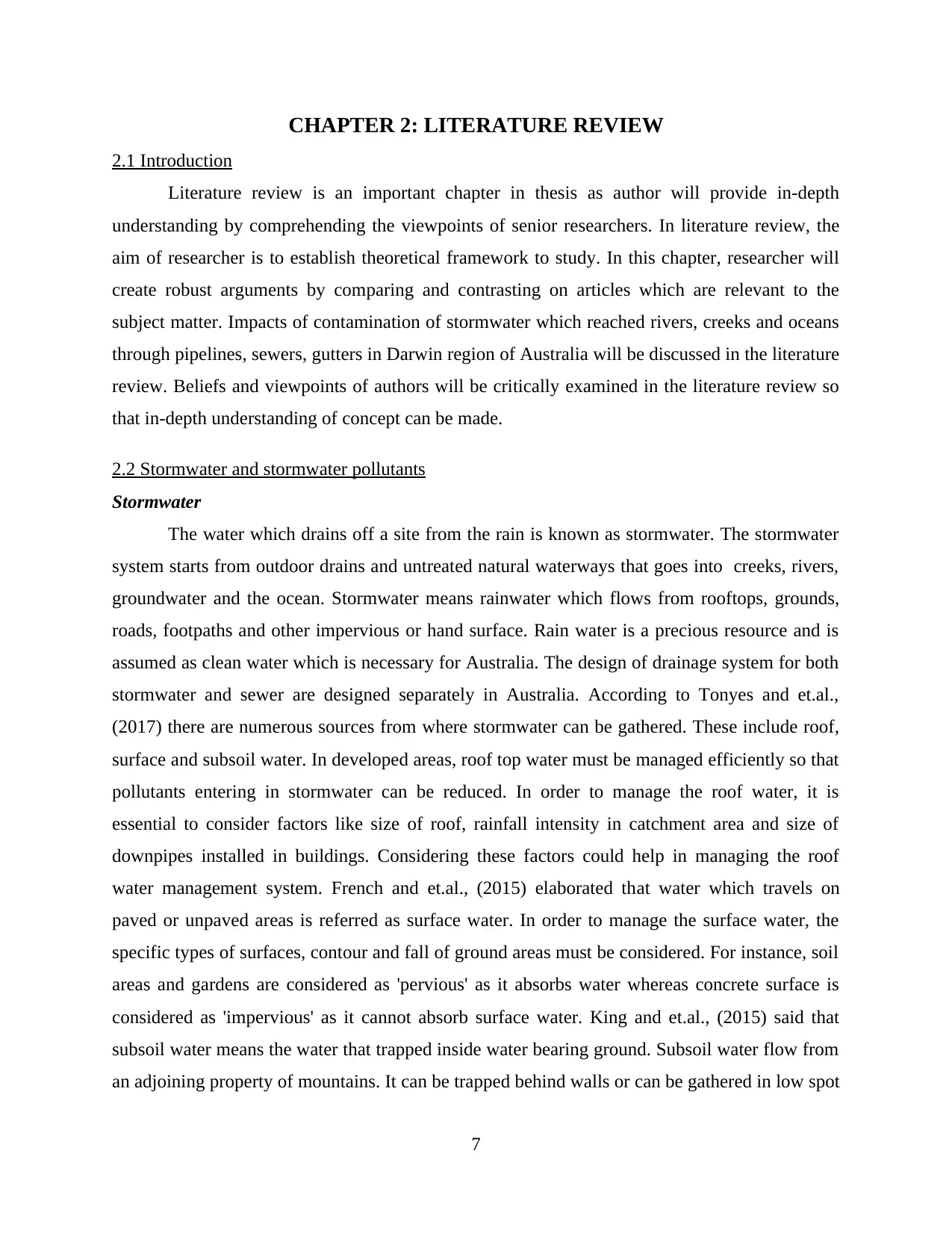
CHAPTER 2: LITERATURE REVIEW
2.1 Introduction
Literature review is an important chapter in thesis as author will provide in-depth
understanding by comprehending the viewpoints of senior researchers. In literature review, the
aim of researcher is to establish theoretical framework to study. In this chapter, researcher will
create robust arguments by comparing and contrasting on articles which are relevant to the
subject matter. Impacts of contamination of stormwater which reached rivers, creeks and oceans
through pipelines, sewers, gutters in Darwin region of Australia will be discussed in the literature
review. Beliefs and viewpoints of authors will be critically examined in the literature review so
that in-depth understanding of concept can be made.
2.2 Stormwater and stormwater pollutants
Stormwater
The water which drains off a site from the rain is known as stormwater. The stormwater
system starts from outdoor drains and untreated natural waterways that goes into creeks, rivers,
groundwater and the ocean. Stormwater means rainwater which flows from rooftops, grounds,
roads, footpaths and other impervious or hand surface. Rain water is a precious resource and is
assumed as clean water which is necessary for Australia. The design of drainage system for both
stormwater and sewer are designed separately in Australia. According to Tonyes and et.al.,
(2017) there are numerous sources from where stormwater can be gathered. These include roof,
surface and subsoil water. In developed areas, roof top water must be managed efficiently so that
pollutants entering in stormwater can be reduced. In order to manage the roof water, it is
essential to consider factors like size of roof, rainfall intensity in catchment area and size of
downpipes installed in buildings. Considering these factors could help in managing the roof
water management system. French and et.al., (2015) elaborated that water which travels on
paved or unpaved areas is referred as surface water. In order to manage the surface water, the
specific types of surfaces, contour and fall of ground areas must be considered. For instance, soil
areas and gardens are considered as 'pervious' as it absorbs water whereas concrete surface is
considered as 'impervious' as it cannot absorb surface water. King and et.al., (2015) said that
subsoil water means the water that trapped inside water bearing ground. Subsoil water flow from
an adjoining property of mountains. It can be trapped behind walls or can be gathered in low spot
7
2.1 Introduction
Literature review is an important chapter in thesis as author will provide in-depth
understanding by comprehending the viewpoints of senior researchers. In literature review, the
aim of researcher is to establish theoretical framework to study. In this chapter, researcher will
create robust arguments by comparing and contrasting on articles which are relevant to the
subject matter. Impacts of contamination of stormwater which reached rivers, creeks and oceans
through pipelines, sewers, gutters in Darwin region of Australia will be discussed in the literature
review. Beliefs and viewpoints of authors will be critically examined in the literature review so
that in-depth understanding of concept can be made.
2.2 Stormwater and stormwater pollutants
Stormwater
The water which drains off a site from the rain is known as stormwater. The stormwater
system starts from outdoor drains and untreated natural waterways that goes into creeks, rivers,
groundwater and the ocean. Stormwater means rainwater which flows from rooftops, grounds,
roads, footpaths and other impervious or hand surface. Rain water is a precious resource and is
assumed as clean water which is necessary for Australia. The design of drainage system for both
stormwater and sewer are designed separately in Australia. According to Tonyes and et.al.,
(2017) there are numerous sources from where stormwater can be gathered. These include roof,
surface and subsoil water. In developed areas, roof top water must be managed efficiently so that
pollutants entering in stormwater can be reduced. In order to manage the roof water, it is
essential to consider factors like size of roof, rainfall intensity in catchment area and size of
downpipes installed in buildings. Considering these factors could help in managing the roof
water management system. French and et.al., (2015) elaborated that water which travels on
paved or unpaved areas is referred as surface water. In order to manage the surface water, the
specific types of surfaces, contour and fall of ground areas must be considered. For instance, soil
areas and gardens are considered as 'pervious' as it absorbs water whereas concrete surface is
considered as 'impervious' as it cannot absorb surface water. King and et.al., (2015) said that
subsoil water means the water that trapped inside water bearing ground. Subsoil water flow from
an adjoining property of mountains. It can be trapped behind walls or can be gathered in low spot
7
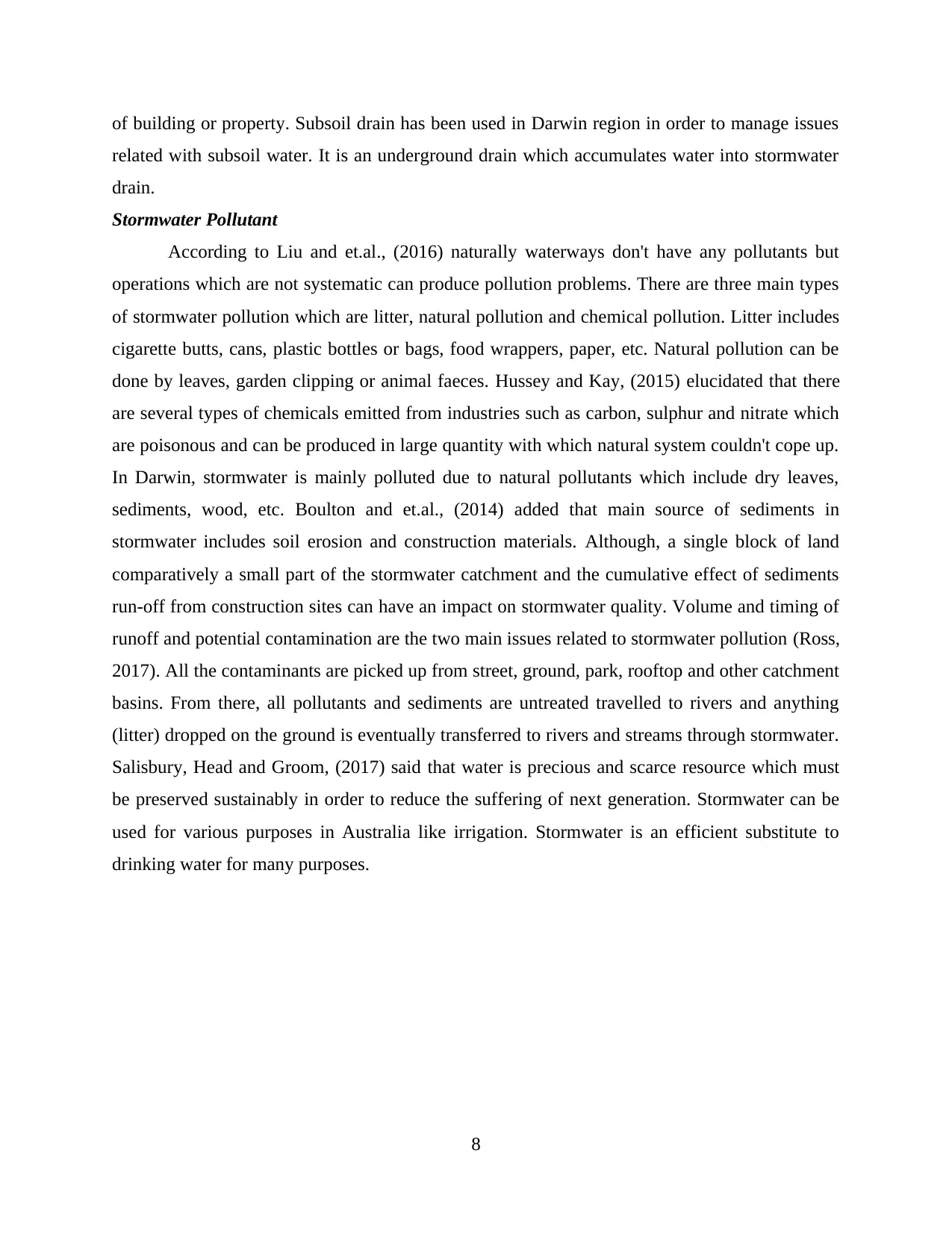
of building or property. Subsoil drain has been used in Darwin region in order to manage issues
related with subsoil water. It is an underground drain which accumulates water into stormwater
drain.
Stormwater Pollutant
According to Liu and et.al., (2016) naturally waterways don't have any pollutants but
operations which are not systematic can produce pollution problems. There are three main types
of stormwater pollution which are litter, natural pollution and chemical pollution. Litter includes
cigarette butts, cans, plastic bottles or bags, food wrappers, paper, etc. Natural pollution can be
done by leaves, garden clipping or animal faeces. Hussey and Kay, (2015) elucidated that there
are several types of chemicals emitted from industries such as carbon, sulphur and nitrate which
are poisonous and can be produced in large quantity with which natural system couldn't cope up.
In Darwin, stormwater is mainly polluted due to natural pollutants which include dry leaves,
sediments, wood, etc. Boulton and et.al., (2014) added that main source of sediments in
stormwater includes soil erosion and construction materials. Although, a single block of land
comparatively a small part of the stormwater catchment and the cumulative effect of sediments
run-off from construction sites can have an impact on stormwater quality. Volume and timing of
runoff and potential contamination are the two main issues related to stormwater pollution (Ross,
2017). All the contaminants are picked up from street, ground, park, rooftop and other catchment
basins. From there, all pollutants and sediments are untreated travelled to rivers and anything
(litter) dropped on the ground is eventually transferred to rivers and streams through stormwater.
Salisbury, Head and Groom, (2017) said that water is precious and scarce resource which must
be preserved sustainably in order to reduce the suffering of next generation. Stormwater can be
used for various purposes in Australia like irrigation. Stormwater is an efficient substitute to
drinking water for many purposes.
8
related with subsoil water. It is an underground drain which accumulates water into stormwater
drain.
Stormwater Pollutant
According to Liu and et.al., (2016) naturally waterways don't have any pollutants but
operations which are not systematic can produce pollution problems. There are three main types
of stormwater pollution which are litter, natural pollution and chemical pollution. Litter includes
cigarette butts, cans, plastic bottles or bags, food wrappers, paper, etc. Natural pollution can be
done by leaves, garden clipping or animal faeces. Hussey and Kay, (2015) elucidated that there
are several types of chemicals emitted from industries such as carbon, sulphur and nitrate which
are poisonous and can be produced in large quantity with which natural system couldn't cope up.
In Darwin, stormwater is mainly polluted due to natural pollutants which include dry leaves,
sediments, wood, etc. Boulton and et.al., (2014) added that main source of sediments in
stormwater includes soil erosion and construction materials. Although, a single block of land
comparatively a small part of the stormwater catchment and the cumulative effect of sediments
run-off from construction sites can have an impact on stormwater quality. Volume and timing of
runoff and potential contamination are the two main issues related to stormwater pollution (Ross,
2017). All the contaminants are picked up from street, ground, park, rooftop and other catchment
basins. From there, all pollutants and sediments are untreated travelled to rivers and anything
(litter) dropped on the ground is eventually transferred to rivers and streams through stormwater.
Salisbury, Head and Groom, (2017) said that water is precious and scarce resource which must
be preserved sustainably in order to reduce the suffering of next generation. Stormwater can be
used for various purposes in Australia like irrigation. Stormwater is an efficient substitute to
drinking water for many purposes.
8
Secure Best Marks with AI Grader
Need help grading? Try our AI Grader for instant feedback on your assignments.

It is not difficult for the authorities to store, manage and acquire stormwater on site. Sage,
Berthier and Gromaire, (2015) said that increased runoff through alteration in land increase the
rate and quantity of runoff from the watershed entering the stream. It impacts negatively as it
displaces pollutants, erodes stream channel and banks as well as destroy in stream habitats.
Eroded sediments from construction area, roads, pathways and parking area enters with
stormwater runoff which ultimately increases flow and thus, causing erosion in stream bank.
Radcliffe, (2015) elucidates that excess of nutrients including fertilisers which are not poisonous
but flow into stormwater runoff and thus, making it contaminated. The contaminated stormwater
eventually flows directly into streams, rivers, lakes and oceans. The downside of contaminated
stormwater is that it stimulates excessive plant growth, decreases level of oxygen, degrades
aesthetics and devastate aquatic life.
9
Illustration 1: Stormwater runoff and associated pollutants
(Source: Trees and Stormwater Runoff, 2018)
Berthier and Gromaire, (2015) said that increased runoff through alteration in land increase the
rate and quantity of runoff from the watershed entering the stream. It impacts negatively as it
displaces pollutants, erodes stream channel and banks as well as destroy in stream habitats.
Eroded sediments from construction area, roads, pathways and parking area enters with
stormwater runoff which ultimately increases flow and thus, causing erosion in stream bank.
Radcliffe, (2015) elucidates that excess of nutrients including fertilisers which are not poisonous
but flow into stormwater runoff and thus, making it contaminated. The contaminated stormwater
eventually flows directly into streams, rivers, lakes and oceans. The downside of contaminated
stormwater is that it stimulates excessive plant growth, decreases level of oxygen, degrades
aesthetics and devastate aquatic life.
9
Illustration 1: Stormwater runoff and associated pollutants
(Source: Trees and Stormwater Runoff, 2018)
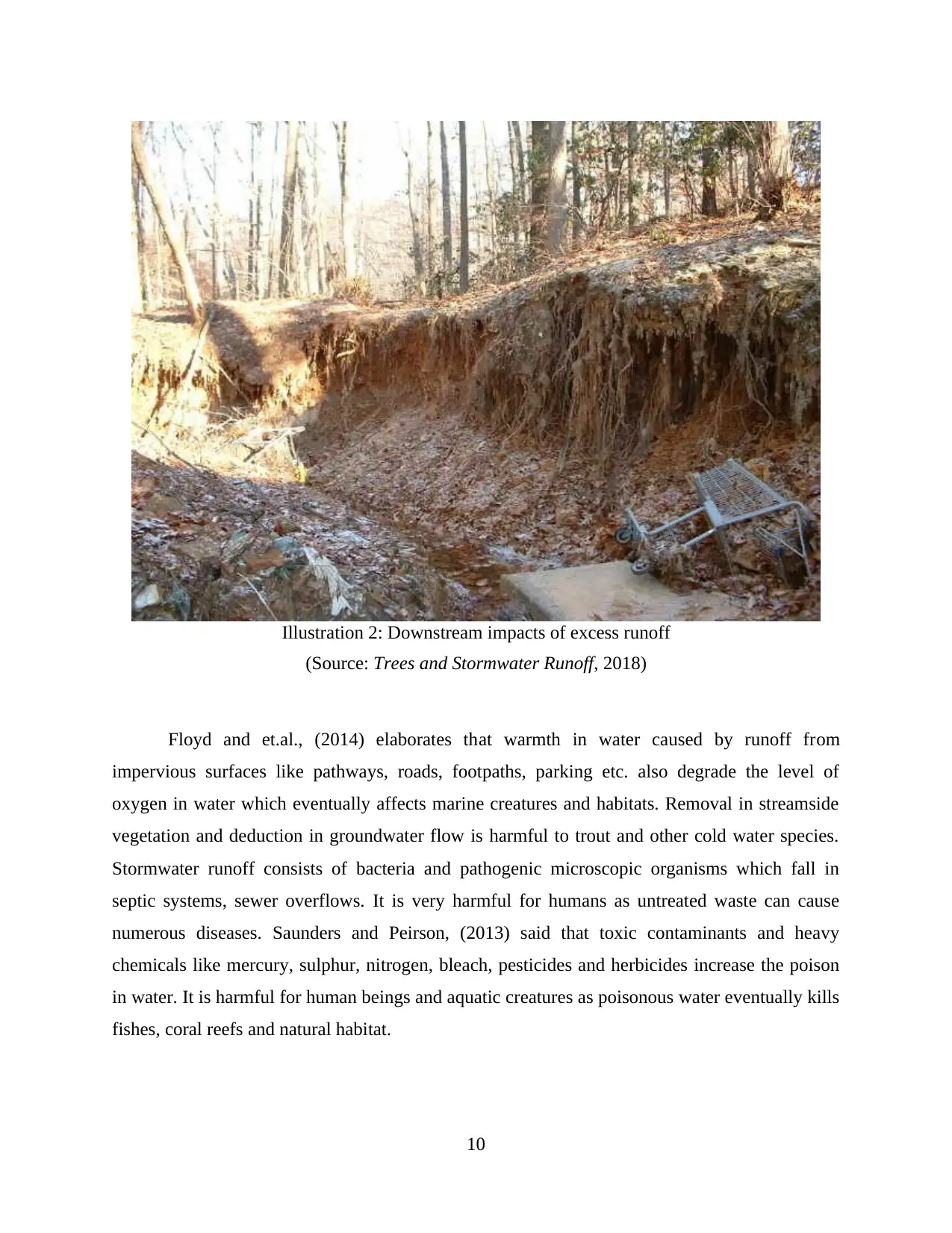
Floyd and et.al., (2014) elaborates that warmth in water caused by runoff from
impervious surfaces like pathways, roads, footpaths, parking etc. also degrade the level of
oxygen in water which eventually affects marine creatures and habitats. Removal in streamside
vegetation and deduction in groundwater flow is harmful to trout and other cold water species.
Stormwater runoff consists of bacteria and pathogenic microscopic organisms which fall in
septic systems, sewer overflows. It is very harmful for humans as untreated waste can cause
numerous diseases. Saunders and Peirson, (2013) said that toxic contaminants and heavy
chemicals like mercury, sulphur, nitrogen, bleach, pesticides and herbicides increase the poison
in water. It is harmful for human beings and aquatic creatures as poisonous water eventually kills
fishes, coral reefs and natural habitat.
10
Illustration 2: Downstream impacts of excess runoff
(Source: Trees and Stormwater Runoff, 2018)
impervious surfaces like pathways, roads, footpaths, parking etc. also degrade the level of
oxygen in water which eventually affects marine creatures and habitats. Removal in streamside
vegetation and deduction in groundwater flow is harmful to trout and other cold water species.
Stormwater runoff consists of bacteria and pathogenic microscopic organisms which fall in
septic systems, sewer overflows. It is very harmful for humans as untreated waste can cause
numerous diseases. Saunders and Peirson, (2013) said that toxic contaminants and heavy
chemicals like mercury, sulphur, nitrogen, bleach, pesticides and herbicides increase the poison
in water. It is harmful for human beings and aquatic creatures as poisonous water eventually kills
fishes, coral reefs and natural habitat.
10
Illustration 2: Downstream impacts of excess runoff
(Source: Trees and Stormwater Runoff, 2018)
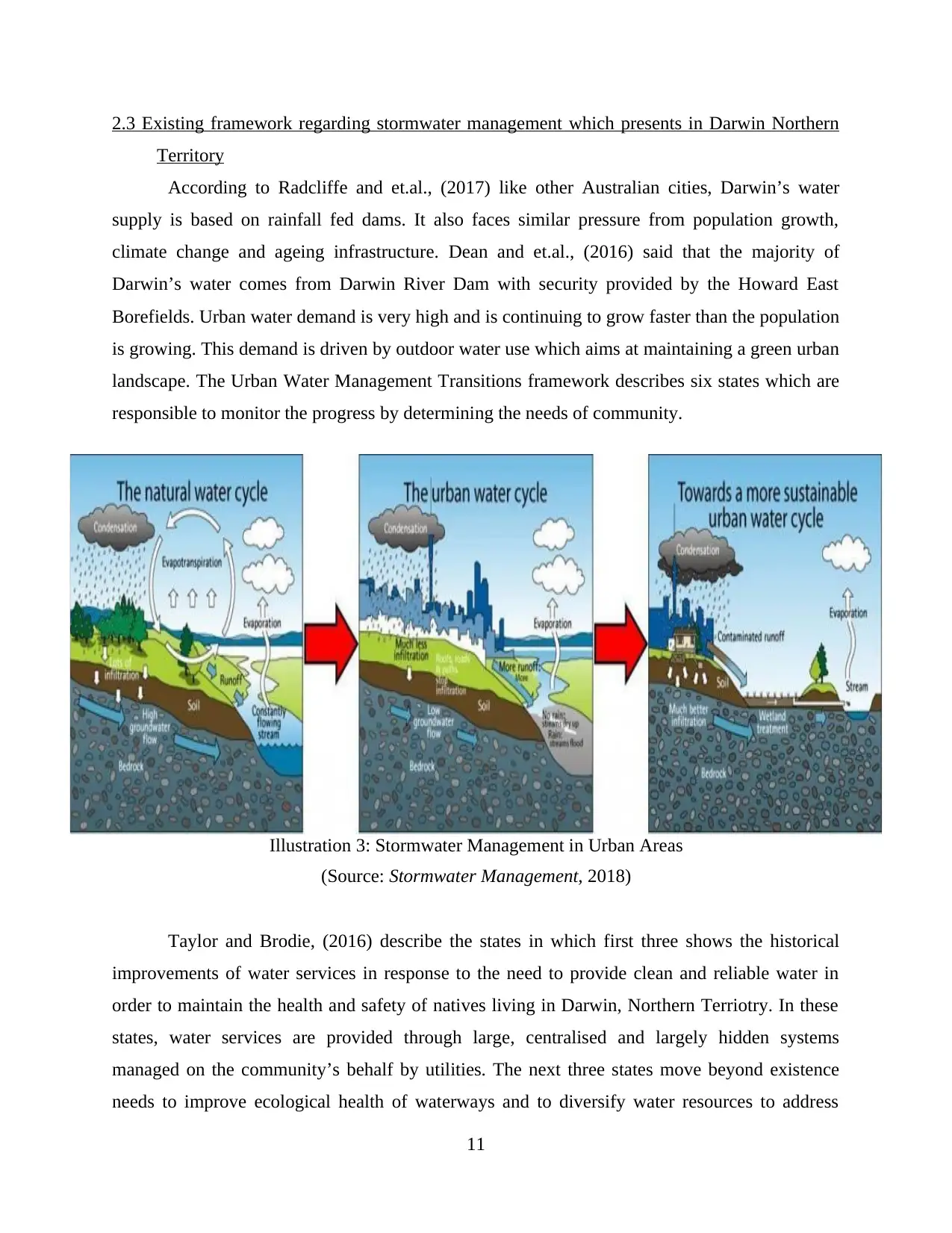
2.3 Existing framework regarding stormwater management which presents in Darwin Northern
Territory
According to Radcliffe and et.al., (2017) like other Australian cities, Darwin’s water
supply is based on rainfall fed dams. It also faces similar pressure from population growth,
climate change and ageing infrastructure. Dean and et.al., (2016) said that the majority of
Darwin’s water comes from Darwin River Dam with security provided by the Howard East
Borefields. Urban water demand is very high and is continuing to grow faster than the population
is growing. This demand is driven by outdoor water use which aims at maintaining a green urban
landscape. The Urban Water Management Transitions framework describes six states which are
responsible to monitor the progress by determining the needs of community.
Taylor and Brodie, (2016) describe the states in which first three shows the historical
improvements of water services in response to the need to provide clean and reliable water in
order to maintain the health and safety of natives living in Darwin, Northern Terriotry. In these
states, water services are provided through large, centralised and largely hidden systems
managed on the community’s behalf by utilities. The next three states move beyond existence
needs to improve ecological health of waterways and to diversify water resources to address
11
Illustration 3: Stormwater Management in Urban Areas
(Source: Stormwater Management, 2018)
Territory
According to Radcliffe and et.al., (2017) like other Australian cities, Darwin’s water
supply is based on rainfall fed dams. It also faces similar pressure from population growth,
climate change and ageing infrastructure. Dean and et.al., (2016) said that the majority of
Darwin’s water comes from Darwin River Dam with security provided by the Howard East
Borefields. Urban water demand is very high and is continuing to grow faster than the population
is growing. This demand is driven by outdoor water use which aims at maintaining a green urban
landscape. The Urban Water Management Transitions framework describes six states which are
responsible to monitor the progress by determining the needs of community.
Taylor and Brodie, (2016) describe the states in which first three shows the historical
improvements of water services in response to the need to provide clean and reliable water in
order to maintain the health and safety of natives living in Darwin, Northern Terriotry. In these
states, water services are provided through large, centralised and largely hidden systems
managed on the community’s behalf by utilities. The next three states move beyond existence
needs to improve ecological health of waterways and to diversify water resources to address
11
Illustration 3: Stormwater Management in Urban Areas
(Source: Stormwater Management, 2018)
Paraphrase This Document
Need a fresh take? Get an instant paraphrase of this document with our AI Paraphraser
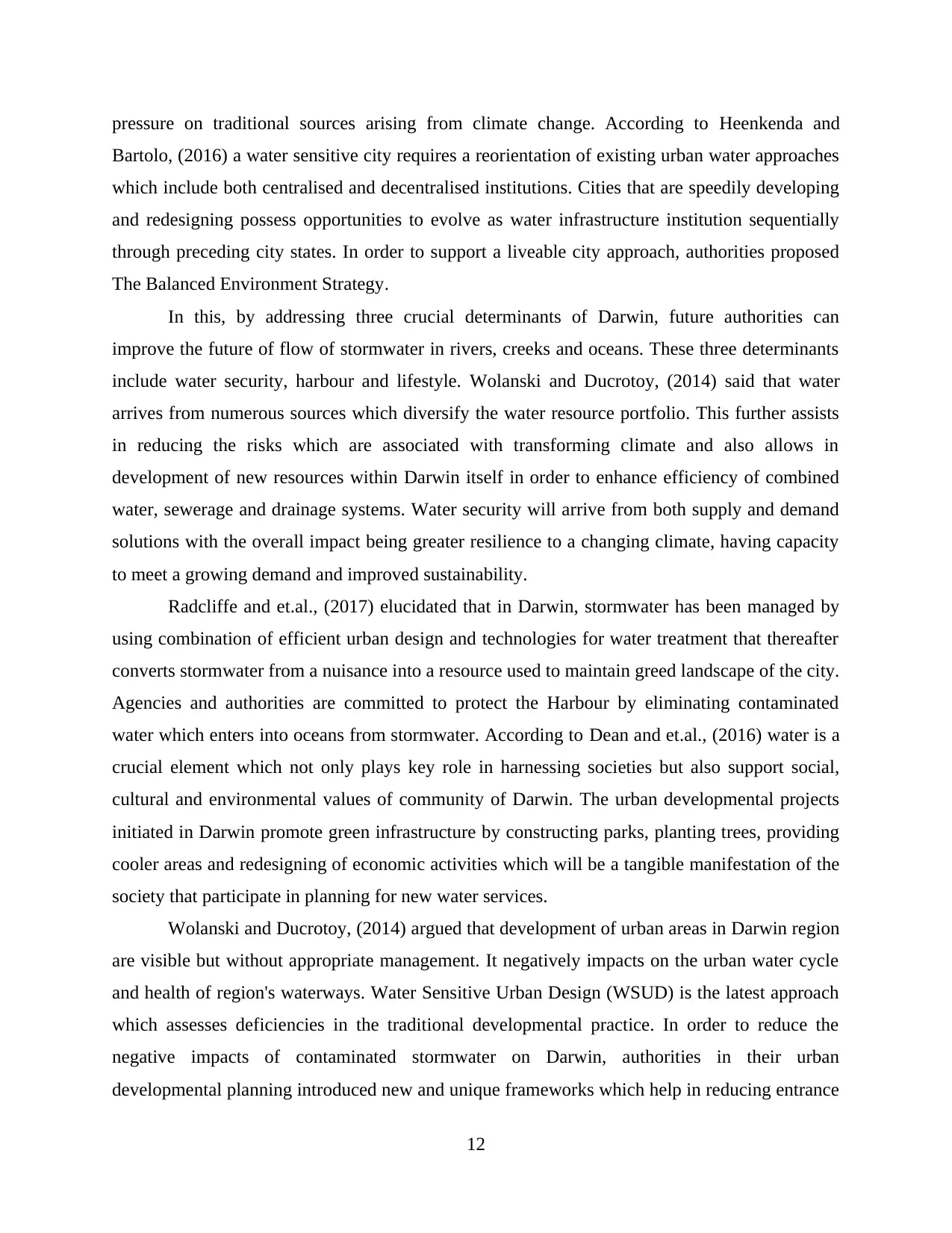
pressure on traditional sources arising from climate change. According to Heenkenda and
Bartolo, (2016) a water sensitive city requires a reorientation of existing urban water approaches
which include both centralised and decentralised institutions. Cities that are speedily developing
and redesigning possess opportunities to evolve as water infrastructure institution sequentially
through preceding city states. In order to support a liveable city approach, authorities proposed
The Balanced Environment Strategy.
In this, by addressing three crucial determinants of Darwin, future authorities can
improve the future of flow of stormwater in rivers, creeks and oceans. These three determinants
include water security, harbour and lifestyle. Wolanski and Ducrotoy, (2014) said that water
arrives from numerous sources which diversify the water resource portfolio. This further assists
in reducing the risks which are associated with transforming climate and also allows in
development of new resources within Darwin itself in order to enhance efficiency of combined
water, sewerage and drainage systems. Water security will arrive from both supply and demand
solutions with the overall impact being greater resilience to a changing climate, having capacity
to meet a growing demand and improved sustainability.
Radcliffe and et.al., (2017) elucidated that in Darwin, stormwater has been managed by
using combination of efficient urban design and technologies for water treatment that thereafter
converts stormwater from a nuisance into a resource used to maintain greed landscape of the city.
Agencies and authorities are committed to protect the Harbour by eliminating contaminated
water which enters into oceans from stormwater. According to Dean and et.al., (2016) water is a
crucial element which not only plays key role in harnessing societies but also support social,
cultural and environmental values of community of Darwin. The urban developmental projects
initiated in Darwin promote green infrastructure by constructing parks, planting trees, providing
cooler areas and redesigning of economic activities which will be a tangible manifestation of the
society that participate in planning for new water services.
Wolanski and Ducrotoy, (2014) argued that development of urban areas in Darwin region
are visible but without appropriate management. It negatively impacts on the urban water cycle
and health of region's waterways. Water Sensitive Urban Design (WSUD) is the latest approach
which assesses deficiencies in the traditional developmental practice. In order to reduce the
negative impacts of contaminated stormwater on Darwin, authorities in their urban
developmental planning introduced new and unique frameworks which help in reducing entrance
12
Bartolo, (2016) a water sensitive city requires a reorientation of existing urban water approaches
which include both centralised and decentralised institutions. Cities that are speedily developing
and redesigning possess opportunities to evolve as water infrastructure institution sequentially
through preceding city states. In order to support a liveable city approach, authorities proposed
The Balanced Environment Strategy.
In this, by addressing three crucial determinants of Darwin, future authorities can
improve the future of flow of stormwater in rivers, creeks and oceans. These three determinants
include water security, harbour and lifestyle. Wolanski and Ducrotoy, (2014) said that water
arrives from numerous sources which diversify the water resource portfolio. This further assists
in reducing the risks which are associated with transforming climate and also allows in
development of new resources within Darwin itself in order to enhance efficiency of combined
water, sewerage and drainage systems. Water security will arrive from both supply and demand
solutions with the overall impact being greater resilience to a changing climate, having capacity
to meet a growing demand and improved sustainability.
Radcliffe and et.al., (2017) elucidated that in Darwin, stormwater has been managed by
using combination of efficient urban design and technologies for water treatment that thereafter
converts stormwater from a nuisance into a resource used to maintain greed landscape of the city.
Agencies and authorities are committed to protect the Harbour by eliminating contaminated
water which enters into oceans from stormwater. According to Dean and et.al., (2016) water is a
crucial element which not only plays key role in harnessing societies but also support social,
cultural and environmental values of community of Darwin. The urban developmental projects
initiated in Darwin promote green infrastructure by constructing parks, planting trees, providing
cooler areas and redesigning of economic activities which will be a tangible manifestation of the
society that participate in planning for new water services.
Wolanski and Ducrotoy, (2014) argued that development of urban areas in Darwin region
are visible but without appropriate management. It negatively impacts on the urban water cycle
and health of region's waterways. Water Sensitive Urban Design (WSUD) is the latest approach
which assesses deficiencies in the traditional developmental practice. In order to reduce the
negative impacts of contaminated stormwater on Darwin, authorities in their urban
developmental planning introduced new and unique frameworks which help in reducing entrance
12
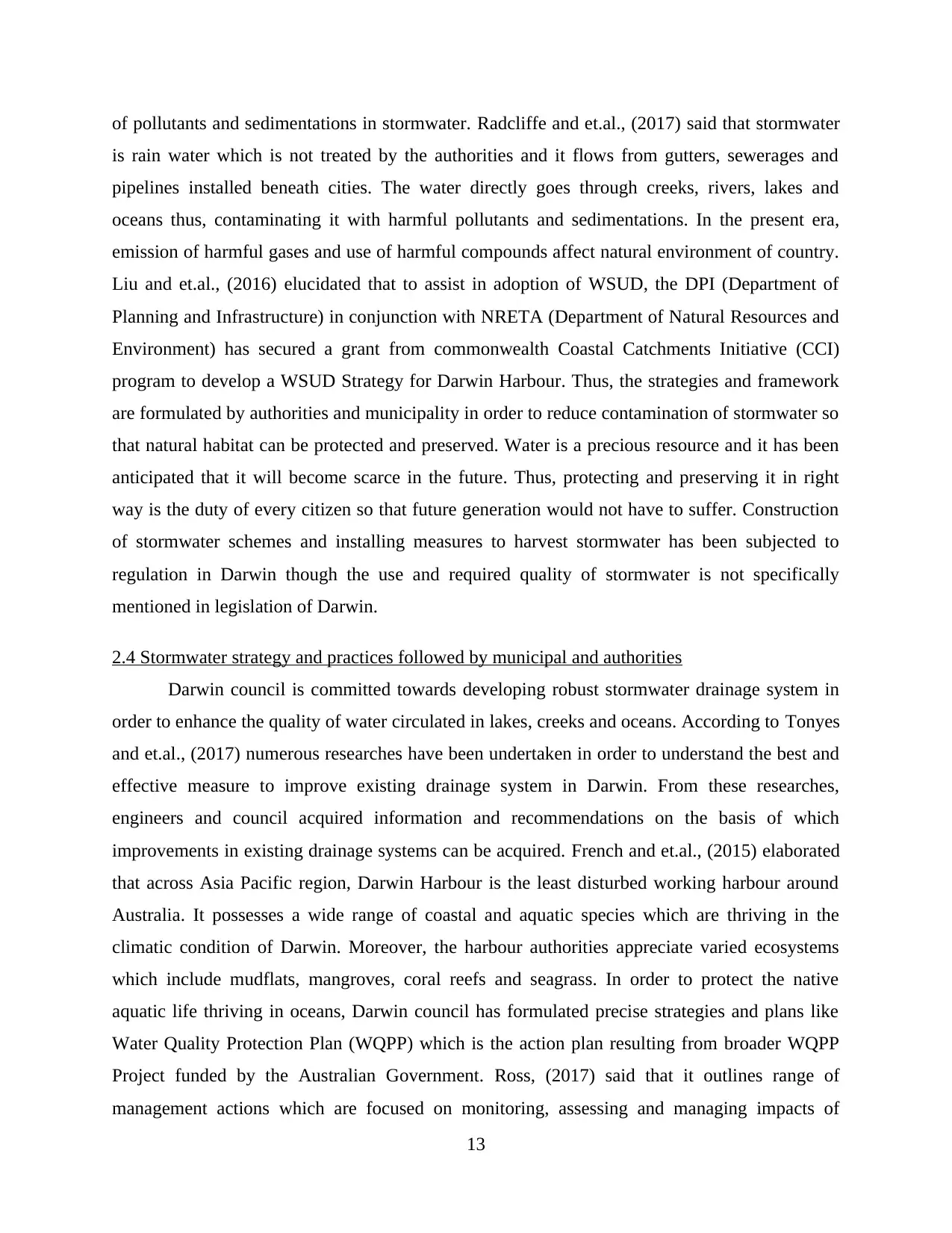
of pollutants and sedimentations in stormwater. Radcliffe and et.al., (2017) said that stormwater
is rain water which is not treated by the authorities and it flows from gutters, sewerages and
pipelines installed beneath cities. The water directly goes through creeks, rivers, lakes and
oceans thus, contaminating it with harmful pollutants and sedimentations. In the present era,
emission of harmful gases and use of harmful compounds affect natural environment of country.
Liu and et.al., (2016) elucidated that to assist in adoption of WSUD, the DPI (Department of
Planning and Infrastructure) in conjunction with NRETA (Department of Natural Resources and
Environment) has secured a grant from commonwealth Coastal Catchments Initiative (CCI)
program to develop a WSUD Strategy for Darwin Harbour. Thus, the strategies and framework
are formulated by authorities and municipality in order to reduce contamination of stormwater so
that natural habitat can be protected and preserved. Water is a precious resource and it has been
anticipated that it will become scarce in the future. Thus, protecting and preserving it in right
way is the duty of every citizen so that future generation would not have to suffer. Construction
of stormwater schemes and installing measures to harvest stormwater has been subjected to
regulation in Darwin though the use and required quality of stormwater is not specifically
mentioned in legislation of Darwin.
2.4 Stormwater strategy and practices followed by municipal and authorities
Darwin council is committed towards developing robust stormwater drainage system in
order to enhance the quality of water circulated in lakes, creeks and oceans. According to Tonyes
and et.al., (2017) numerous researches have been undertaken in order to understand the best and
effective measure to improve existing drainage system in Darwin. From these researches,
engineers and council acquired information and recommendations on the basis of which
improvements in existing drainage systems can be acquired. French and et.al., (2015) elaborated
that across Asia Pacific region, Darwin Harbour is the least disturbed working harbour around
Australia. It possesses a wide range of coastal and aquatic species which are thriving in the
climatic condition of Darwin. Moreover, the harbour authorities appreciate varied ecosystems
which include mudflats, mangroves, coral reefs and seagrass. In order to protect the native
aquatic life thriving in oceans, Darwin council has formulated precise strategies and plans like
Water Quality Protection Plan (WQPP) which is the action plan resulting from broader WQPP
Project funded by the Australian Government. Ross, (2017) said that it outlines range of
management actions which are focused on monitoring, assessing and managing impacts of
13
is rain water which is not treated by the authorities and it flows from gutters, sewerages and
pipelines installed beneath cities. The water directly goes through creeks, rivers, lakes and
oceans thus, contaminating it with harmful pollutants and sedimentations. In the present era,
emission of harmful gases and use of harmful compounds affect natural environment of country.
Liu and et.al., (2016) elucidated that to assist in adoption of WSUD, the DPI (Department of
Planning and Infrastructure) in conjunction with NRETA (Department of Natural Resources and
Environment) has secured a grant from commonwealth Coastal Catchments Initiative (CCI)
program to develop a WSUD Strategy for Darwin Harbour. Thus, the strategies and framework
are formulated by authorities and municipality in order to reduce contamination of stormwater so
that natural habitat can be protected and preserved. Water is a precious resource and it has been
anticipated that it will become scarce in the future. Thus, protecting and preserving it in right
way is the duty of every citizen so that future generation would not have to suffer. Construction
of stormwater schemes and installing measures to harvest stormwater has been subjected to
regulation in Darwin though the use and required quality of stormwater is not specifically
mentioned in legislation of Darwin.
2.4 Stormwater strategy and practices followed by municipal and authorities
Darwin council is committed towards developing robust stormwater drainage system in
order to enhance the quality of water circulated in lakes, creeks and oceans. According to Tonyes
and et.al., (2017) numerous researches have been undertaken in order to understand the best and
effective measure to improve existing drainage system in Darwin. From these researches,
engineers and council acquired information and recommendations on the basis of which
improvements in existing drainage systems can be acquired. French and et.al., (2015) elaborated
that across Asia Pacific region, Darwin Harbour is the least disturbed working harbour around
Australia. It possesses a wide range of coastal and aquatic species which are thriving in the
climatic condition of Darwin. Moreover, the harbour authorities appreciate varied ecosystems
which include mudflats, mangroves, coral reefs and seagrass. In order to protect the native
aquatic life thriving in oceans, Darwin council has formulated precise strategies and plans like
Water Quality Protection Plan (WQPP) which is the action plan resulting from broader WQPP
Project funded by the Australian Government. Ross, (2017) said that it outlines range of
management actions which are focused on monitoring, assessing and managing impacts of
13
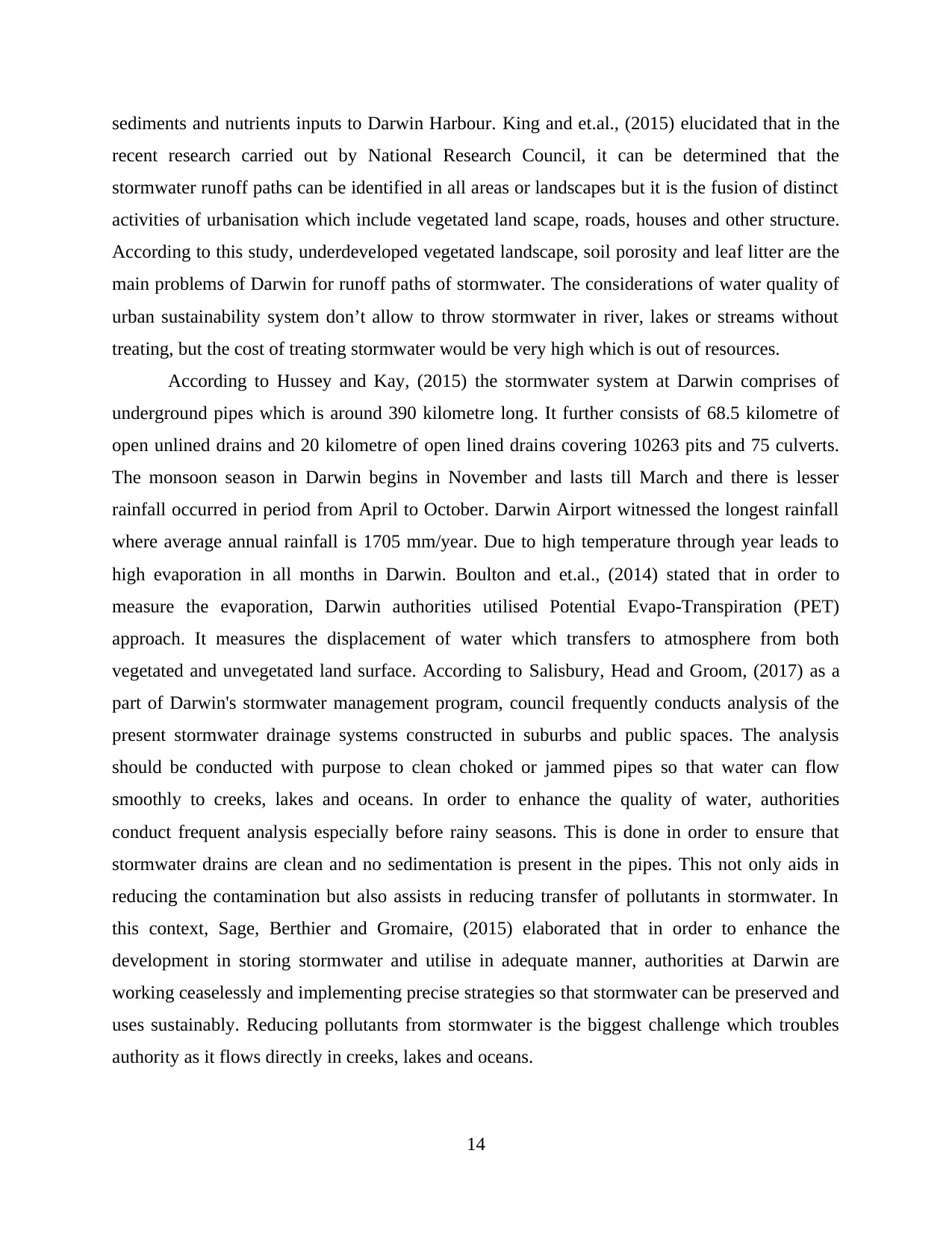
sediments and nutrients inputs to Darwin Harbour. King and et.al., (2015) elucidated that in the
recent research carried out by National Research Council, it can be determined that the
stormwater runoff paths can be identified in all areas or landscapes but it is the fusion of distinct
activities of urbanisation which include vegetated land scape, roads, houses and other structure.
According to this study, underdeveloped vegetated landscape, soil porosity and leaf litter are the
main problems of Darwin for runoff paths of stormwater. The considerations of water quality of
urban sustainability system don’t allow to throw stormwater in river, lakes or streams without
treating, but the cost of treating stormwater would be very high which is out of resources.
According to Hussey and Kay, (2015) the stormwater system at Darwin comprises of
underground pipes which is around 390 kilometre long. It further consists of 68.5 kilometre of
open unlined drains and 20 kilometre of open lined drains covering 10263 pits and 75 culverts.
The monsoon season in Darwin begins in November and lasts till March and there is lesser
rainfall occurred in period from April to October. Darwin Airport witnessed the longest rainfall
where average annual rainfall is 1705 mm/year. Due to high temperature through year leads to
high evaporation in all months in Darwin. Boulton and et.al., (2014) stated that in order to
measure the evaporation, Darwin authorities utilised Potential Evapo-Transpiration (PET)
approach. It measures the displacement of water which transfers to atmosphere from both
vegetated and unvegetated land surface. According to Salisbury, Head and Groom, (2017) as a
part of Darwin's stormwater management program, council frequently conducts analysis of the
present stormwater drainage systems constructed in suburbs and public spaces. The analysis
should be conducted with purpose to clean choked or jammed pipes so that water can flow
smoothly to creeks, lakes and oceans. In order to enhance the quality of water, authorities
conduct frequent analysis especially before rainy seasons. This is done in order to ensure that
stormwater drains are clean and no sedimentation is present in the pipes. This not only aids in
reducing the contamination but also assists in reducing transfer of pollutants in stormwater. In
this context, Sage, Berthier and Gromaire, (2015) elaborated that in order to enhance the
development in storing stormwater and utilise in adequate manner, authorities at Darwin are
working ceaselessly and implementing precise strategies so that stormwater can be preserved and
uses sustainably. Reducing pollutants from stormwater is the biggest challenge which troubles
authority as it flows directly in creeks, lakes and oceans.
14
recent research carried out by National Research Council, it can be determined that the
stormwater runoff paths can be identified in all areas or landscapes but it is the fusion of distinct
activities of urbanisation which include vegetated land scape, roads, houses and other structure.
According to this study, underdeveloped vegetated landscape, soil porosity and leaf litter are the
main problems of Darwin for runoff paths of stormwater. The considerations of water quality of
urban sustainability system don’t allow to throw stormwater in river, lakes or streams without
treating, but the cost of treating stormwater would be very high which is out of resources.
According to Hussey and Kay, (2015) the stormwater system at Darwin comprises of
underground pipes which is around 390 kilometre long. It further consists of 68.5 kilometre of
open unlined drains and 20 kilometre of open lined drains covering 10263 pits and 75 culverts.
The monsoon season in Darwin begins in November and lasts till March and there is lesser
rainfall occurred in period from April to October. Darwin Airport witnessed the longest rainfall
where average annual rainfall is 1705 mm/year. Due to high temperature through year leads to
high evaporation in all months in Darwin. Boulton and et.al., (2014) stated that in order to
measure the evaporation, Darwin authorities utilised Potential Evapo-Transpiration (PET)
approach. It measures the displacement of water which transfers to atmosphere from both
vegetated and unvegetated land surface. According to Salisbury, Head and Groom, (2017) as a
part of Darwin's stormwater management program, council frequently conducts analysis of the
present stormwater drainage systems constructed in suburbs and public spaces. The analysis
should be conducted with purpose to clean choked or jammed pipes so that water can flow
smoothly to creeks, lakes and oceans. In order to enhance the quality of water, authorities
conduct frequent analysis especially before rainy seasons. This is done in order to ensure that
stormwater drains are clean and no sedimentation is present in the pipes. This not only aids in
reducing the contamination but also assists in reducing transfer of pollutants in stormwater. In
this context, Sage, Berthier and Gromaire, (2015) elaborated that in order to enhance the
development in storing stormwater and utilise in adequate manner, authorities at Darwin are
working ceaselessly and implementing precise strategies so that stormwater can be preserved and
uses sustainably. Reducing pollutants from stormwater is the biggest challenge which troubles
authority as it flows directly in creeks, lakes and oceans.
14
Secure Best Marks with AI Grader
Need help grading? Try our AI Grader for instant feedback on your assignments.
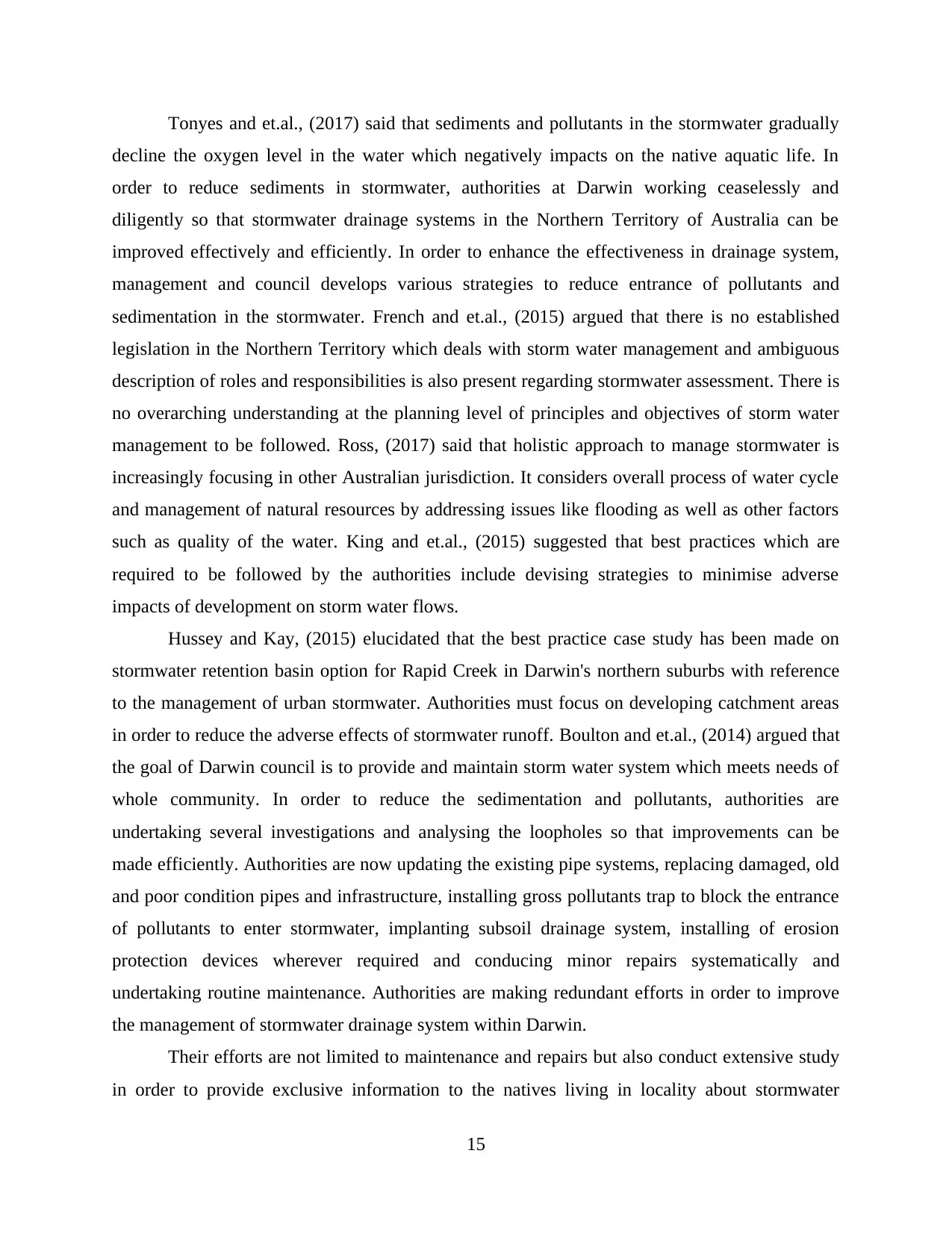
Tonyes and et.al., (2017) said that sediments and pollutants in the stormwater gradually
decline the oxygen level in the water which negatively impacts on the native aquatic life. In
order to reduce sediments in stormwater, authorities at Darwin working ceaselessly and
diligently so that stormwater drainage systems in the Northern Territory of Australia can be
improved effectively and efficiently. In order to enhance the effectiveness in drainage system,
management and council develops various strategies to reduce entrance of pollutants and
sedimentation in the stormwater. French and et.al., (2015) argued that there is no established
legislation in the Northern Territory which deals with storm water management and ambiguous
description of roles and responsibilities is also present regarding stormwater assessment. There is
no overarching understanding at the planning level of principles and objectives of storm water
management to be followed. Ross, (2017) said that holistic approach to manage stormwater is
increasingly focusing in other Australian jurisdiction. It considers overall process of water cycle
and management of natural resources by addressing issues like flooding as well as other factors
such as quality of the water. King and et.al., (2015) suggested that best practices which are
required to be followed by the authorities include devising strategies to minimise adverse
impacts of development on storm water flows.
Hussey and Kay, (2015) elucidated that the best practice case study has been made on
stormwater retention basin option for Rapid Creek in Darwin's northern suburbs with reference
to the management of urban stormwater. Authorities must focus on developing catchment areas
in order to reduce the adverse effects of stormwater runoff. Boulton and et.al., (2014) argued that
the goal of Darwin council is to provide and maintain storm water system which meets needs of
whole community. In order to reduce the sedimentation and pollutants, authorities are
undertaking several investigations and analysing the loopholes so that improvements can be
made efficiently. Authorities are now updating the existing pipe systems, replacing damaged, old
and poor condition pipes and infrastructure, installing gross pollutants trap to block the entrance
of pollutants to enter stormwater, implanting subsoil drainage system, installing of erosion
protection devices wherever required and conducing minor repairs systematically and
undertaking routine maintenance. Authorities are making redundant efforts in order to improve
the management of stormwater drainage system within Darwin.
Their efforts are not limited to maintenance and repairs but also conduct extensive study
in order to provide exclusive information to the natives living in locality about stormwater
15
decline the oxygen level in the water which negatively impacts on the native aquatic life. In
order to reduce sediments in stormwater, authorities at Darwin working ceaselessly and
diligently so that stormwater drainage systems in the Northern Territory of Australia can be
improved effectively and efficiently. In order to enhance the effectiveness in drainage system,
management and council develops various strategies to reduce entrance of pollutants and
sedimentation in the stormwater. French and et.al., (2015) argued that there is no established
legislation in the Northern Territory which deals with storm water management and ambiguous
description of roles and responsibilities is also present regarding stormwater assessment. There is
no overarching understanding at the planning level of principles and objectives of storm water
management to be followed. Ross, (2017) said that holistic approach to manage stormwater is
increasingly focusing in other Australian jurisdiction. It considers overall process of water cycle
and management of natural resources by addressing issues like flooding as well as other factors
such as quality of the water. King and et.al., (2015) suggested that best practices which are
required to be followed by the authorities include devising strategies to minimise adverse
impacts of development on storm water flows.
Hussey and Kay, (2015) elucidated that the best practice case study has been made on
stormwater retention basin option for Rapid Creek in Darwin's northern suburbs with reference
to the management of urban stormwater. Authorities must focus on developing catchment areas
in order to reduce the adverse effects of stormwater runoff. Boulton and et.al., (2014) argued that
the goal of Darwin council is to provide and maintain storm water system which meets needs of
whole community. In order to reduce the sedimentation and pollutants, authorities are
undertaking several investigations and analysing the loopholes so that improvements can be
made efficiently. Authorities are now updating the existing pipe systems, replacing damaged, old
and poor condition pipes and infrastructure, installing gross pollutants trap to block the entrance
of pollutants to enter stormwater, implanting subsoil drainage system, installing of erosion
protection devices wherever required and conducing minor repairs systematically and
undertaking routine maintenance. Authorities are making redundant efforts in order to improve
the management of stormwater drainage system within Darwin.
Their efforts are not limited to maintenance and repairs but also conduct extensive study
in order to provide exclusive information to the natives living in locality about stormwater
15
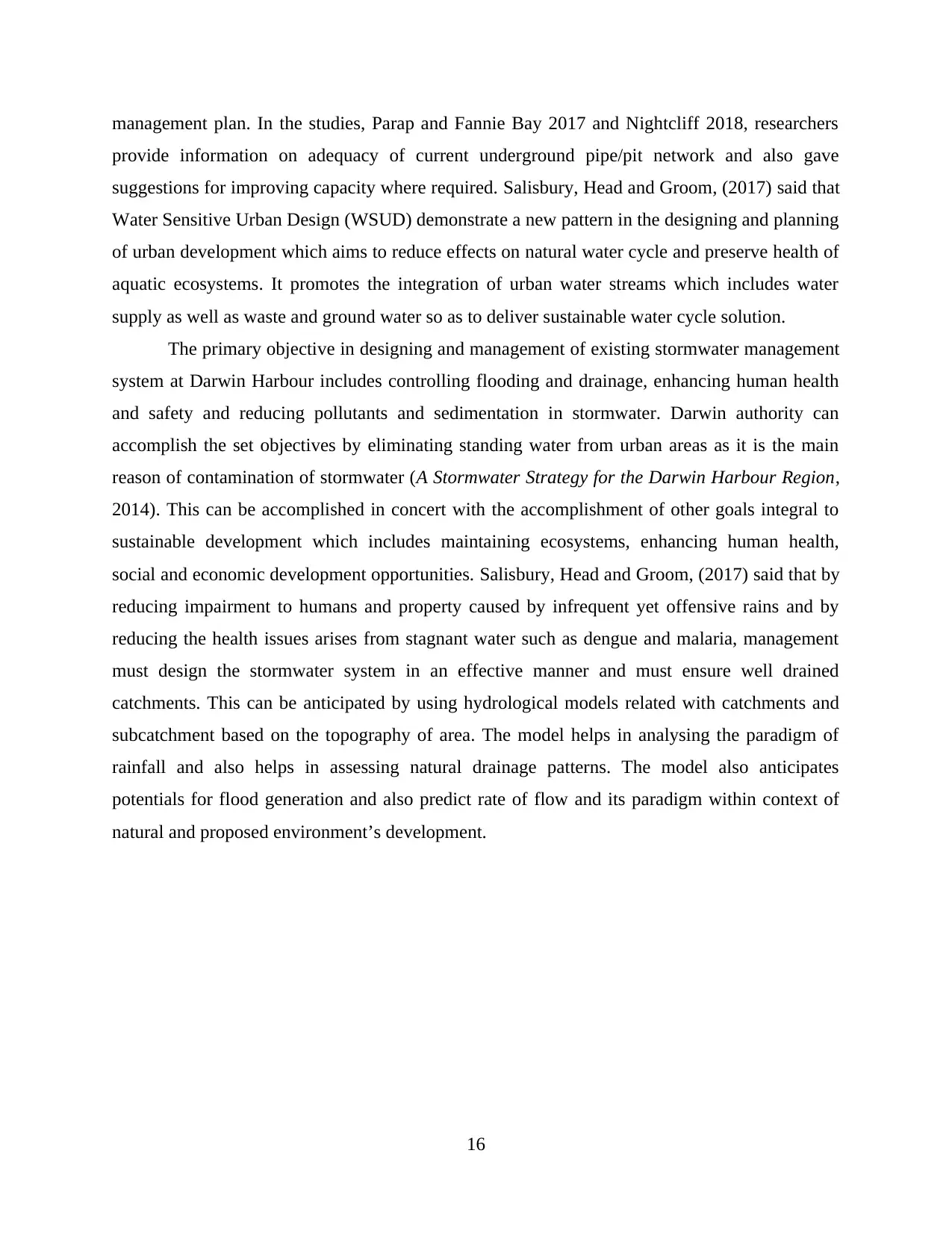
management plan. In the studies, Parap and Fannie Bay 2017 and Nightcliff 2018, researchers
provide information on adequacy of current underground pipe/pit network and also gave
suggestions for improving capacity where required. Salisbury, Head and Groom, (2017) said that
Water Sensitive Urban Design (WSUD) demonstrate a new pattern in the designing and planning
of urban development which aims to reduce effects on natural water cycle and preserve health of
aquatic ecosystems. It promotes the integration of urban water streams which includes water
supply as well as waste and ground water so as to deliver sustainable water cycle solution.
The primary objective in designing and management of existing stormwater management
system at Darwin Harbour includes controlling flooding and drainage, enhancing human health
and safety and reducing pollutants and sedimentation in stormwater. Darwin authority can
accomplish the set objectives by eliminating standing water from urban areas as it is the main
reason of contamination of stormwater (A Stormwater Strategy for the Darwin Harbour Region,
2014). This can be accomplished in concert with the accomplishment of other goals integral to
sustainable development which includes maintaining ecosystems, enhancing human health,
social and economic development opportunities. Salisbury, Head and Groom, (2017) said that by
reducing impairment to humans and property caused by infrequent yet offensive rains and by
reducing the health issues arises from stagnant water such as dengue and malaria, management
must design the stormwater system in an effective manner and must ensure well drained
catchments. This can be anticipated by using hydrological models related with catchments and
subcatchment based on the topography of area. The model helps in analysing the paradigm of
rainfall and also helps in assessing natural drainage patterns. The model also anticipates
potentials for flood generation and also predict rate of flow and its paradigm within context of
natural and proposed environment’s development.
16
provide information on adequacy of current underground pipe/pit network and also gave
suggestions for improving capacity where required. Salisbury, Head and Groom, (2017) said that
Water Sensitive Urban Design (WSUD) demonstrate a new pattern in the designing and planning
of urban development which aims to reduce effects on natural water cycle and preserve health of
aquatic ecosystems. It promotes the integration of urban water streams which includes water
supply as well as waste and ground water so as to deliver sustainable water cycle solution.
The primary objective in designing and management of existing stormwater management
system at Darwin Harbour includes controlling flooding and drainage, enhancing human health
and safety and reducing pollutants and sedimentation in stormwater. Darwin authority can
accomplish the set objectives by eliminating standing water from urban areas as it is the main
reason of contamination of stormwater (A Stormwater Strategy for the Darwin Harbour Region,
2014). This can be accomplished in concert with the accomplishment of other goals integral to
sustainable development which includes maintaining ecosystems, enhancing human health,
social and economic development opportunities. Salisbury, Head and Groom, (2017) said that by
reducing impairment to humans and property caused by infrequent yet offensive rains and by
reducing the health issues arises from stagnant water such as dengue and malaria, management
must design the stormwater system in an effective manner and must ensure well drained
catchments. This can be anticipated by using hydrological models related with catchments and
subcatchment based on the topography of area. The model helps in analysing the paradigm of
rainfall and also helps in assessing natural drainage patterns. The model also anticipates
potentials for flood generation and also predict rate of flow and its paradigm within context of
natural and proposed environment’s development.
16
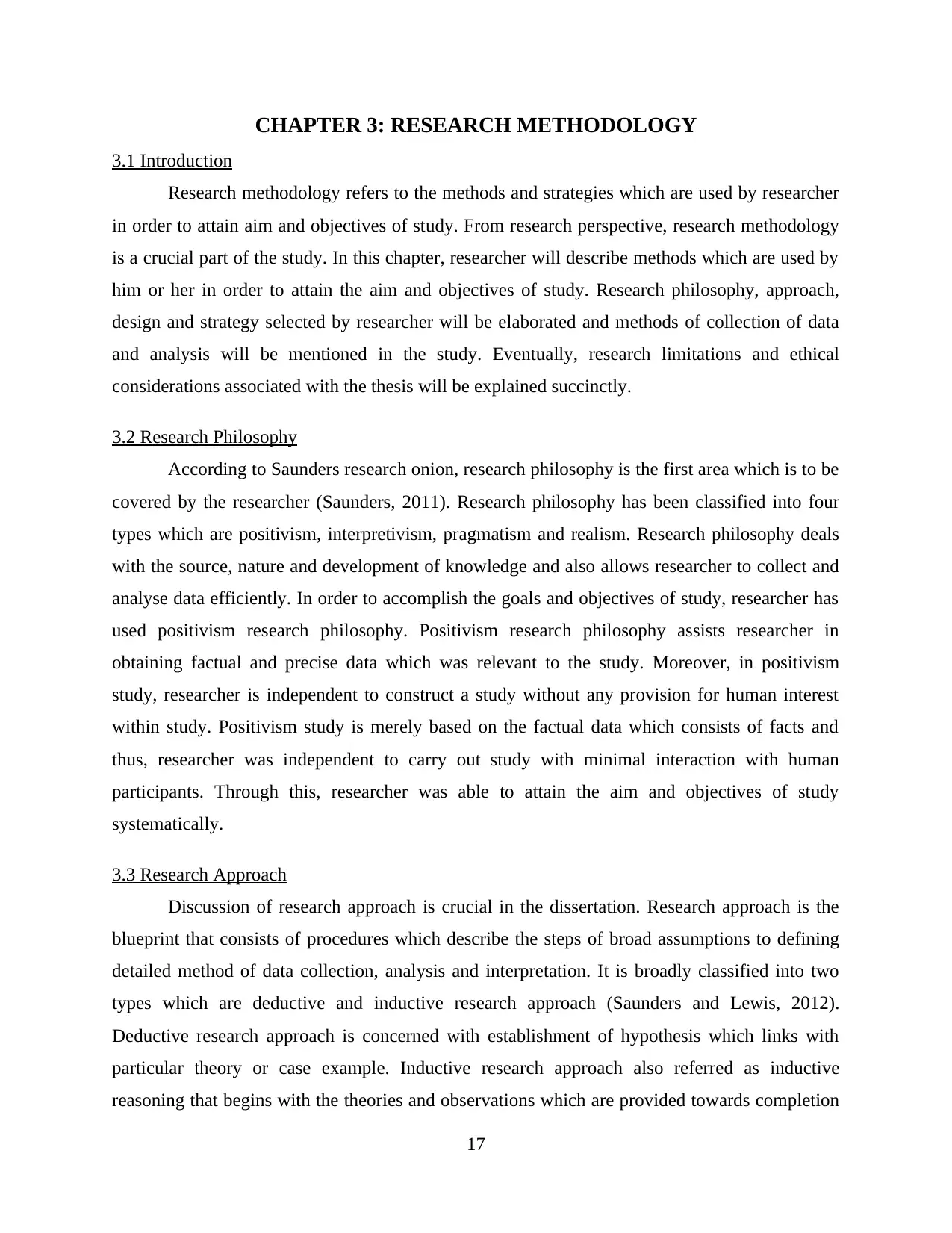
CHAPTER 3: RESEARCH METHODOLOGY
3.1 Introduction
Research methodology refers to the methods and strategies which are used by researcher
in order to attain aim and objectives of study. From research perspective, research methodology
is a crucial part of the study. In this chapter, researcher will describe methods which are used by
him or her in order to attain the aim and objectives of study. Research philosophy, approach,
design and strategy selected by researcher will be elaborated and methods of collection of data
and analysis will be mentioned in the study. Eventually, research limitations and ethical
considerations associated with the thesis will be explained succinctly.
3.2 Research Philosophy
According to Saunders research onion, research philosophy is the first area which is to be
covered by the researcher (Saunders, 2011). Research philosophy has been classified into four
types which are positivism, interpretivism, pragmatism and realism. Research philosophy deals
with the source, nature and development of knowledge and also allows researcher to collect and
analyse data efficiently. In order to accomplish the goals and objectives of study, researcher has
used positivism research philosophy. Positivism research philosophy assists researcher in
obtaining factual and precise data which was relevant to the study. Moreover, in positivism
study, researcher is independent to construct a study without any provision for human interest
within study. Positivism study is merely based on the factual data which consists of facts and
thus, researcher was independent to carry out study with minimal interaction with human
participants. Through this, researcher was able to attain the aim and objectives of study
systematically.
3.3 Research Approach
Discussion of research approach is crucial in the dissertation. Research approach is the
blueprint that consists of procedures which describe the steps of broad assumptions to defining
detailed method of data collection, analysis and interpretation. It is broadly classified into two
types which are deductive and inductive research approach (Saunders and Lewis, 2012).
Deductive research approach is concerned with establishment of hypothesis which links with
particular theory or case example. Inductive research approach also referred as inductive
reasoning that begins with the theories and observations which are provided towards completion
17
3.1 Introduction
Research methodology refers to the methods and strategies which are used by researcher
in order to attain aim and objectives of study. From research perspective, research methodology
is a crucial part of the study. In this chapter, researcher will describe methods which are used by
him or her in order to attain the aim and objectives of study. Research philosophy, approach,
design and strategy selected by researcher will be elaborated and methods of collection of data
and analysis will be mentioned in the study. Eventually, research limitations and ethical
considerations associated with the thesis will be explained succinctly.
3.2 Research Philosophy
According to Saunders research onion, research philosophy is the first area which is to be
covered by the researcher (Saunders, 2011). Research philosophy has been classified into four
types which are positivism, interpretivism, pragmatism and realism. Research philosophy deals
with the source, nature and development of knowledge and also allows researcher to collect and
analyse data efficiently. In order to accomplish the goals and objectives of study, researcher has
used positivism research philosophy. Positivism research philosophy assists researcher in
obtaining factual and precise data which was relevant to the study. Moreover, in positivism
study, researcher is independent to construct a study without any provision for human interest
within study. Positivism study is merely based on the factual data which consists of facts and
thus, researcher was independent to carry out study with minimal interaction with human
participants. Through this, researcher was able to attain the aim and objectives of study
systematically.
3.3 Research Approach
Discussion of research approach is crucial in the dissertation. Research approach is the
blueprint that consists of procedures which describe the steps of broad assumptions to defining
detailed method of data collection, analysis and interpretation. It is broadly classified into two
types which are deductive and inductive research approach (Saunders and Lewis, 2012).
Deductive research approach is concerned with establishment of hypothesis which links with
particular theory or case example. Inductive research approach also referred as inductive
reasoning that begins with the theories and observations which are provided towards completion
17
Paraphrase This Document
Need a fresh take? Get an instant paraphrase of this document with our AI Paraphraser
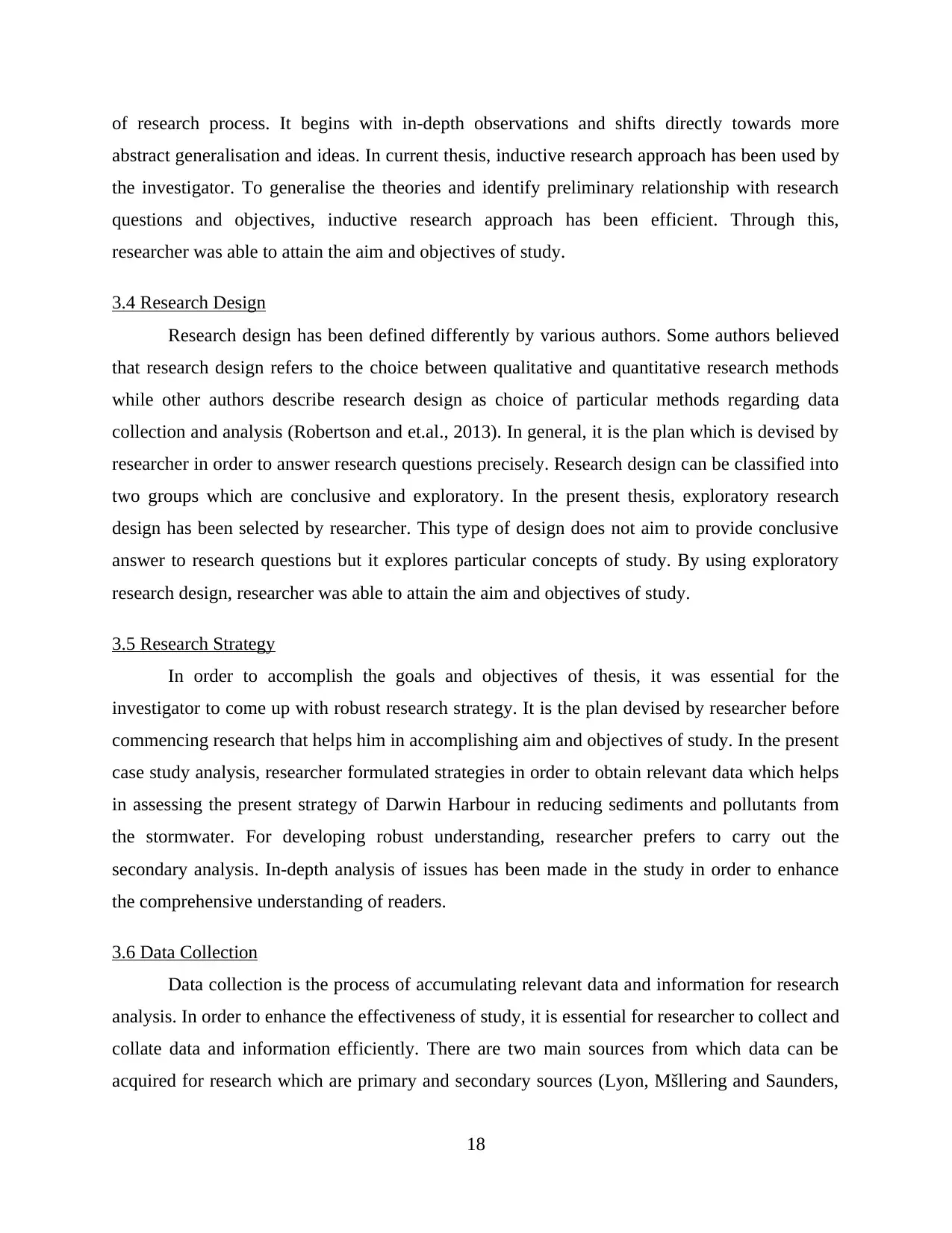
of research process. It begins with in-depth observations and shifts directly towards more
abstract generalisation and ideas. In current thesis, inductive research approach has been used by
the investigator. To generalise the theories and identify preliminary relationship with research
questions and objectives, inductive research approach has been efficient. Through this,
researcher was able to attain the aim and objectives of study.
3.4 Research Design
Research design has been defined differently by various authors. Some authors believed
that research design refers to the choice between qualitative and quantitative research methods
while other authors describe research design as choice of particular methods regarding data
collection and analysis (Robertson and et.al., 2013). In general, it is the plan which is devised by
researcher in order to answer research questions precisely. Research design can be classified into
two groups which are conclusive and exploratory. In the present thesis, exploratory research
design has been selected by researcher. This type of design does not aim to provide conclusive
answer to research questions but it explores particular concepts of study. By using exploratory
research design, researcher was able to attain the aim and objectives of study.
3.5 Research Strategy
In order to accomplish the goals and objectives of thesis, it was essential for the
investigator to come up with robust research strategy. It is the plan devised by researcher before
commencing research that helps him in accomplishing aim and objectives of study. In the present
case study analysis, researcher formulated strategies in order to obtain relevant data which helps
in assessing the present strategy of Darwin Harbour in reducing sediments and pollutants from
the stormwater. For developing robust understanding, researcher prefers to carry out the
secondary analysis. In-depth analysis of issues has been made in the study in order to enhance
the comprehensive understanding of readers.
3.6 Data Collection
Data collection is the process of accumulating relevant data and information for research
analysis. In order to enhance the effectiveness of study, it is essential for researcher to collect and
collate data and information efficiently. There are two main sources from which data can be
acquired for research which are primary and secondary sources (Lyon, Mšllering and Saunders,
18
abstract generalisation and ideas. In current thesis, inductive research approach has been used by
the investigator. To generalise the theories and identify preliminary relationship with research
questions and objectives, inductive research approach has been efficient. Through this,
researcher was able to attain the aim and objectives of study.
3.4 Research Design
Research design has been defined differently by various authors. Some authors believed
that research design refers to the choice between qualitative and quantitative research methods
while other authors describe research design as choice of particular methods regarding data
collection and analysis (Robertson and et.al., 2013). In general, it is the plan which is devised by
researcher in order to answer research questions precisely. Research design can be classified into
two groups which are conclusive and exploratory. In the present thesis, exploratory research
design has been selected by researcher. This type of design does not aim to provide conclusive
answer to research questions but it explores particular concepts of study. By using exploratory
research design, researcher was able to attain the aim and objectives of study.
3.5 Research Strategy
In order to accomplish the goals and objectives of thesis, it was essential for the
investigator to come up with robust research strategy. It is the plan devised by researcher before
commencing research that helps him in accomplishing aim and objectives of study. In the present
case study analysis, researcher formulated strategies in order to obtain relevant data which helps
in assessing the present strategy of Darwin Harbour in reducing sediments and pollutants from
the stormwater. For developing robust understanding, researcher prefers to carry out the
secondary analysis. In-depth analysis of issues has been made in the study in order to enhance
the comprehensive understanding of readers.
3.6 Data Collection
Data collection is the process of accumulating relevant data and information for research
analysis. In order to enhance the effectiveness of study, it is essential for researcher to collect and
collate data and information efficiently. There are two main sources from which data can be
acquired for research which are primary and secondary sources (Lyon, Mšllering and Saunders,
18
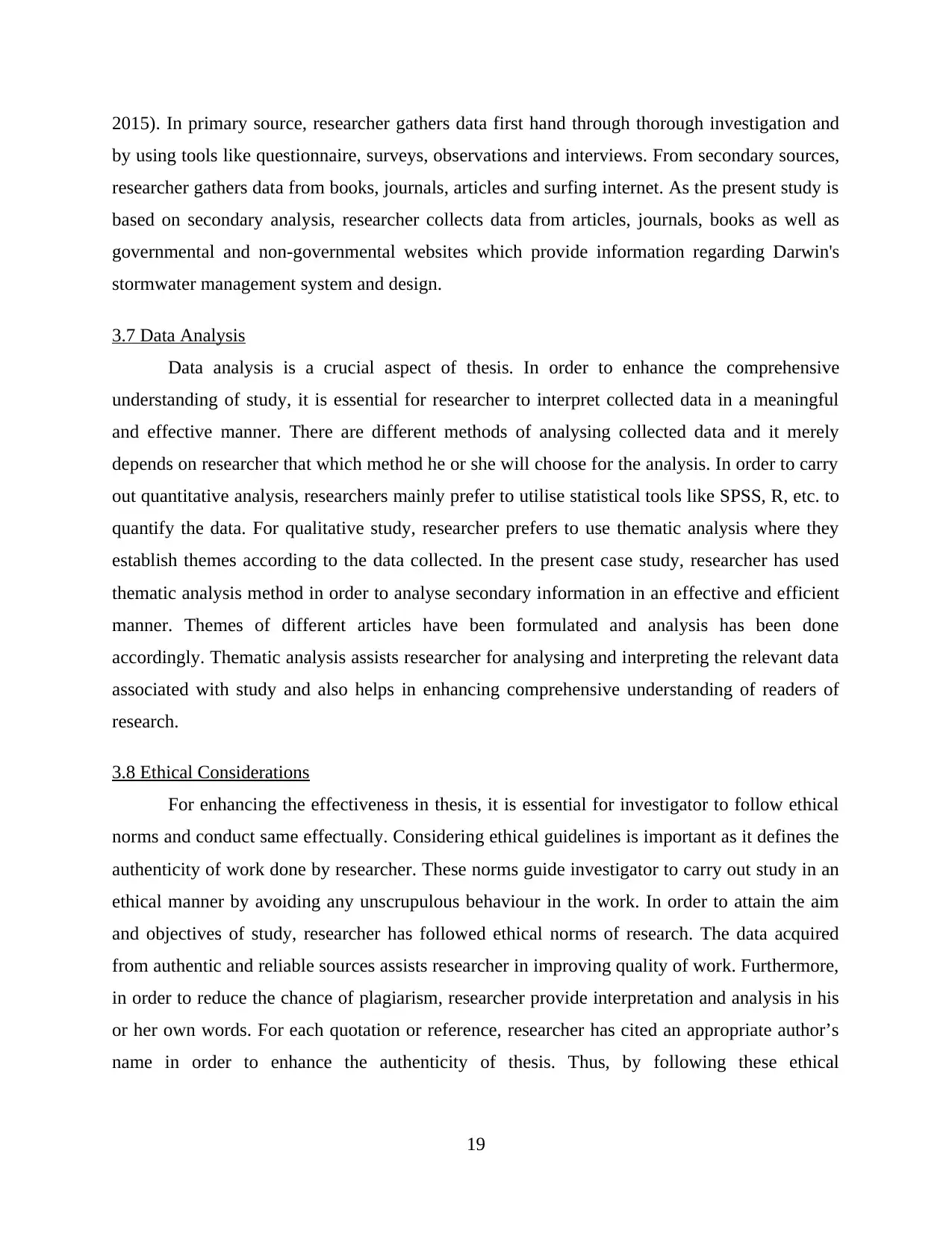
2015). In primary source, researcher gathers data first hand through thorough investigation and
by using tools like questionnaire, surveys, observations and interviews. From secondary sources,
researcher gathers data from books, journals, articles and surfing internet. As the present study is
based on secondary analysis, researcher collects data from articles, journals, books as well as
governmental and non-governmental websites which provide information regarding Darwin's
stormwater management system and design.
3.7 Data Analysis
Data analysis is a crucial aspect of thesis. In order to enhance the comprehensive
understanding of study, it is essential for researcher to interpret collected data in a meaningful
and effective manner. There are different methods of analysing collected data and it merely
depends on researcher that which method he or she will choose for the analysis. In order to carry
out quantitative analysis, researchers mainly prefer to utilise statistical tools like SPSS, R, etc. to
quantify the data. For qualitative study, researcher prefers to use thematic analysis where they
establish themes according to the data collected. In the present case study, researcher has used
thematic analysis method in order to analyse secondary information in an effective and efficient
manner. Themes of different articles have been formulated and analysis has been done
accordingly. Thematic analysis assists researcher for analysing and interpreting the relevant data
associated with study and also helps in enhancing comprehensive understanding of readers of
research.
3.8 Ethical Considerations
For enhancing the effectiveness in thesis, it is essential for investigator to follow ethical
norms and conduct same effectually. Considering ethical guidelines is important as it defines the
authenticity of work done by researcher. These norms guide investigator to carry out study in an
ethical manner by avoiding any unscrupulous behaviour in the work. In order to attain the aim
and objectives of study, researcher has followed ethical norms of research. The data acquired
from authentic and reliable sources assists researcher in improving quality of work. Furthermore,
in order to reduce the chance of plagiarism, researcher provide interpretation and analysis in his
or her own words. For each quotation or reference, researcher has cited an appropriate author’s
name in order to enhance the authenticity of thesis. Thus, by following these ethical
19
by using tools like questionnaire, surveys, observations and interviews. From secondary sources,
researcher gathers data from books, journals, articles and surfing internet. As the present study is
based on secondary analysis, researcher collects data from articles, journals, books as well as
governmental and non-governmental websites which provide information regarding Darwin's
stormwater management system and design.
3.7 Data Analysis
Data analysis is a crucial aspect of thesis. In order to enhance the comprehensive
understanding of study, it is essential for researcher to interpret collected data in a meaningful
and effective manner. There are different methods of analysing collected data and it merely
depends on researcher that which method he or she will choose for the analysis. In order to carry
out quantitative analysis, researchers mainly prefer to utilise statistical tools like SPSS, R, etc. to
quantify the data. For qualitative study, researcher prefers to use thematic analysis where they
establish themes according to the data collected. In the present case study, researcher has used
thematic analysis method in order to analyse secondary information in an effective and efficient
manner. Themes of different articles have been formulated and analysis has been done
accordingly. Thematic analysis assists researcher for analysing and interpreting the relevant data
associated with study and also helps in enhancing comprehensive understanding of readers of
research.
3.8 Ethical Considerations
For enhancing the effectiveness in thesis, it is essential for investigator to follow ethical
norms and conduct same effectually. Considering ethical guidelines is important as it defines the
authenticity of work done by researcher. These norms guide investigator to carry out study in an
ethical manner by avoiding any unscrupulous behaviour in the work. In order to attain the aim
and objectives of study, researcher has followed ethical norms of research. The data acquired
from authentic and reliable sources assists researcher in improving quality of work. Furthermore,
in order to reduce the chance of plagiarism, researcher provide interpretation and analysis in his
or her own words. For each quotation or reference, researcher has cited an appropriate author’s
name in order to enhance the authenticity of thesis. Thus, by following these ethical
19
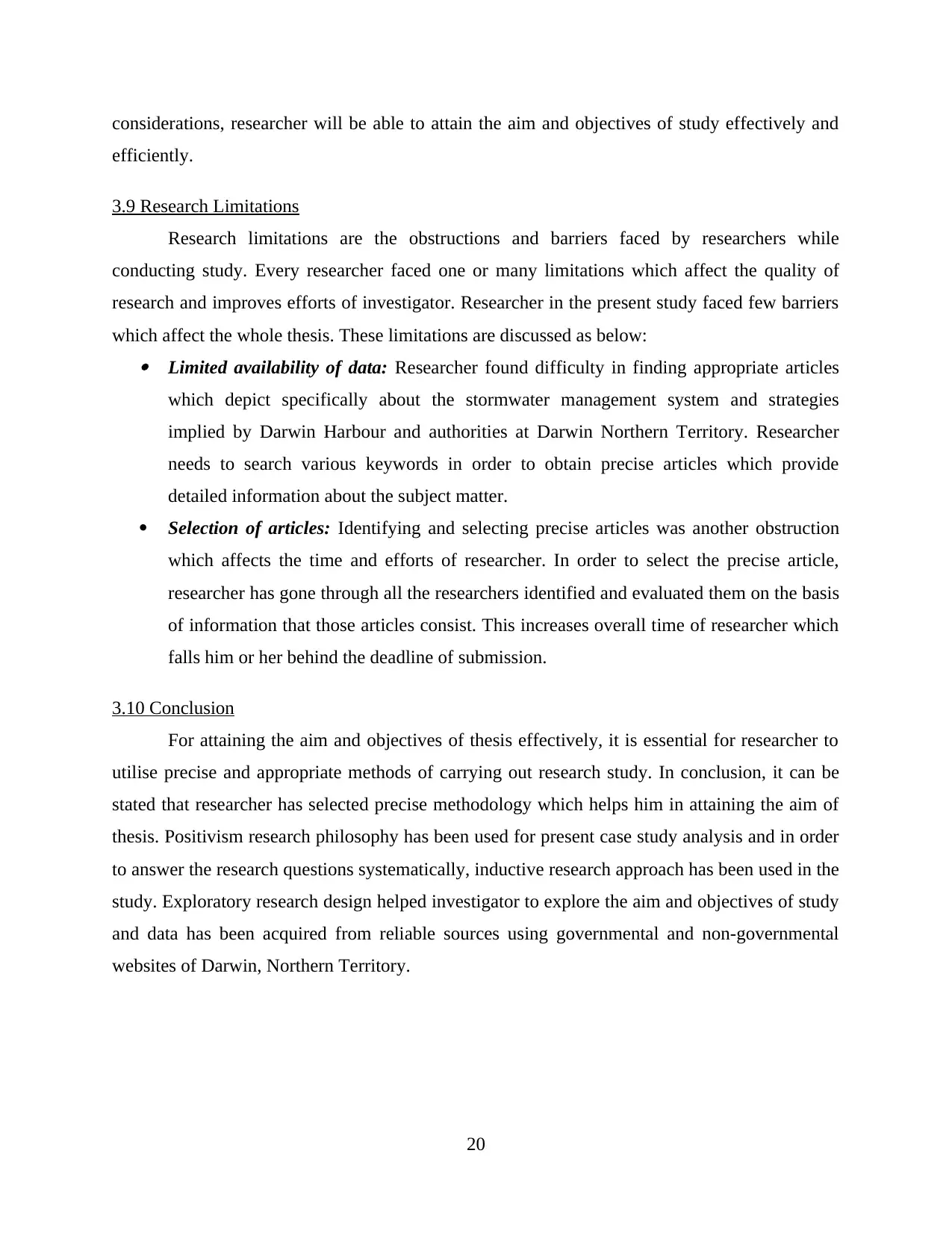
considerations, researcher will be able to attain the aim and objectives of study effectively and
efficiently.
3.9 Research Limitations
Research limitations are the obstructions and barriers faced by researchers while
conducting study. Every researcher faced one or many limitations which affect the quality of
research and improves efforts of investigator. Researcher in the present study faced few barriers
which affect the whole thesis. These limitations are discussed as below: Limited availability of data: Researcher found difficulty in finding appropriate articles
which depict specifically about the stormwater management system and strategies
implied by Darwin Harbour and authorities at Darwin Northern Territory. Researcher
needs to search various keywords in order to obtain precise articles which provide
detailed information about the subject matter.
Selection of articles: Identifying and selecting precise articles was another obstruction
which affects the time and efforts of researcher. In order to select the precise article,
researcher has gone through all the researchers identified and evaluated them on the basis
of information that those articles consist. This increases overall time of researcher which
falls him or her behind the deadline of submission.
3.10 Conclusion
For attaining the aim and objectives of thesis effectively, it is essential for researcher to
utilise precise and appropriate methods of carrying out research study. In conclusion, it can be
stated that researcher has selected precise methodology which helps him in attaining the aim of
thesis. Positivism research philosophy has been used for present case study analysis and in order
to answer the research questions systematically, inductive research approach has been used in the
study. Exploratory research design helped investigator to explore the aim and objectives of study
and data has been acquired from reliable sources using governmental and non-governmental
websites of Darwin, Northern Territory.
20
efficiently.
3.9 Research Limitations
Research limitations are the obstructions and barriers faced by researchers while
conducting study. Every researcher faced one or many limitations which affect the quality of
research and improves efforts of investigator. Researcher in the present study faced few barriers
which affect the whole thesis. These limitations are discussed as below: Limited availability of data: Researcher found difficulty in finding appropriate articles
which depict specifically about the stormwater management system and strategies
implied by Darwin Harbour and authorities at Darwin Northern Territory. Researcher
needs to search various keywords in order to obtain precise articles which provide
detailed information about the subject matter.
Selection of articles: Identifying and selecting precise articles was another obstruction
which affects the time and efforts of researcher. In order to select the precise article,
researcher has gone through all the researchers identified and evaluated them on the basis
of information that those articles consist. This increases overall time of researcher which
falls him or her behind the deadline of submission.
3.10 Conclusion
For attaining the aim and objectives of thesis effectively, it is essential for researcher to
utilise precise and appropriate methods of carrying out research study. In conclusion, it can be
stated that researcher has selected precise methodology which helps him in attaining the aim of
thesis. Positivism research philosophy has been used for present case study analysis and in order
to answer the research questions systematically, inductive research approach has been used in the
study. Exploratory research design helped investigator to explore the aim and objectives of study
and data has been acquired from reliable sources using governmental and non-governmental
websites of Darwin, Northern Territory.
20
Secure Best Marks with AI Grader
Need help grading? Try our AI Grader for instant feedback on your assignments.
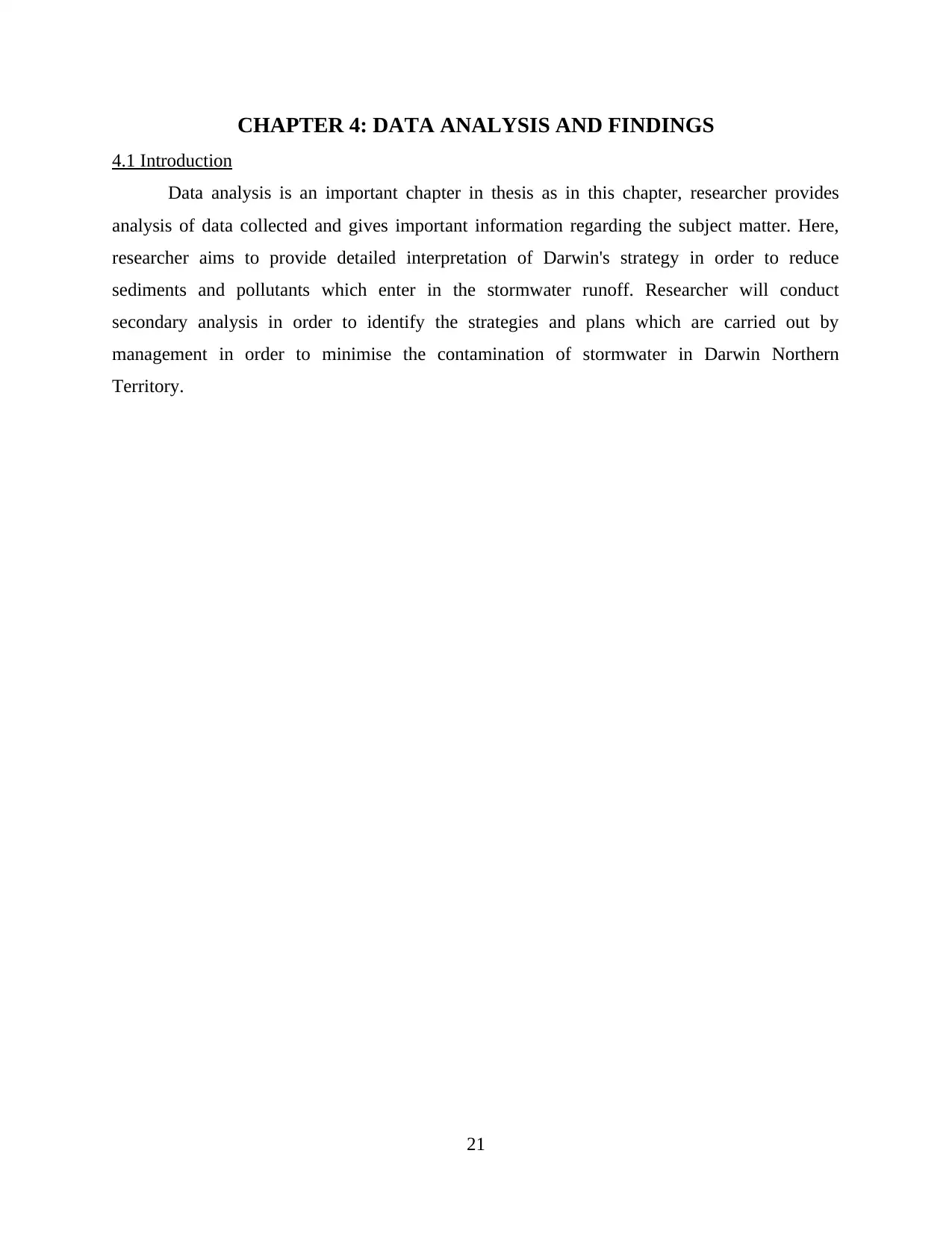
CHAPTER 4: DATA ANALYSIS AND FINDINGS
4.1 Introduction
Data analysis is an important chapter in thesis as in this chapter, researcher provides
analysis of data collected and gives important information regarding the subject matter. Here,
researcher aims to provide detailed interpretation of Darwin's strategy in order to reduce
sediments and pollutants which enter in the stormwater runoff. Researcher will conduct
secondary analysis in order to identify the strategies and plans which are carried out by
management in order to minimise the contamination of stormwater in Darwin Northern
Territory.
21
4.1 Introduction
Data analysis is an important chapter in thesis as in this chapter, researcher provides
analysis of data collected and gives important information regarding the subject matter. Here,
researcher aims to provide detailed interpretation of Darwin's strategy in order to reduce
sediments and pollutants which enter in the stormwater runoff. Researcher will conduct
secondary analysis in order to identify the strategies and plans which are carried out by
management in order to minimise the contamination of stormwater in Darwin Northern
Territory.
21
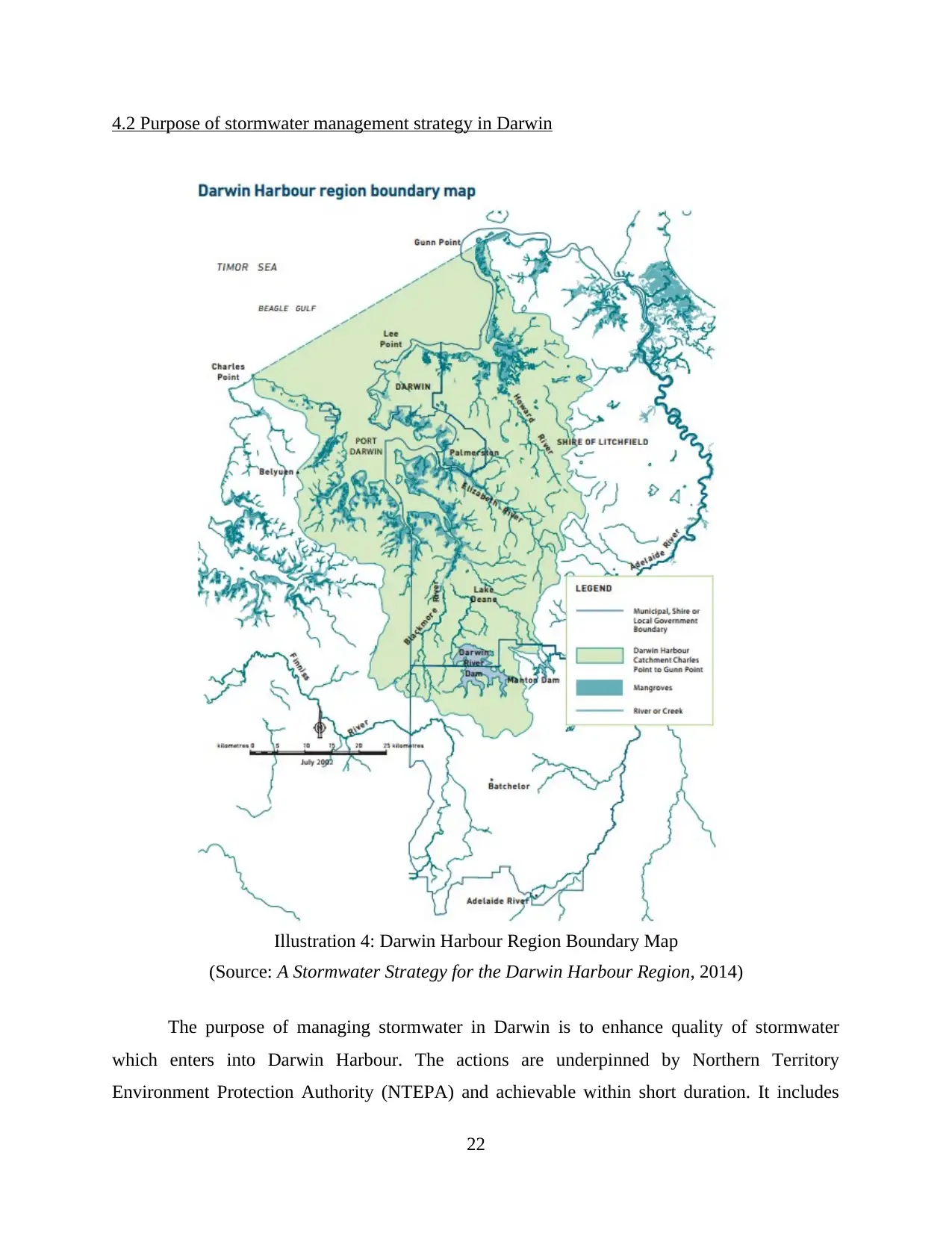
4.2 Purpose of stormwater management strategy in Darwin
The purpose of managing stormwater in Darwin is to enhance quality of stormwater
which enters into Darwin Harbour. The actions are underpinned by Northern Territory
Environment Protection Authority (NTEPA) and achievable within short duration. It includes
22
Illustration 4: Darwin Harbour Region Boundary Map
(Source: A Stormwater Strategy for the Darwin Harbour Region, 2014)
The purpose of managing stormwater in Darwin is to enhance quality of stormwater
which enters into Darwin Harbour. The actions are underpinned by Northern Territory
Environment Protection Authority (NTEPA) and achievable within short duration. It includes
22
Illustration 4: Darwin Harbour Region Boundary Map
(Source: A Stormwater Strategy for the Darwin Harbour Region, 2014)
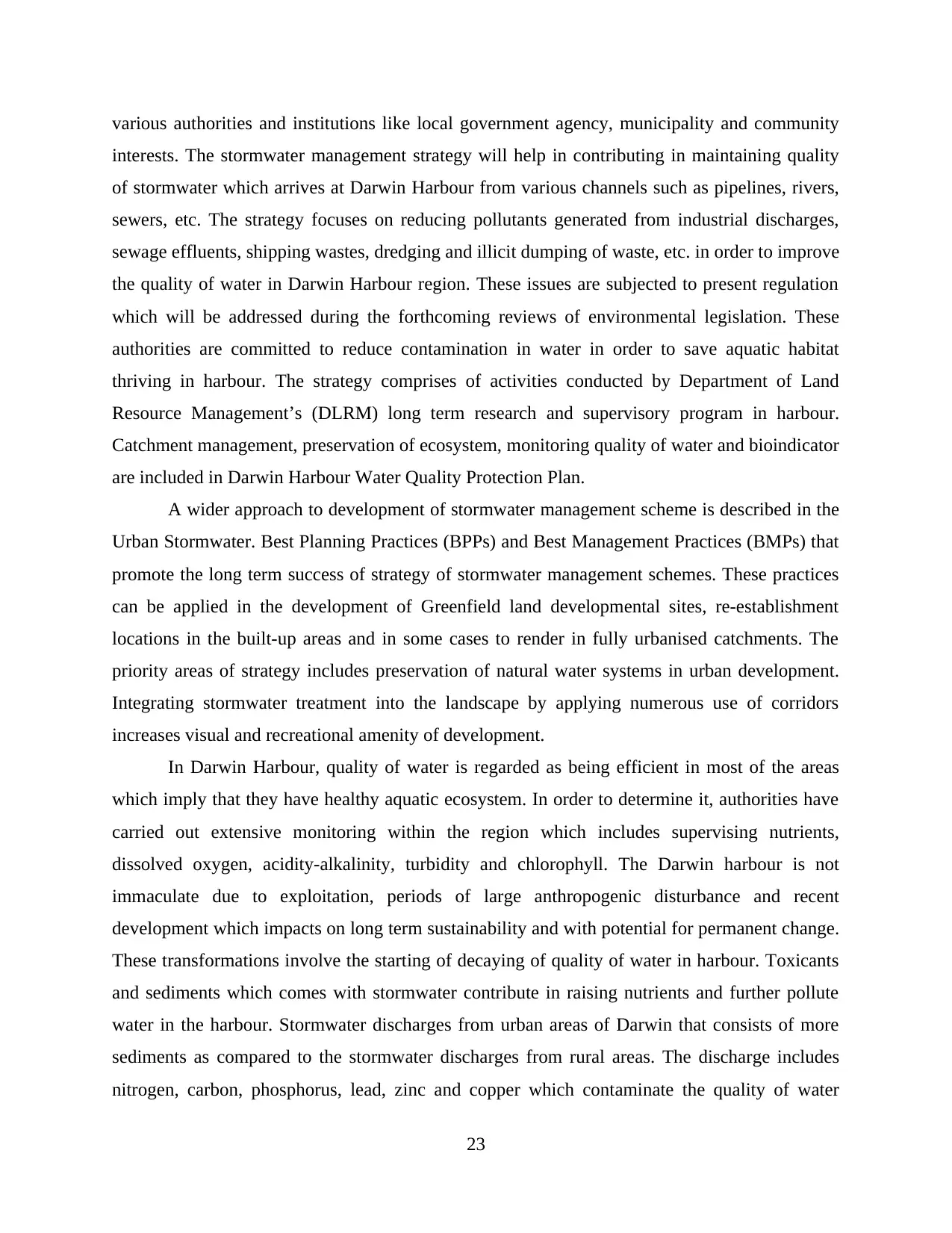
various authorities and institutions like local government agency, municipality and community
interests. The stormwater management strategy will help in contributing in maintaining quality
of stormwater which arrives at Darwin Harbour from various channels such as pipelines, rivers,
sewers, etc. The strategy focuses on reducing pollutants generated from industrial discharges,
sewage effluents, shipping wastes, dredging and illicit dumping of waste, etc. in order to improve
the quality of water in Darwin Harbour region. These issues are subjected to present regulation
which will be addressed during the forthcoming reviews of environmental legislation. These
authorities are committed to reduce contamination in water in order to save aquatic habitat
thriving in harbour. The strategy comprises of activities conducted by Department of Land
Resource Management’s (DLRM) long term research and supervisory program in harbour.
Catchment management, preservation of ecosystem, monitoring quality of water and bioindicator
are included in Darwin Harbour Water Quality Protection Plan.
A wider approach to development of stormwater management scheme is described in the
Urban Stormwater. Best Planning Practices (BPPs) and Best Management Practices (BMPs) that
promote the long term success of strategy of stormwater management schemes. These practices
can be applied in the development of Greenfield land developmental sites, re-establishment
locations in the built-up areas and in some cases to render in fully urbanised catchments. The
priority areas of strategy includes preservation of natural water systems in urban development.
Integrating stormwater treatment into the landscape by applying numerous use of corridors
increases visual and recreational amenity of development.
In Darwin Harbour, quality of water is regarded as being efficient in most of the areas
which imply that they have healthy aquatic ecosystem. In order to determine it, authorities have
carried out extensive monitoring within the region which includes supervising nutrients,
dissolved oxygen, acidity-alkalinity, turbidity and chlorophyll. The Darwin harbour is not
immaculate due to exploitation, periods of large anthropogenic disturbance and recent
development which impacts on long term sustainability and with potential for permanent change.
These transformations involve the starting of decaying of quality of water in harbour. Toxicants
and sediments which comes with stormwater contribute in raising nutrients and further pollute
water in the harbour. Stormwater discharges from urban areas of Darwin that consists of more
sediments as compared to the stormwater discharges from rural areas. The discharge includes
nitrogen, carbon, phosphorus, lead, zinc and copper which contaminate the quality of water
23
interests. The stormwater management strategy will help in contributing in maintaining quality
of stormwater which arrives at Darwin Harbour from various channels such as pipelines, rivers,
sewers, etc. The strategy focuses on reducing pollutants generated from industrial discharges,
sewage effluents, shipping wastes, dredging and illicit dumping of waste, etc. in order to improve
the quality of water in Darwin Harbour region. These issues are subjected to present regulation
which will be addressed during the forthcoming reviews of environmental legislation. These
authorities are committed to reduce contamination in water in order to save aquatic habitat
thriving in harbour. The strategy comprises of activities conducted by Department of Land
Resource Management’s (DLRM) long term research and supervisory program in harbour.
Catchment management, preservation of ecosystem, monitoring quality of water and bioindicator
are included in Darwin Harbour Water Quality Protection Plan.
A wider approach to development of stormwater management scheme is described in the
Urban Stormwater. Best Planning Practices (BPPs) and Best Management Practices (BMPs) that
promote the long term success of strategy of stormwater management schemes. These practices
can be applied in the development of Greenfield land developmental sites, re-establishment
locations in the built-up areas and in some cases to render in fully urbanised catchments. The
priority areas of strategy includes preservation of natural water systems in urban development.
Integrating stormwater treatment into the landscape by applying numerous use of corridors
increases visual and recreational amenity of development.
In Darwin Harbour, quality of water is regarded as being efficient in most of the areas
which imply that they have healthy aquatic ecosystem. In order to determine it, authorities have
carried out extensive monitoring within the region which includes supervising nutrients,
dissolved oxygen, acidity-alkalinity, turbidity and chlorophyll. The Darwin harbour is not
immaculate due to exploitation, periods of large anthropogenic disturbance and recent
development which impacts on long term sustainability and with potential for permanent change.
These transformations involve the starting of decaying of quality of water in harbour. Toxicants
and sediments which comes with stormwater contribute in raising nutrients and further pollute
water in the harbour. Stormwater discharges from urban areas of Darwin that consists of more
sediments as compared to the stormwater discharges from rural areas. The discharge includes
nitrogen, carbon, phosphorus, lead, zinc and copper which contaminate the quality of water
23
Paraphrase This Document
Need a fresh take? Get an instant paraphrase of this document with our AI Paraphraser
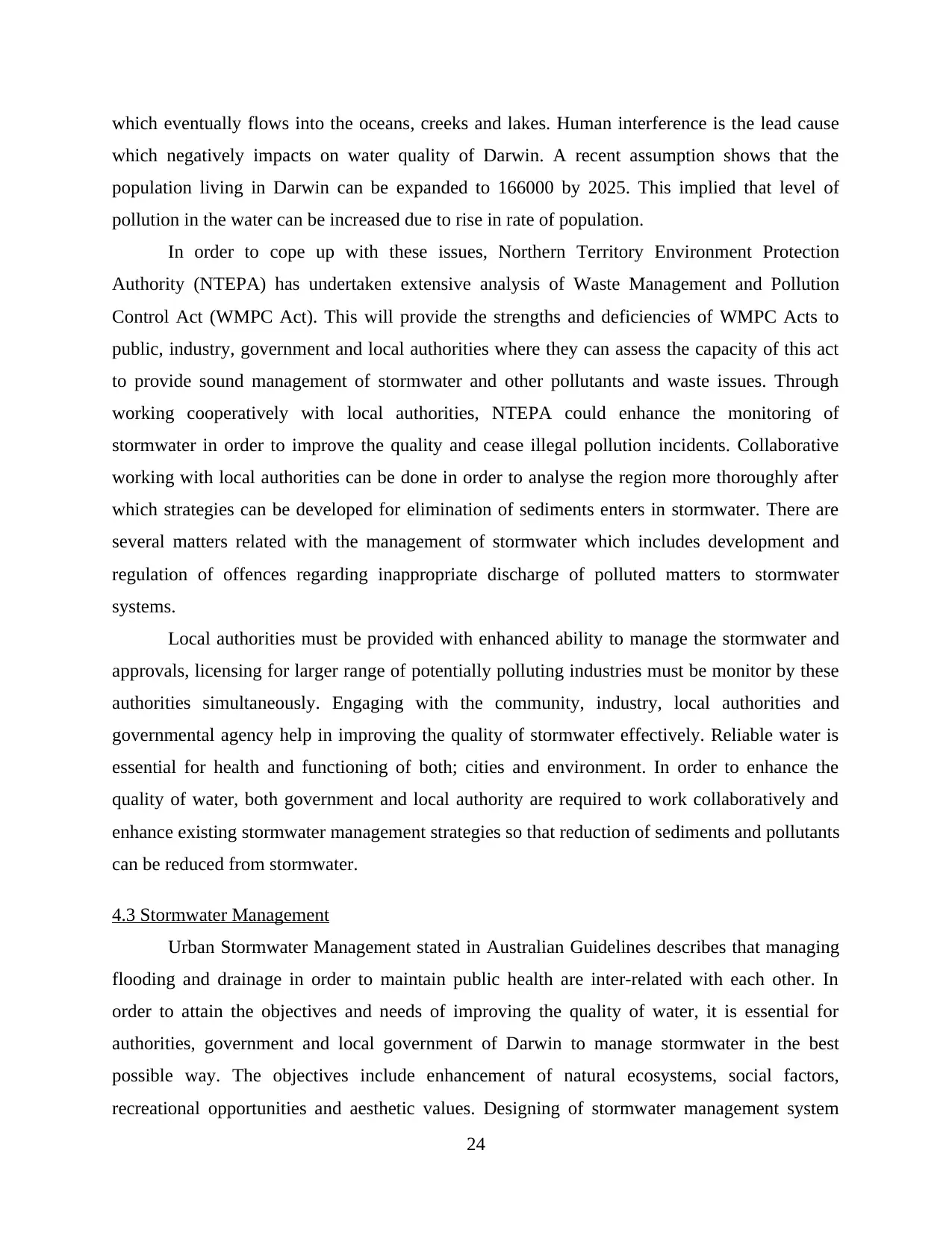
which eventually flows into the oceans, creeks and lakes. Human interference is the lead cause
which negatively impacts on water quality of Darwin. A recent assumption shows that the
population living in Darwin can be expanded to 166000 by 2025. This implied that level of
pollution in the water can be increased due to rise in rate of population.
In order to cope up with these issues, Northern Territory Environment Protection
Authority (NTEPA) has undertaken extensive analysis of Waste Management and Pollution
Control Act (WMPC Act). This will provide the strengths and deficiencies of WMPC Acts to
public, industry, government and local authorities where they can assess the capacity of this act
to provide sound management of stormwater and other pollutants and waste issues. Through
working cooperatively with local authorities, NTEPA could enhance the monitoring of
stormwater in order to improve the quality and cease illegal pollution incidents. Collaborative
working with local authorities can be done in order to analyse the region more thoroughly after
which strategies can be developed for elimination of sediments enters in stormwater. There are
several matters related with the management of stormwater which includes development and
regulation of offences regarding inappropriate discharge of polluted matters to stormwater
systems.
Local authorities must be provided with enhanced ability to manage the stormwater and
approvals, licensing for larger range of potentially polluting industries must be monitor by these
authorities simultaneously. Engaging with the community, industry, local authorities and
governmental agency help in improving the quality of stormwater effectively. Reliable water is
essential for health and functioning of both; cities and environment. In order to enhance the
quality of water, both government and local authority are required to work collaboratively and
enhance existing stormwater management strategies so that reduction of sediments and pollutants
can be reduced from stormwater.
4.3 Stormwater Management
Urban Stormwater Management stated in Australian Guidelines describes that managing
flooding and drainage in order to maintain public health are inter-related with each other. In
order to attain the objectives and needs of improving the quality of water, it is essential for
authorities, government and local government of Darwin to manage stormwater in the best
possible way. The objectives include enhancement of natural ecosystems, social factors,
recreational opportunities and aesthetic values. Designing of stormwater management system
24
which negatively impacts on water quality of Darwin. A recent assumption shows that the
population living in Darwin can be expanded to 166000 by 2025. This implied that level of
pollution in the water can be increased due to rise in rate of population.
In order to cope up with these issues, Northern Territory Environment Protection
Authority (NTEPA) has undertaken extensive analysis of Waste Management and Pollution
Control Act (WMPC Act). This will provide the strengths and deficiencies of WMPC Acts to
public, industry, government and local authorities where they can assess the capacity of this act
to provide sound management of stormwater and other pollutants and waste issues. Through
working cooperatively with local authorities, NTEPA could enhance the monitoring of
stormwater in order to improve the quality and cease illegal pollution incidents. Collaborative
working with local authorities can be done in order to analyse the region more thoroughly after
which strategies can be developed for elimination of sediments enters in stormwater. There are
several matters related with the management of stormwater which includes development and
regulation of offences regarding inappropriate discharge of polluted matters to stormwater
systems.
Local authorities must be provided with enhanced ability to manage the stormwater and
approvals, licensing for larger range of potentially polluting industries must be monitor by these
authorities simultaneously. Engaging with the community, industry, local authorities and
governmental agency help in improving the quality of stormwater effectively. Reliable water is
essential for health and functioning of both; cities and environment. In order to enhance the
quality of water, both government and local authority are required to work collaboratively and
enhance existing stormwater management strategies so that reduction of sediments and pollutants
can be reduced from stormwater.
4.3 Stormwater Management
Urban Stormwater Management stated in Australian Guidelines describes that managing
flooding and drainage in order to maintain public health are inter-related with each other. In
order to attain the objectives and needs of improving the quality of water, it is essential for
authorities, government and local government of Darwin to manage stormwater in the best
possible way. The objectives include enhancement of natural ecosystems, social factors,
recreational opportunities and aesthetic values. Designing of stormwater management system
24
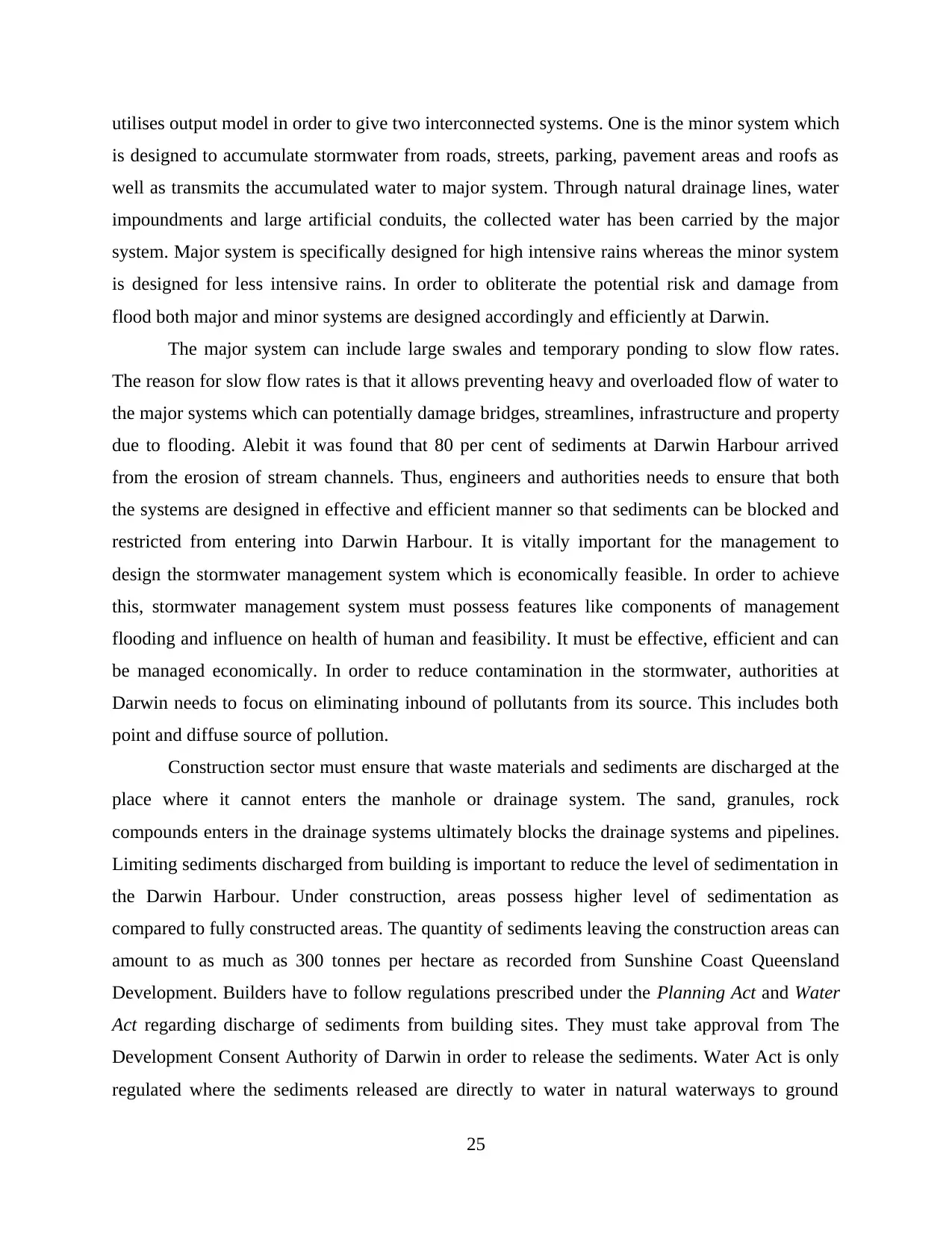
utilises output model in order to give two interconnected systems. One is the minor system which
is designed to accumulate stormwater from roads, streets, parking, pavement areas and roofs as
well as transmits the accumulated water to major system. Through natural drainage lines, water
impoundments and large artificial conduits, the collected water has been carried by the major
system. Major system is specifically designed for high intensive rains whereas the minor system
is designed for less intensive rains. In order to obliterate the potential risk and damage from
flood both major and minor systems are designed accordingly and efficiently at Darwin.
The major system can include large swales and temporary ponding to slow flow rates.
The reason for slow flow rates is that it allows preventing heavy and overloaded flow of water to
the major systems which can potentially damage bridges, streamlines, infrastructure and property
due to flooding. Alebit it was found that 80 per cent of sediments at Darwin Harbour arrived
from the erosion of stream channels. Thus, engineers and authorities needs to ensure that both
the systems are designed in effective and efficient manner so that sediments can be blocked and
restricted from entering into Darwin Harbour. It is vitally important for the management to
design the stormwater management system which is economically feasible. In order to achieve
this, stormwater management system must possess features like components of management
flooding and influence on health of human and feasibility. It must be effective, efficient and can
be managed economically. In order to reduce contamination in the stormwater, authorities at
Darwin needs to focus on eliminating inbound of pollutants from its source. This includes both
point and diffuse source of pollution.
Construction sector must ensure that waste materials and sediments are discharged at the
place where it cannot enters the manhole or drainage system. The sand, granules, rock
compounds enters in the drainage systems ultimately blocks the drainage systems and pipelines.
Limiting sediments discharged from building is important to reduce the level of sedimentation in
the Darwin Harbour. Under construction, areas possess higher level of sedimentation as
compared to fully constructed areas. The quantity of sediments leaving the construction areas can
amount to as much as 300 tonnes per hectare as recorded from Sunshine Coast Queensland
Development. Builders have to follow regulations prescribed under the Planning Act and Water
Act regarding discharge of sediments from building sites. They must take approval from The
Development Consent Authority of Darwin in order to release the sediments. Water Act is only
regulated where the sediments released are directly to water in natural waterways to ground
25
is designed to accumulate stormwater from roads, streets, parking, pavement areas and roofs as
well as transmits the accumulated water to major system. Through natural drainage lines, water
impoundments and large artificial conduits, the collected water has been carried by the major
system. Major system is specifically designed for high intensive rains whereas the minor system
is designed for less intensive rains. In order to obliterate the potential risk and damage from
flood both major and minor systems are designed accordingly and efficiently at Darwin.
The major system can include large swales and temporary ponding to slow flow rates.
The reason for slow flow rates is that it allows preventing heavy and overloaded flow of water to
the major systems which can potentially damage bridges, streamlines, infrastructure and property
due to flooding. Alebit it was found that 80 per cent of sediments at Darwin Harbour arrived
from the erosion of stream channels. Thus, engineers and authorities needs to ensure that both
the systems are designed in effective and efficient manner so that sediments can be blocked and
restricted from entering into Darwin Harbour. It is vitally important for the management to
design the stormwater management system which is economically feasible. In order to achieve
this, stormwater management system must possess features like components of management
flooding and influence on health of human and feasibility. It must be effective, efficient and can
be managed economically. In order to reduce contamination in the stormwater, authorities at
Darwin needs to focus on eliminating inbound of pollutants from its source. This includes both
point and diffuse source of pollution.
Construction sector must ensure that waste materials and sediments are discharged at the
place where it cannot enters the manhole or drainage system. The sand, granules, rock
compounds enters in the drainage systems ultimately blocks the drainage systems and pipelines.
Limiting sediments discharged from building is important to reduce the level of sedimentation in
the Darwin Harbour. Under construction, areas possess higher level of sedimentation as
compared to fully constructed areas. The quantity of sediments leaving the construction areas can
amount to as much as 300 tonnes per hectare as recorded from Sunshine Coast Queensland
Development. Builders have to follow regulations prescribed under the Planning Act and Water
Act regarding discharge of sediments from building sites. They must take approval from The
Development Consent Authority of Darwin in order to release the sediments. Water Act is only
regulated where the sediments released are directly to water in natural waterways to ground
25
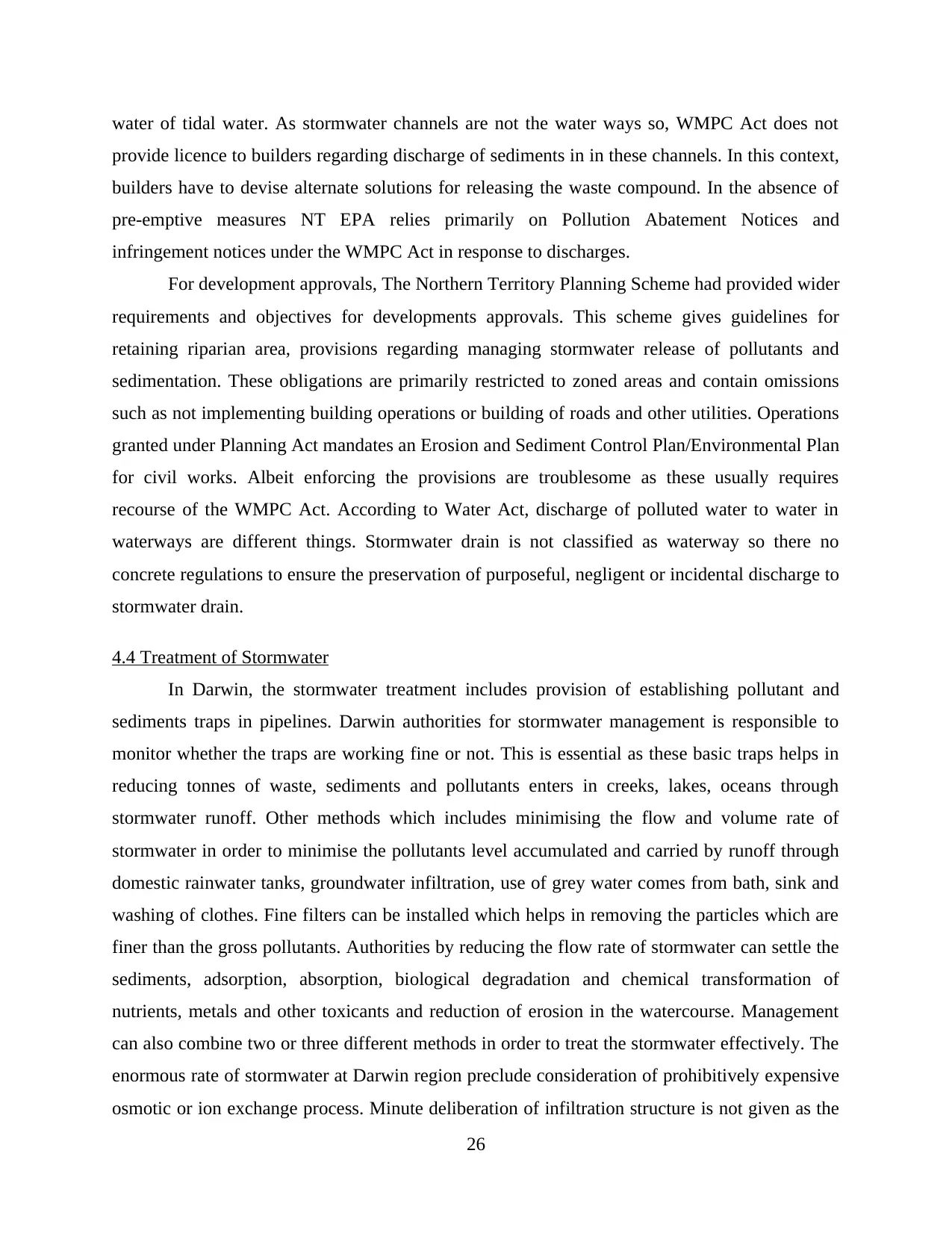
water of tidal water. As stormwater channels are not the water ways so, WMPC Act does not
provide licence to builders regarding discharge of sediments in in these channels. In this context,
builders have to devise alternate solutions for releasing the waste compound. In the absence of
pre-emptive measures NT EPA relies primarily on Pollution Abatement Notices and
infringement notices under the WMPC Act in response to discharges.
For development approvals, The Northern Territory Planning Scheme had provided wider
requirements and objectives for developments approvals. This scheme gives guidelines for
retaining riparian area, provisions regarding managing stormwater release of pollutants and
sedimentation. These obligations are primarily restricted to zoned areas and contain omissions
such as not implementing building operations or building of roads and other utilities. Operations
granted under Planning Act mandates an Erosion and Sediment Control Plan/Environmental Plan
for civil works. Albeit enforcing the provisions are troublesome as these usually requires
recourse of the WMPC Act. According to Water Act, discharge of polluted water to water in
waterways are different things. Stormwater drain is not classified as waterway so there no
concrete regulations to ensure the preservation of purposeful, negligent or incidental discharge to
stormwater drain.
4.4 Treatment of Stormwater
In Darwin, the stormwater treatment includes provision of establishing pollutant and
sediments traps in pipelines. Darwin authorities for stormwater management is responsible to
monitor whether the traps are working fine or not. This is essential as these basic traps helps in
reducing tonnes of waste, sediments and pollutants enters in creeks, lakes, oceans through
stormwater runoff. Other methods which includes minimising the flow and volume rate of
stormwater in order to minimise the pollutants level accumulated and carried by runoff through
domestic rainwater tanks, groundwater infiltration, use of grey water comes from bath, sink and
washing of clothes. Fine filters can be installed which helps in removing the particles which are
finer than the gross pollutants. Authorities by reducing the flow rate of stormwater can settle the
sediments, adsorption, absorption, biological degradation and chemical transformation of
nutrients, metals and other toxicants and reduction of erosion in the watercourse. Management
can also combine two or three different methods in order to treat the stormwater effectively. The
enormous rate of stormwater at Darwin region preclude consideration of prohibitively expensive
osmotic or ion exchange process. Minute deliberation of infiltration structure is not given as the
26
provide licence to builders regarding discharge of sediments in in these channels. In this context,
builders have to devise alternate solutions for releasing the waste compound. In the absence of
pre-emptive measures NT EPA relies primarily on Pollution Abatement Notices and
infringement notices under the WMPC Act in response to discharges.
For development approvals, The Northern Territory Planning Scheme had provided wider
requirements and objectives for developments approvals. This scheme gives guidelines for
retaining riparian area, provisions regarding managing stormwater release of pollutants and
sedimentation. These obligations are primarily restricted to zoned areas and contain omissions
such as not implementing building operations or building of roads and other utilities. Operations
granted under Planning Act mandates an Erosion and Sediment Control Plan/Environmental Plan
for civil works. Albeit enforcing the provisions are troublesome as these usually requires
recourse of the WMPC Act. According to Water Act, discharge of polluted water to water in
waterways are different things. Stormwater drain is not classified as waterway so there no
concrete regulations to ensure the preservation of purposeful, negligent or incidental discharge to
stormwater drain.
4.4 Treatment of Stormwater
In Darwin, the stormwater treatment includes provision of establishing pollutant and
sediments traps in pipelines. Darwin authorities for stormwater management is responsible to
monitor whether the traps are working fine or not. This is essential as these basic traps helps in
reducing tonnes of waste, sediments and pollutants enters in creeks, lakes, oceans through
stormwater runoff. Other methods which includes minimising the flow and volume rate of
stormwater in order to minimise the pollutants level accumulated and carried by runoff through
domestic rainwater tanks, groundwater infiltration, use of grey water comes from bath, sink and
washing of clothes. Fine filters can be installed which helps in removing the particles which are
finer than the gross pollutants. Authorities by reducing the flow rate of stormwater can settle the
sediments, adsorption, absorption, biological degradation and chemical transformation of
nutrients, metals and other toxicants and reduction of erosion in the watercourse. Management
can also combine two or three different methods in order to treat the stormwater effectively. The
enormous rate of stormwater at Darwin region preclude consideration of prohibitively expensive
osmotic or ion exchange process. Minute deliberation of infiltration structure is not given as the
26
Secure Best Marks with AI Grader
Need help grading? Try our AI Grader for instant feedback on your assignments.
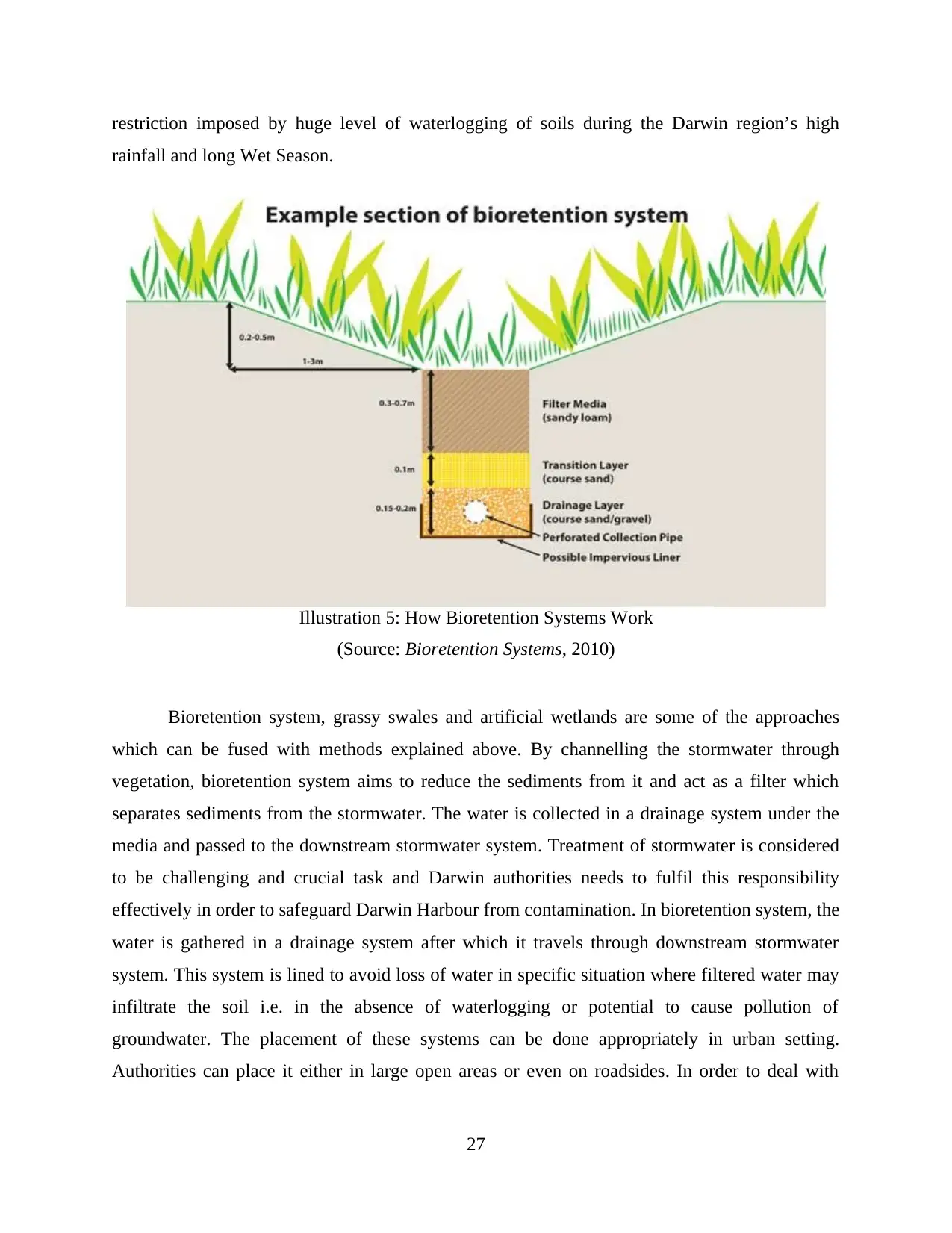
restriction imposed by huge level of waterlogging of soils during the Darwin region’s high
rainfall and long Wet Season.
Bioretention system, grassy swales and artificial wetlands are some of the approaches
which can be fused with methods explained above. By channelling the stormwater through
vegetation, bioretention system aims to reduce the sediments from it and act as a filter which
separates sediments from the stormwater. The water is collected in a drainage system under the
media and passed to the downstream stormwater system. Treatment of stormwater is considered
to be challenging and crucial task and Darwin authorities needs to fulfil this responsibility
effectively in order to safeguard Darwin Harbour from contamination. In bioretention system, the
water is gathered in a drainage system after which it travels through downstream stormwater
system. This system is lined to avoid loss of water in specific situation where filtered water may
infiltrate the soil i.e. in the absence of waterlogging or potential to cause pollution of
groundwater. The placement of these systems can be done appropriately in urban setting.
Authorities can place it either in large open areas or even on roadsides. In order to deal with
27
Illustration 5: How Bioretention Systems Work
(Source: Bioretention Systems, 2010)
rainfall and long Wet Season.
Bioretention system, grassy swales and artificial wetlands are some of the approaches
which can be fused with methods explained above. By channelling the stormwater through
vegetation, bioretention system aims to reduce the sediments from it and act as a filter which
separates sediments from the stormwater. The water is collected in a drainage system under the
media and passed to the downstream stormwater system. Treatment of stormwater is considered
to be challenging and crucial task and Darwin authorities needs to fulfil this responsibility
effectively in order to safeguard Darwin Harbour from contamination. In bioretention system, the
water is gathered in a drainage system after which it travels through downstream stormwater
system. This system is lined to avoid loss of water in specific situation where filtered water may
infiltrate the soil i.e. in the absence of waterlogging or potential to cause pollution of
groundwater. The placement of these systems can be done appropriately in urban setting.
Authorities can place it either in large open areas or even on roadsides. In order to deal with
27
Illustration 5: How Bioretention Systems Work
(Source: Bioretention Systems, 2010)
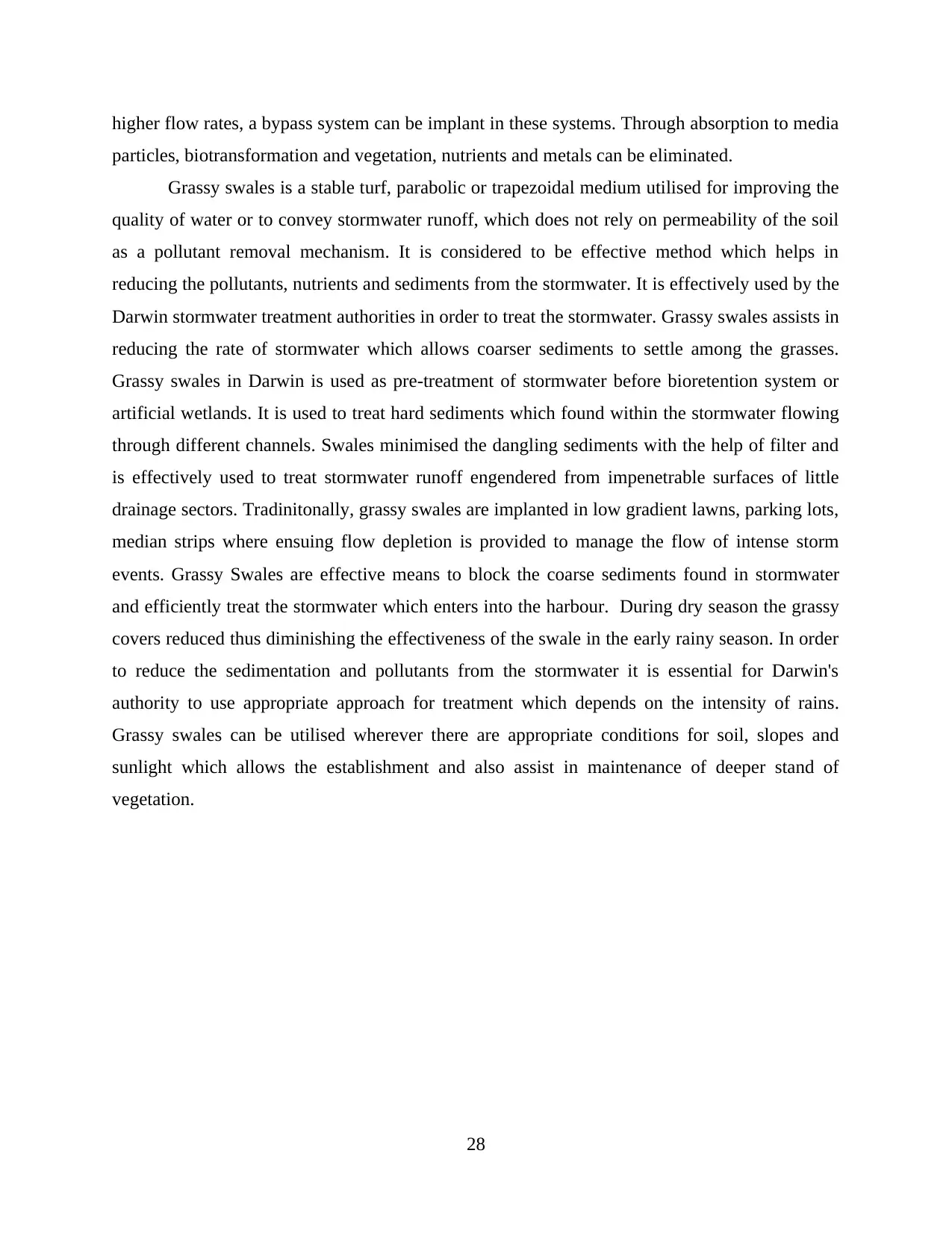
higher flow rates, a bypass system can be implant in these systems. Through absorption to media
particles, biotransformation and vegetation, nutrients and metals can be eliminated.
Grassy swales is a stable turf, parabolic or trapezoidal medium utilised for improving the
quality of water or to convey stormwater runoff, which does not rely on permeability of the soil
as a pollutant removal mechanism. It is considered to be effective method which helps in
reducing the pollutants, nutrients and sediments from the stormwater. It is effectively used by the
Darwin stormwater treatment authorities in order to treat the stormwater. Grassy swales assists in
reducing the rate of stormwater which allows coarser sediments to settle among the grasses.
Grassy swales in Darwin is used as pre-treatment of stormwater before bioretention system or
artificial wetlands. It is used to treat hard sediments which found within the stormwater flowing
through different channels. Swales minimised the dangling sediments with the help of filter and
is effectively used to treat stormwater runoff engendered from impenetrable surfaces of little
drainage sectors. Tradinitonally, grassy swales are implanted in low gradient lawns, parking lots,
median strips where ensuing flow depletion is provided to manage the flow of intense storm
events. Grassy Swales are effective means to block the coarse sediments found in stormwater
and efficiently treat the stormwater which enters into the harbour. During dry season the grassy
covers reduced thus diminishing the effectiveness of the swale in the early rainy season. In order
to reduce the sedimentation and pollutants from the stormwater it is essential for Darwin's
authority to use appropriate approach for treatment which depends on the intensity of rains.
Grassy swales can be utilised wherever there are appropriate conditions for soil, slopes and
sunlight which allows the establishment and also assist in maintenance of deeper stand of
vegetation.
28
particles, biotransformation and vegetation, nutrients and metals can be eliminated.
Grassy swales is a stable turf, parabolic or trapezoidal medium utilised for improving the
quality of water or to convey stormwater runoff, which does not rely on permeability of the soil
as a pollutant removal mechanism. It is considered to be effective method which helps in
reducing the pollutants, nutrients and sediments from the stormwater. It is effectively used by the
Darwin stormwater treatment authorities in order to treat the stormwater. Grassy swales assists in
reducing the rate of stormwater which allows coarser sediments to settle among the grasses.
Grassy swales in Darwin is used as pre-treatment of stormwater before bioretention system or
artificial wetlands. It is used to treat hard sediments which found within the stormwater flowing
through different channels. Swales minimised the dangling sediments with the help of filter and
is effectively used to treat stormwater runoff engendered from impenetrable surfaces of little
drainage sectors. Tradinitonally, grassy swales are implanted in low gradient lawns, parking lots,
median strips where ensuing flow depletion is provided to manage the flow of intense storm
events. Grassy Swales are effective means to block the coarse sediments found in stormwater
and efficiently treat the stormwater which enters into the harbour. During dry season the grassy
covers reduced thus diminishing the effectiveness of the swale in the early rainy season. In order
to reduce the sedimentation and pollutants from the stormwater it is essential for Darwin's
authority to use appropriate approach for treatment which depends on the intensity of rains.
Grassy swales can be utilised wherever there are appropriate conditions for soil, slopes and
sunlight which allows the establishment and also assist in maintenance of deeper stand of
vegetation.
28
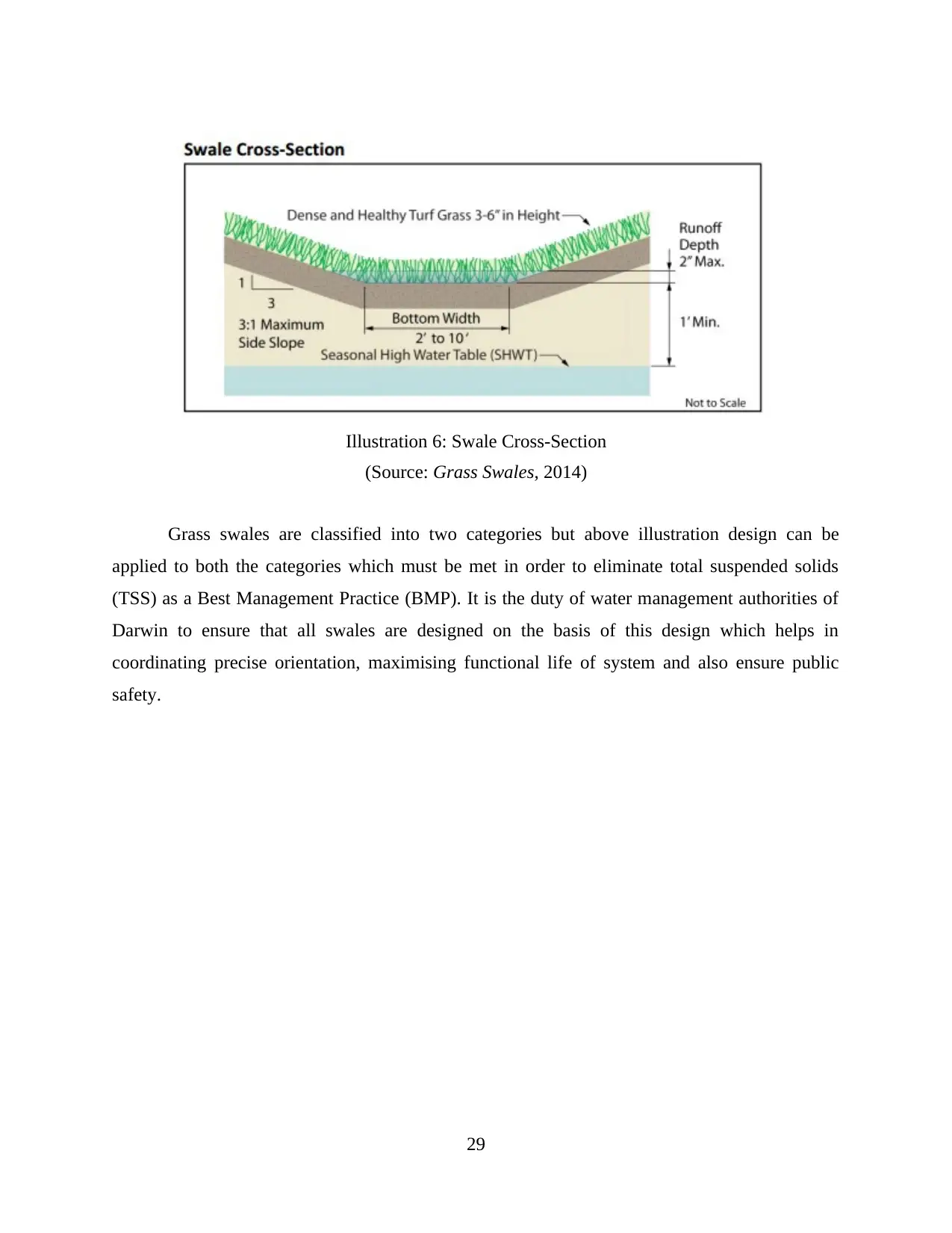
Grass swales are classified into two categories but above illustration design can be
applied to both the categories which must be met in order to eliminate total suspended solids
(TSS) as a Best Management Practice (BMP). It is the duty of water management authorities of
Darwin to ensure that all swales are designed on the basis of this design which helps in
coordinating precise orientation, maximising functional life of system and also ensure public
safety.
29
Illustration 6: Swale Cross-Section
(Source: Grass Swales, 2014)
applied to both the categories which must be met in order to eliminate total suspended solids
(TSS) as a Best Management Practice (BMP). It is the duty of water management authorities of
Darwin to ensure that all swales are designed on the basis of this design which helps in
coordinating precise orientation, maximising functional life of system and also ensure public
safety.
29
Illustration 6: Swale Cross-Section
(Source: Grass Swales, 2014)
Paraphrase This Document
Need a fresh take? Get an instant paraphrase of this document with our AI Paraphraser
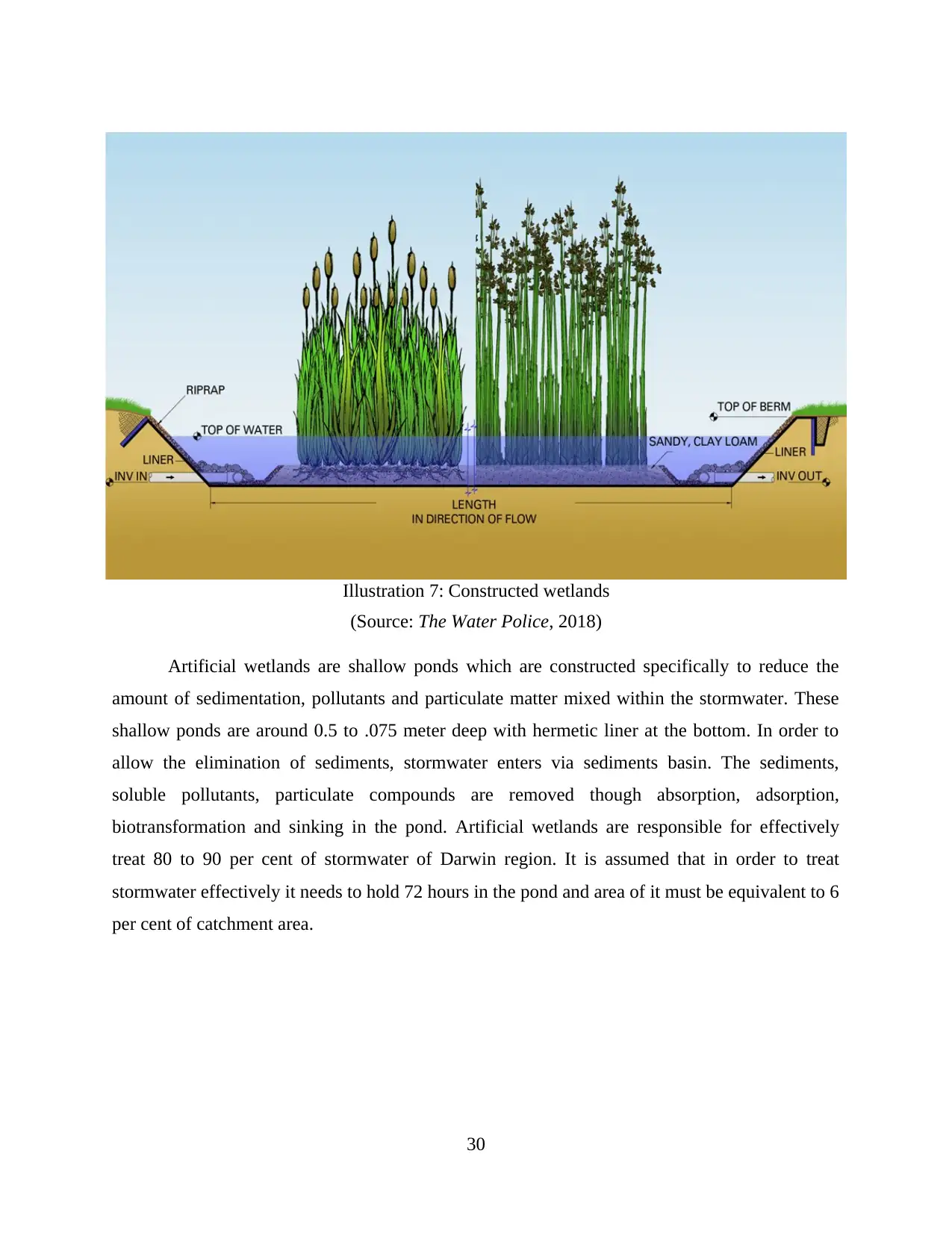
Artificial wetlands are shallow ponds which are constructed specifically to reduce the
amount of sedimentation, pollutants and particulate matter mixed within the stormwater. These
shallow ponds are around 0.5 to .075 meter deep with hermetic liner at the bottom. In order to
allow the elimination of sediments, stormwater enters via sediments basin. The sediments,
soluble pollutants, particulate compounds are removed though absorption, adsorption,
biotransformation and sinking in the pond. Artificial wetlands are responsible for effectively
treat 80 to 90 per cent of stormwater of Darwin region. It is assumed that in order to treat
stormwater effectively it needs to hold 72 hours in the pond and area of it must be equivalent to 6
per cent of catchment area.
30
Illustration 7: Constructed wetlands
(Source: The Water Police, 2018)
amount of sedimentation, pollutants and particulate matter mixed within the stormwater. These
shallow ponds are around 0.5 to .075 meter deep with hermetic liner at the bottom. In order to
allow the elimination of sediments, stormwater enters via sediments basin. The sediments,
soluble pollutants, particulate compounds are removed though absorption, adsorption,
biotransformation and sinking in the pond. Artificial wetlands are responsible for effectively
treat 80 to 90 per cent of stormwater of Darwin region. It is assumed that in order to treat
stormwater effectively it needs to hold 72 hours in the pond and area of it must be equivalent to 6
per cent of catchment area.
30
Illustration 7: Constructed wetlands
(Source: The Water Police, 2018)
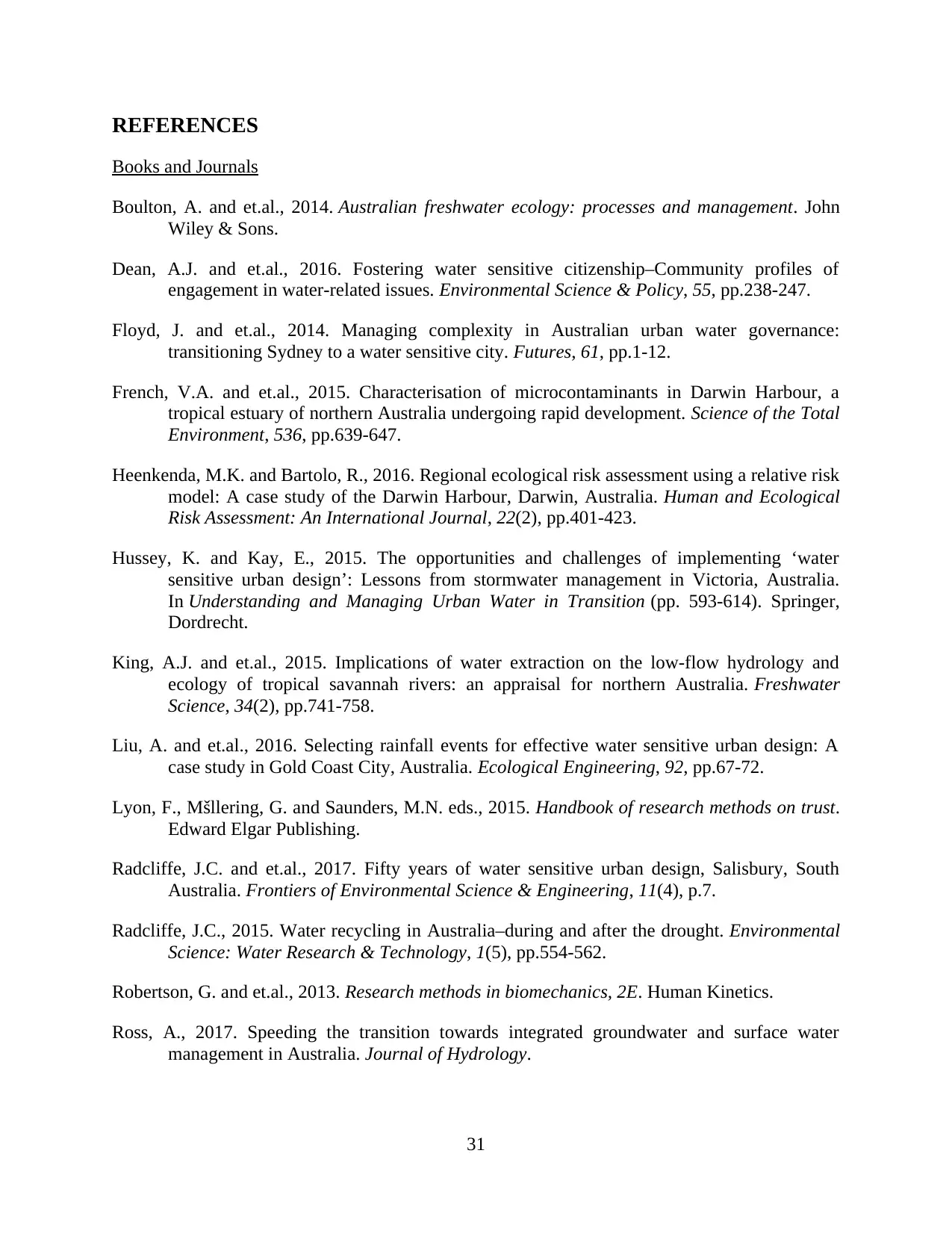
REFERENCES
Books and Journals
Boulton, A. and et.al., 2014. Australian freshwater ecology: processes and management. John
Wiley & Sons.
Dean, A.J. and et.al., 2016. Fostering water sensitive citizenship–Community profiles of
engagement in water-related issues. Environmental Science & Policy, 55, pp.238-247.
Floyd, J. and et.al., 2014. Managing complexity in Australian urban water governance:
transitioning Sydney to a water sensitive city. Futures, 61, pp.1-12.
French, V.A. and et.al., 2015. Characterisation of microcontaminants in Darwin Harbour, a
tropical estuary of northern Australia undergoing rapid development. Science of the Total
Environment, 536, pp.639-647.
Heenkenda, M.K. and Bartolo, R., 2016. Regional ecological risk assessment using a relative risk
model: A case study of the Darwin Harbour, Darwin, Australia. Human and Ecological
Risk Assessment: An International Journal, 22(2), pp.401-423.
Hussey, K. and Kay, E., 2015. The opportunities and challenges of implementing ‘water
sensitive urban design’: Lessons from stormwater management in Victoria, Australia.
In Understanding and Managing Urban Water in Transition (pp. 593-614). Springer,
Dordrecht.
King, A.J. and et.al., 2015. Implications of water extraction on the low-flow hydrology and
ecology of tropical savannah rivers: an appraisal for northern Australia. Freshwater
Science, 34(2), pp.741-758.
Liu, A. and et.al., 2016. Selecting rainfall events for effective water sensitive urban design: A
case study in Gold Coast City, Australia. Ecological Engineering, 92, pp.67-72.
Lyon, F., Mšllering, G. and Saunders, M.N. eds., 2015. Handbook of research methods on trust.
Edward Elgar Publishing.
Radcliffe, J.C. and et.al., 2017. Fifty years of water sensitive urban design, Salisbury, South
Australia. Frontiers of Environmental Science & Engineering, 11(4), p.7.
Radcliffe, J.C., 2015. Water recycling in Australia–during and after the drought. Environmental
Science: Water Research & Technology, 1(5), pp.554-562.
Robertson, G. and et.al., 2013. Research methods in biomechanics, 2E. Human Kinetics.
Ross, A., 2017. Speeding the transition towards integrated groundwater and surface water
management in Australia. Journal of Hydrology.
31
Books and Journals
Boulton, A. and et.al., 2014. Australian freshwater ecology: processes and management. John
Wiley & Sons.
Dean, A.J. and et.al., 2016. Fostering water sensitive citizenship–Community profiles of
engagement in water-related issues. Environmental Science & Policy, 55, pp.238-247.
Floyd, J. and et.al., 2014. Managing complexity in Australian urban water governance:
transitioning Sydney to a water sensitive city. Futures, 61, pp.1-12.
French, V.A. and et.al., 2015. Characterisation of microcontaminants in Darwin Harbour, a
tropical estuary of northern Australia undergoing rapid development. Science of the Total
Environment, 536, pp.639-647.
Heenkenda, M.K. and Bartolo, R., 2016. Regional ecological risk assessment using a relative risk
model: A case study of the Darwin Harbour, Darwin, Australia. Human and Ecological
Risk Assessment: An International Journal, 22(2), pp.401-423.
Hussey, K. and Kay, E., 2015. The opportunities and challenges of implementing ‘water
sensitive urban design’: Lessons from stormwater management in Victoria, Australia.
In Understanding and Managing Urban Water in Transition (pp. 593-614). Springer,
Dordrecht.
King, A.J. and et.al., 2015. Implications of water extraction on the low-flow hydrology and
ecology of tropical savannah rivers: an appraisal for northern Australia. Freshwater
Science, 34(2), pp.741-758.
Liu, A. and et.al., 2016. Selecting rainfall events for effective water sensitive urban design: A
case study in Gold Coast City, Australia. Ecological Engineering, 92, pp.67-72.
Lyon, F., Mšllering, G. and Saunders, M.N. eds., 2015. Handbook of research methods on trust.
Edward Elgar Publishing.
Radcliffe, J.C. and et.al., 2017. Fifty years of water sensitive urban design, Salisbury, South
Australia. Frontiers of Environmental Science & Engineering, 11(4), p.7.
Radcliffe, J.C., 2015. Water recycling in Australia–during and after the drought. Environmental
Science: Water Research & Technology, 1(5), pp.554-562.
Robertson, G. and et.al., 2013. Research methods in biomechanics, 2E. Human Kinetics.
Ross, A., 2017. Speeding the transition towards integrated groundwater and surface water
management in Australia. Journal of Hydrology.
31
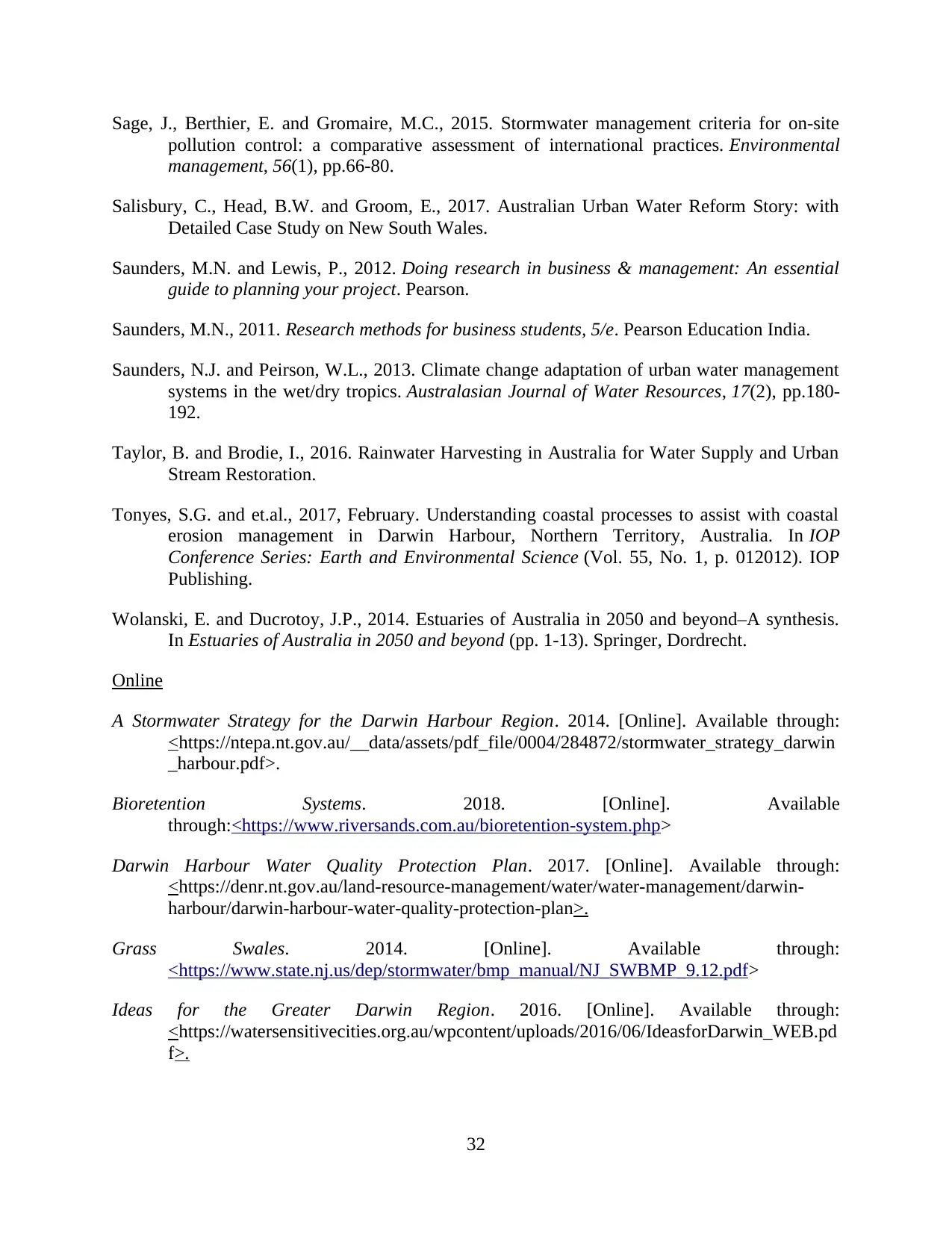
Sage, J., Berthier, E. and Gromaire, M.C., 2015. Stormwater management criteria for on-site
pollution control: a comparative assessment of international practices. Environmental
management, 56(1), pp.66-80.
Salisbury, C., Head, B.W. and Groom, E., 2017. Australian Urban Water Reform Story: with
Detailed Case Study on New South Wales.
Saunders, M.N. and Lewis, P., 2012. Doing research in business & management: An essential
guide to planning your project. Pearson.
Saunders, M.N., 2011. Research methods for business students, 5/e. Pearson Education India.
Saunders, N.J. and Peirson, W.L., 2013. Climate change adaptation of urban water management
systems in the wet/dry tropics. Australasian Journal of Water Resources, 17(2), pp.180-
192.
Taylor, B. and Brodie, I., 2016. Rainwater Harvesting in Australia for Water Supply and Urban
Stream Restoration.
Tonyes, S.G. and et.al., 2017, February. Understanding coastal processes to assist with coastal
erosion management in Darwin Harbour, Northern Territory, Australia. In IOP
Conference Series: Earth and Environmental Science (Vol. 55, No. 1, p. 012012). IOP
Publishing.
Wolanski, E. and Ducrotoy, J.P., 2014. Estuaries of Australia in 2050 and beyond–A synthesis.
In Estuaries of Australia in 2050 and beyond (pp. 1-13). Springer, Dordrecht.
Online
A Stormwater Strategy for the Darwin Harbour Region. 2014. [Online]. Available through:
<https://ntepa.nt.gov.au/__data/assets/pdf_file/0004/284872/stormwater_strategy_darwin
_harbour.pdf>.
Bioretention Systems. 2018. [Online]. Available
through:<https://www.riversands.com.au/bioretention-system.php>
Darwin Harbour Water Quality Protection Plan. 2017. [Online]. Available through:
<https://denr.nt.gov.au/land-resource-management/water/water-management/darwin-
harbour/darwin-harbour-water-quality-protection-plan>.
Grass Swales. 2014. [Online]. Available through:
<https://www.state.nj.us/dep/stormwater/bmp_manual/NJ_SWBMP_9.12.pdf>
Ideas for the Greater Darwin Region. 2016. [Online]. Available through:
<https://watersensitivecities.org.au/wpcontent/uploads/2016/06/IdeasforDarwin_WEB.pd
f>.
32
pollution control: a comparative assessment of international practices. Environmental
management, 56(1), pp.66-80.
Salisbury, C., Head, B.W. and Groom, E., 2017. Australian Urban Water Reform Story: with
Detailed Case Study on New South Wales.
Saunders, M.N. and Lewis, P., 2012. Doing research in business & management: An essential
guide to planning your project. Pearson.
Saunders, M.N., 2011. Research methods for business students, 5/e. Pearson Education India.
Saunders, N.J. and Peirson, W.L., 2013. Climate change adaptation of urban water management
systems in the wet/dry tropics. Australasian Journal of Water Resources, 17(2), pp.180-
192.
Taylor, B. and Brodie, I., 2016. Rainwater Harvesting in Australia for Water Supply and Urban
Stream Restoration.
Tonyes, S.G. and et.al., 2017, February. Understanding coastal processes to assist with coastal
erosion management in Darwin Harbour, Northern Territory, Australia. In IOP
Conference Series: Earth and Environmental Science (Vol. 55, No. 1, p. 012012). IOP
Publishing.
Wolanski, E. and Ducrotoy, J.P., 2014. Estuaries of Australia in 2050 and beyond–A synthesis.
In Estuaries of Australia in 2050 and beyond (pp. 1-13). Springer, Dordrecht.
Online
A Stormwater Strategy for the Darwin Harbour Region. 2014. [Online]. Available through:
<https://ntepa.nt.gov.au/__data/assets/pdf_file/0004/284872/stormwater_strategy_darwin
_harbour.pdf>.
Bioretention Systems. 2018. [Online]. Available
through:<https://www.riversands.com.au/bioretention-system.php>
Darwin Harbour Water Quality Protection Plan. 2017. [Online]. Available through:
<https://denr.nt.gov.au/land-resource-management/water/water-management/darwin-
harbour/darwin-harbour-water-quality-protection-plan>.
Grass Swales. 2014. [Online]. Available through:
<https://www.state.nj.us/dep/stormwater/bmp_manual/NJ_SWBMP_9.12.pdf>
Ideas for the Greater Darwin Region. 2016. [Online]. Available through:
<https://watersensitivecities.org.au/wpcontent/uploads/2016/06/IdeasforDarwin_WEB.pd
f>.
32
Secure Best Marks with AI Grader
Need help grading? Try our AI Grader for instant feedback on your assignments.
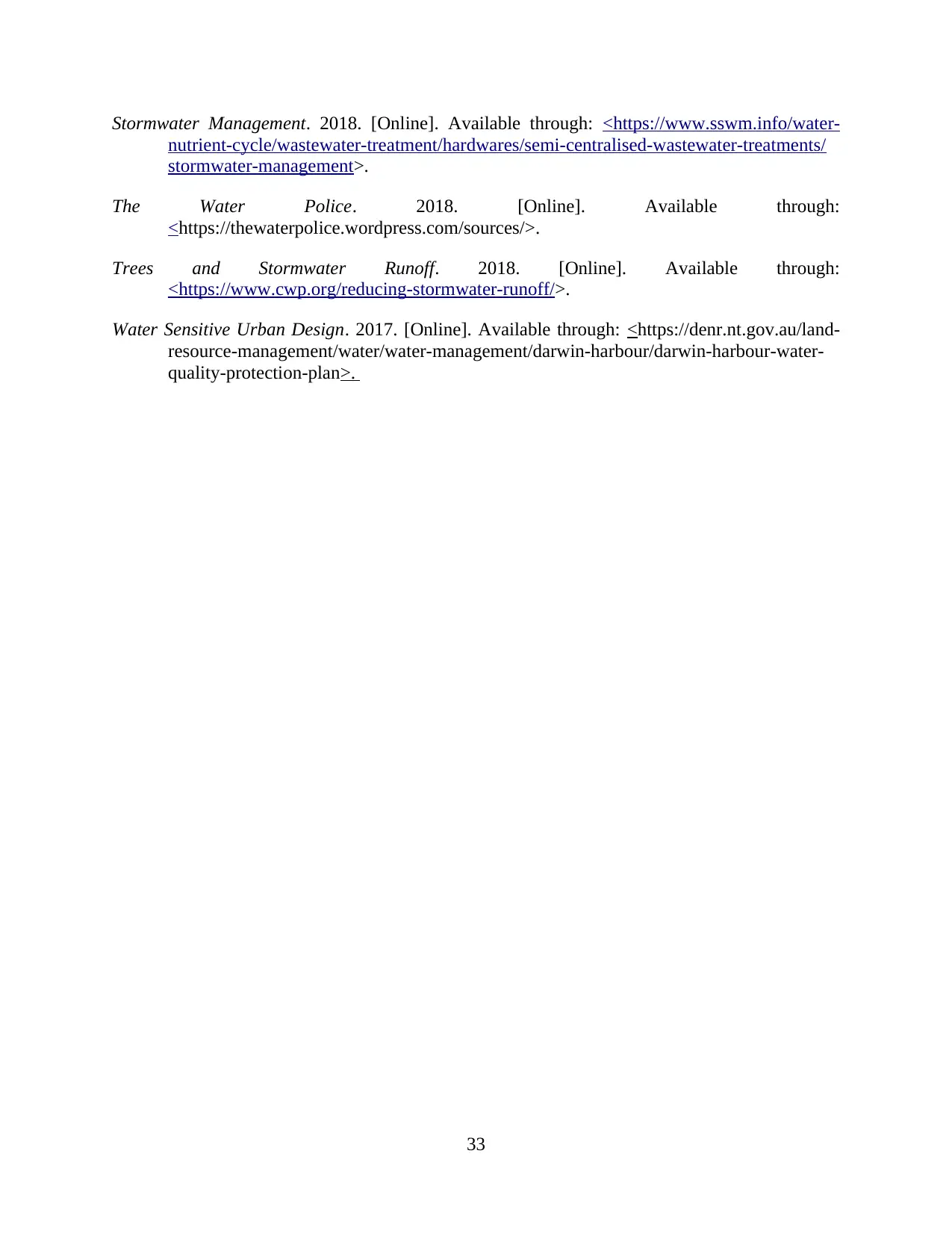
Stormwater Management. 2018. [Online]. Available through: <https://www.sswm.info/water-
nutrient-cycle/wastewater-treatment/hardwares/semi-centralised-wastewater-treatments/
stormwater-management>.
The Water Police. 2018. [Online]. Available through:
<https://thewaterpolice.wordpress.com/sources/>.
Trees and Stormwater Runoff. 2018. [Online]. Available through:
<https://www.cwp.org/reducing-stormwater-runoff/>.
Water Sensitive Urban Design. 2017. [Online]. Available through: <https://denr.nt.gov.au/land-
resource-management/water/water-management/darwin-harbour/darwin-harbour-water-
quality-protection-plan>.
33
nutrient-cycle/wastewater-treatment/hardwares/semi-centralised-wastewater-treatments/
stormwater-management>.
The Water Police. 2018. [Online]. Available through:
<https://thewaterpolice.wordpress.com/sources/>.
Trees and Stormwater Runoff. 2018. [Online]. Available through:
<https://www.cwp.org/reducing-stormwater-runoff/>.
Water Sensitive Urban Design. 2017. [Online]. Available through: <https://denr.nt.gov.au/land-
resource-management/water/water-management/darwin-harbour/darwin-harbour-water-
quality-protection-plan>.
33
1 out of 35
Your All-in-One AI-Powered Toolkit for Academic Success.
+13062052269
info@desklib.com
Available 24*7 on WhatsApp / Email
![[object Object]](/_next/static/media/star-bottom.7253800d.svg)
Unlock your academic potential
© 2024 | Zucol Services PVT LTD | All rights reserved.

